Technicolor Delivery Technologies Belgium TG670 TG670 Wireless Residential VoIP Gateway User Manual TG789vn SetupUserGuide en
Technicolor Delivery Technologies Belgium TG670 Wireless Residential VoIP Gateway TG789vn SetupUserGuide en
User Manual
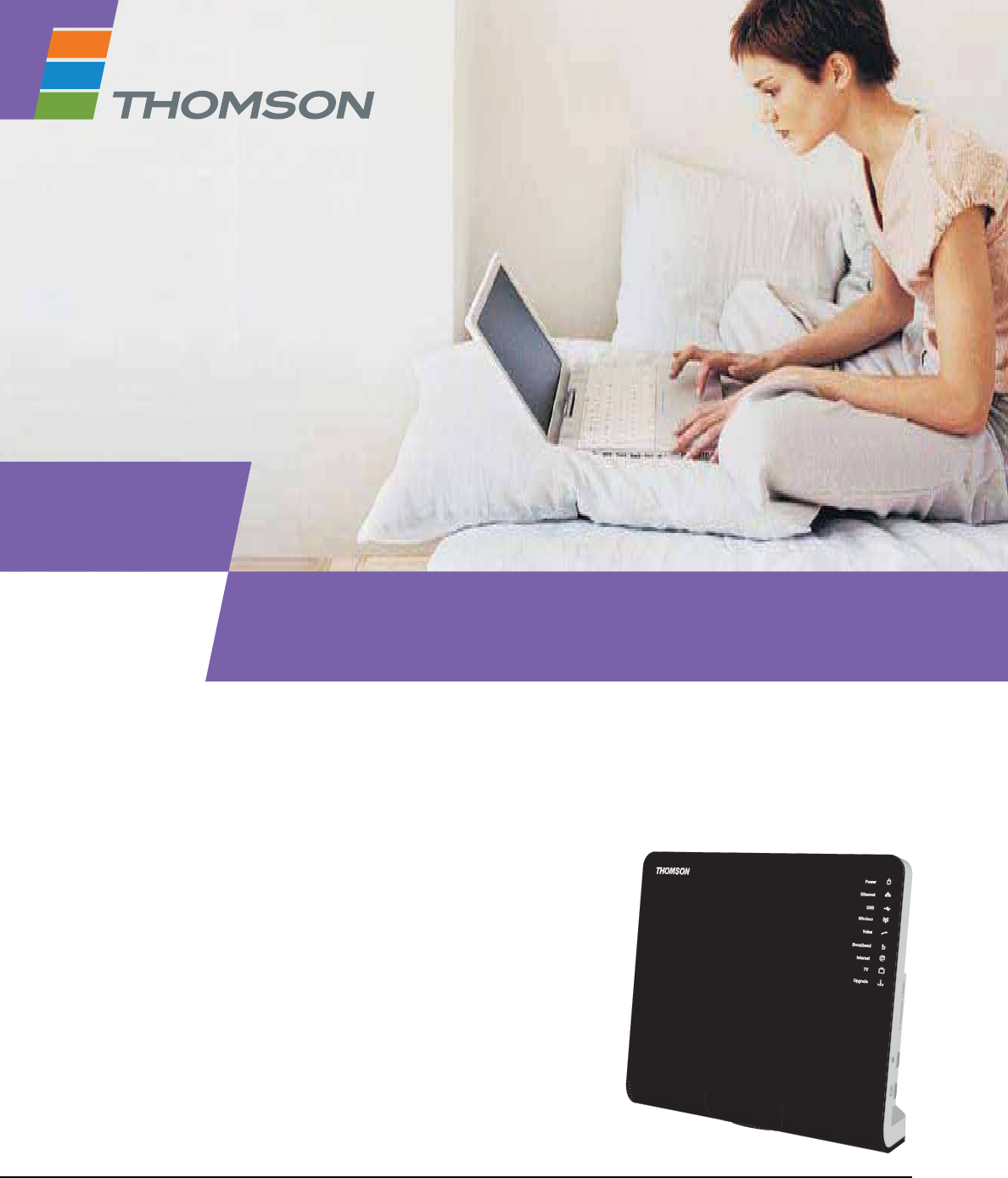
Setup and User Guide
THOMSON TG789vn
Wireless-n Multi-Service VoIP Ethernet WAN & VDSL2 Gateway
THOMSON TG789vn
Setup and User Guide

Copyright
Copyright ©1999-2010 THOMSON. All rights reserved.
Distribution and copying of this document, use and communication of its contents is not permitted without written authorization
from THOMSON. The content of this document is furnished for informational use only, may be subject to change without notice,
and should not be construed as a commitment by THOMSON. THOMSON assumes no responsibility or liability for any errors or
inaccuracies that may appear in this document.
THOMSON Telecom Belgium NV
Prins Boudewijnlaan, 47
2650 Edegem
Belgium
http://www.thomson.net
Trademarks
The following trademarks may be used in this document:
DECT™ is a trademark of ETSI.
Bluetooth® word mark and logos are owned by the Bluetooth SIG, Inc.
Ethernet™ is a trademark of Xerox Corporation.
Wi-Fi®, WMM® and the Wi-Fi logo are registered trademarks of the Wi-Fi Alliance®. Wi-Fi CERTIFIED, Wi-Fi ZONE, Wi-Fi
Protected Access, Wi-Fi Multimedia, Wi-Fi Protected Setup, WPA, WPA2 and their respective logos are trademarks of the
Wi-Fi Alliance®.
UPnP™ is a certification mark of the UPnP™ Implementers Corporation.
DLNA® is a registered trademark, DLNA disc logo is a service mark, and DLNA Certified is a trademark of the Digital Living
Network Alliance. Digital Living Network Alliance is a service mark of the Digital Living Network Alliance.
Microsoft®, MS-DOS®, Windows®, Windows NT® and Windows Vista® are either registered trademarks or trademarks
of Microsoft Corporation in the United States and/or other countries.
Apple® and Mac OS® are registered trademarks of Apple Computer, Incorporated, registered in the United States and
other countries.
UNIX® is a registered trademark of UNIX System Laboratories, Incorporated.
Adobe®, the Adobe logo, Acrobat and Acrobat Reader are trademarks or registered trademarks of Adobe Systems, Incor-
porated, registered in the United States and/or other countries.
Other brands and product names may be trademarks or registered trademarks of their respective holders. All other logos, trade-
marks and service marks are the property of their respective owners, where marked or not.
Document Information
Status: v1.0 (April 2010)
Reference: E-DOC-CTC-20080527-0012
Short Title: Setup & User Guide TG789vn R8.4.x (en)

E-DOC-CTC-20080527-0012 v1.0 i
Contents
About this Setup and User Guide ............................................. 1
1 Installation.................................................................................... 3
1.1 Before you start .............................................................................................. 4
1.1.1 DSL Requirements.................................................................................................................................. 5
1.1.2 Connection Requirements ..................................................................................................................... 7
1.2 Installing your Thomson Gateway .................................................................. 8
1.2.1 Guided Installation .................................................................................................................................9
1.2.2 Manual Installation............................................................................................................................... 11
1.3 Adding a New Computer to your Network ................................................... 13
1.4 Connecting a Computer Using the Ethernet Cable ....................................... 14
2 Thomson Gateway Basics ........................................................ 15
2.1 Thomson Gateway LED Behaviour ................................................................ 16
2.1.1 Status LEDs ...........................................................................................................................................17
2.1.2 WPS Button LED................................................................................................................................... 20
2.1.3 Ethernet LEDs ....................................................................................................................................... 21
2.2 Thomson Gateway GUI ................................................................................. 22
2.3 Backing Up/Restoring your Configuration .................................................... 25
3 Wireless Access ......................................................................... 27
3.1 Connecting Your Wireless Client via WPS .................................................... 28
3.2 Connecting Your Wireless Client without WPS ............................................ 30
3.3 Securing Your Wireless Connection.............................................................. 31
3.3.1 Configuring WPA-PSK Encryption ...................................................................................................... 32
3.3.2 Configuring WEP Encryption...............................................................................................................33
4 Telephony................................................................................... 35
4.1 Setting Up Your Telephone Network ............................................................ 36
4.1.1 Connection to the Traditional Telephone Network............................................................................37
4.1.2 Configuring the Thomson Gateway VoIP Settings............................................................................38
4.2 Address Book ................................................................................................ 41

E-DOC-CTC-20080527-0012 v1.0
ii
Contents
4.3 Telephony Services ....................................................................................... 42
4.3.1 Services supported by Your Service Provider ...................................................................................43
4.3.2 Activating a Telephony Service on your Thomson Gateway ...........................................................44
4.3.3 Using Telephony Services ................................................................................................................... 45
4.4 Viewing Telephony Statistics ....................................................................... 48
5 Saving Energy with Your Thomson Gateway ........................ 49
6 Sharing Content on your Thomson Gateway......................... 51
6.1 Using the Network File Server ...................................................................... 52
6.2 Using the UPnP AV Media Server ................................................................. 55
6.3 Using the FTP Server .................................................................................... 56
6.4 Managing your Shared Content .................................................................... 58
6.5 Safely Removing your USB Storage Device .................................................. 60
7 Thomson Gateway Tools.......................................................... 61
7.1 UPnP ............................................................................................................. 62
7.1.1 Accessing Your Thomson Gateway with UPnP .................................................................................63
7.1.2 Managing your Internet connection with UPnP................................................................................. 64
7.1.3 Configuring UPnP on the Thomson Gateway....................................................................................65
7.1.4 Installing UPnP on Windows XP ......................................................................................................... 66
7.2 Assigning a service (HTTP, FTP,...) to a Computer........................................ 68
7.3 Dynamic DNS ................................................................................................ 70
8 Internet Security ........................................................................ 71
8.1 Firewall.......................................................................................................... 72
8.2 Parental Control ............................................................................................ 73
8.2.1 Configuring The Content-based Filter ................................................................................................ 75
8.2.2 Adding Rules for the Address-Based Filter ........................................................................................ 76
9 Troubleshooting ........................................................................ 79
9.1 Setup Troubleshooting.................................................................................. 80
9.2 General Thomson Gateway Troubleshooting ................................................ 81
9.3 Wired Connection Troubleshooting .............................................................. 82

E-DOC-CTC-20080527-0012 v1.0 iii
Contents
9.4 Wireless Connection Troubleshooting .......................................................... 83
9.5 Voice over IP Troubleshooting...................................................................... 84
9.6 Reset to Factory Defaults ............................................................................. 85

E-DOC-CTC-20080527-0012 v1.0
iv
Contents

E-DOC-CTC-20080527-0012 v1.0 1
About this Setup and User Guide
About this Setup and User Guide
Used Symbols
Terminology
Generally, the THOMSON TG789vn will be referred to as Thomson Gateway in this Setup and User Guide.
Typographical Conventions
Following typographical convention is used throughout this manual:
Sample text indicates a hyperlink to a Web site.
Example: For more information, visit us at www.thomson.net.
Sample text indicates an internal cross-reference.
Example: If you want to know more about guide, see “1 Introduction” on page 7”.
Sample text indicates an important content-related word.
Example: To enter the network, you must authenticate yourself.
Sample text indicates a GUI element (commands on menus and buttons, dialog box elements, file
names, paths and folders).
Example: On the File menu, click Open to open a file.
Documentation and software updates
THOMSON continuously develops new solutions, but is also committed to improving its existing products.
For more information on THOMSON's latest technological innovations, documents and software releases,
visit us at www.thomson.net.
Anote provides additional information about a topic.
Acaution warns you about potential problems or specific precautions that need to be taken.

E-DOC-CTC-20080527-0012 v1.0
2
About this Setup and User Guide

E-DOC-CTC-20080527-0012 v1.0 3
1 Installation
1 Installation
Introduction
In a few minutes you will be able to access the Internet using your Thomson Gateway.
This Setup and User Guide will show you how to set up your Thomson Gateway and how to connect your
computer(s) to the Internet.
Main features
As soon as you have completed the installation of your Thomson Gateway you will be able to benefit from all
the services offered by your Thomson Gateway. This Setup and User Guide will focus on the following
features:
Broadband Internet connection.
The first chapter describes how to connect your Thomson Gateway to the Internet.
Wired and wireless access to your local network devices.
For more information, see “1.4 Connecting a Computer Using the Ethernet Cable” on page 14 and
“3 Wireless Access” on page 27.
Voice over IP (VoIP) connectivity for traditional phones and IP phones.
For more information see “4 Telephony” on page 35
Share your media with media players and other network devices using the built-in File Server, FTP Server
and UPnP AV Server. For more information, see “6 Sharing Content on your Thomson Gateway” on
page 51.
Useful networking tools like UPnP,Dynamic DNS and many more.
For more information, see “7 Thomson Gateway Tools” on page 61.
Internet Security:
For more information, see “8 Internet Security” on page 71.
Before you can start to use these features, we will first set up your Thomson Gateway.
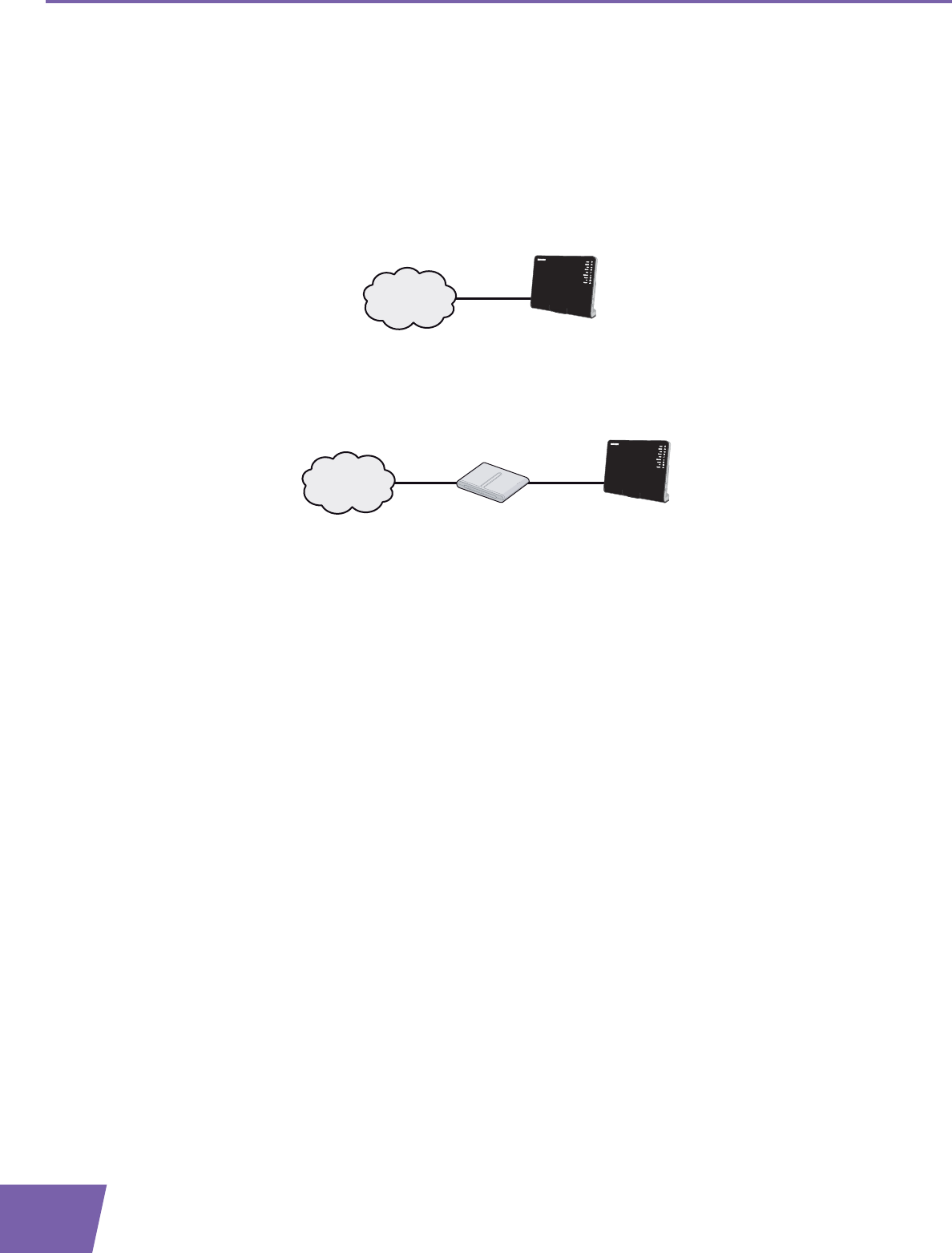
E-DOC-CTC-20080527-0012 v1.0
4
1 Installation
1.1 Before you start
User-specific requirements
You can use your Thomson Gateway as:
DSL Gateway:
The Thomson Gateway is connected to the DSL network of your service provider and brings the Internet
to your home.
To use the Thomson Gateway in this setup, make sure that the requirements in “1.1.1 DSL
Requirements” on page 5 are met.
Home Router:
The Thomson Gateway is placed behind your another gateway or modem.
This setup has no special requirements attached to it.
DSL
Thomson Gateway
DSL
Modem/Router Thomson Gateway
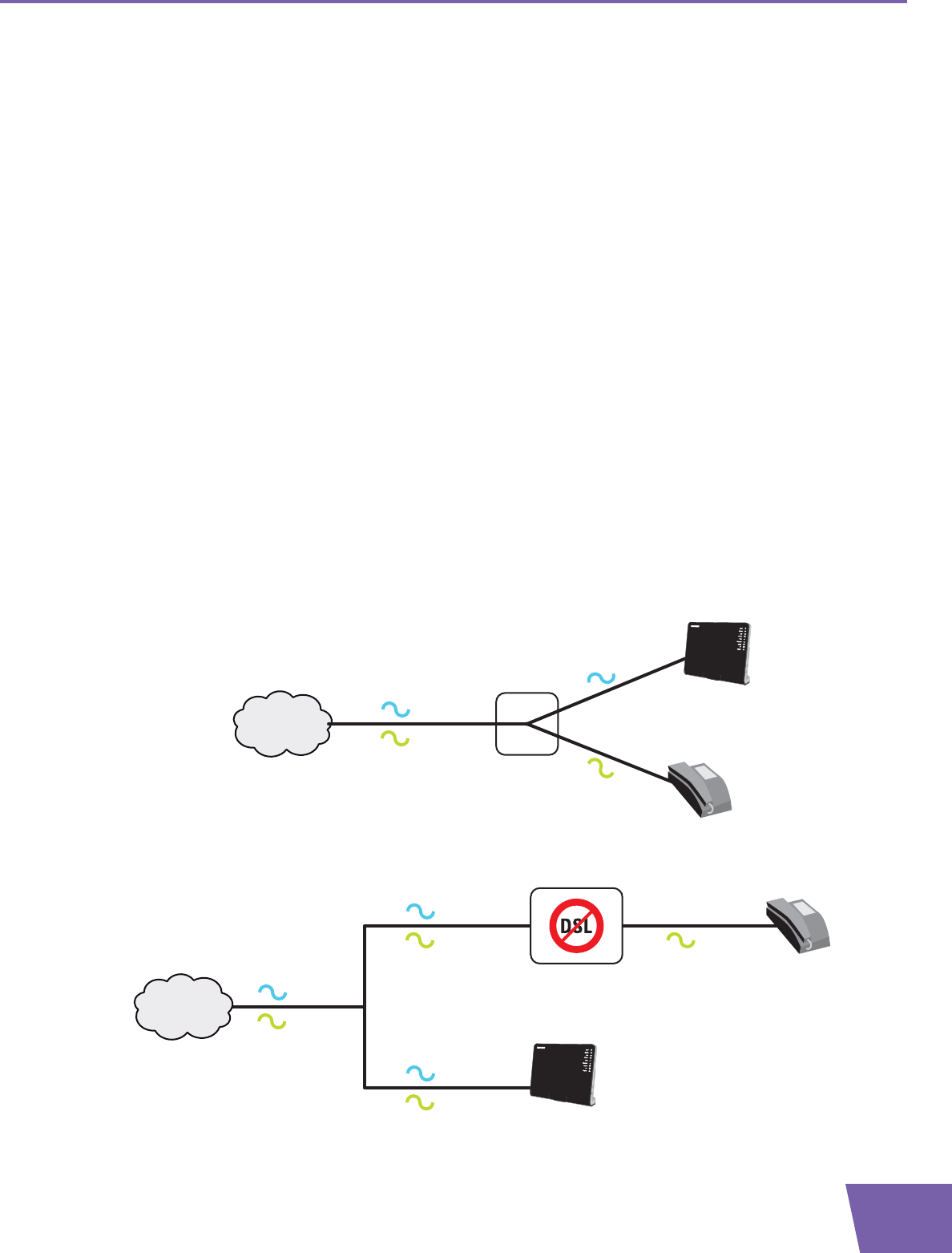
E-DOC-CTC-20080527-0012 v1.0 5
1 Installation
1.1.1 DSL Requirements
Applicability
This section is only applicable if you are using your Thomson Gateway as DSL gateway. For more
information, see “User-specific requirements” on page 4.
DSL Service
The DSL service must be activated on your telephone line by your service provider.
Decoupling the voice and DSL signal
As soon as the DSL service is activated two kinds of signals will be available on your telephone line:
Voice signals
DSL signals
To ensure the sound quality of your phone calls, the DSL signal must be omitted from the telephone line
before it reaches your phone, otherwise you might hear a noise in the background when using your phone.
Filters and splitters
To split the DSL signal from the telephone line, you can use one of the following solutions:
Asplitter that splits the telephone signal into a DSL and Voice signal.
Afilter between your telephone outlet and your phone. This filter removes the DSL signal and passes the
Voice signal.
This filter may also be integrated in your Thomson Gateway.
Telephone
Network
DSL
Voice
Splitter
Voice
DSL
Telephone
Network
DSL
Voice
Filter/Splitter
Voice
DSL
Voice
DSL
Voice
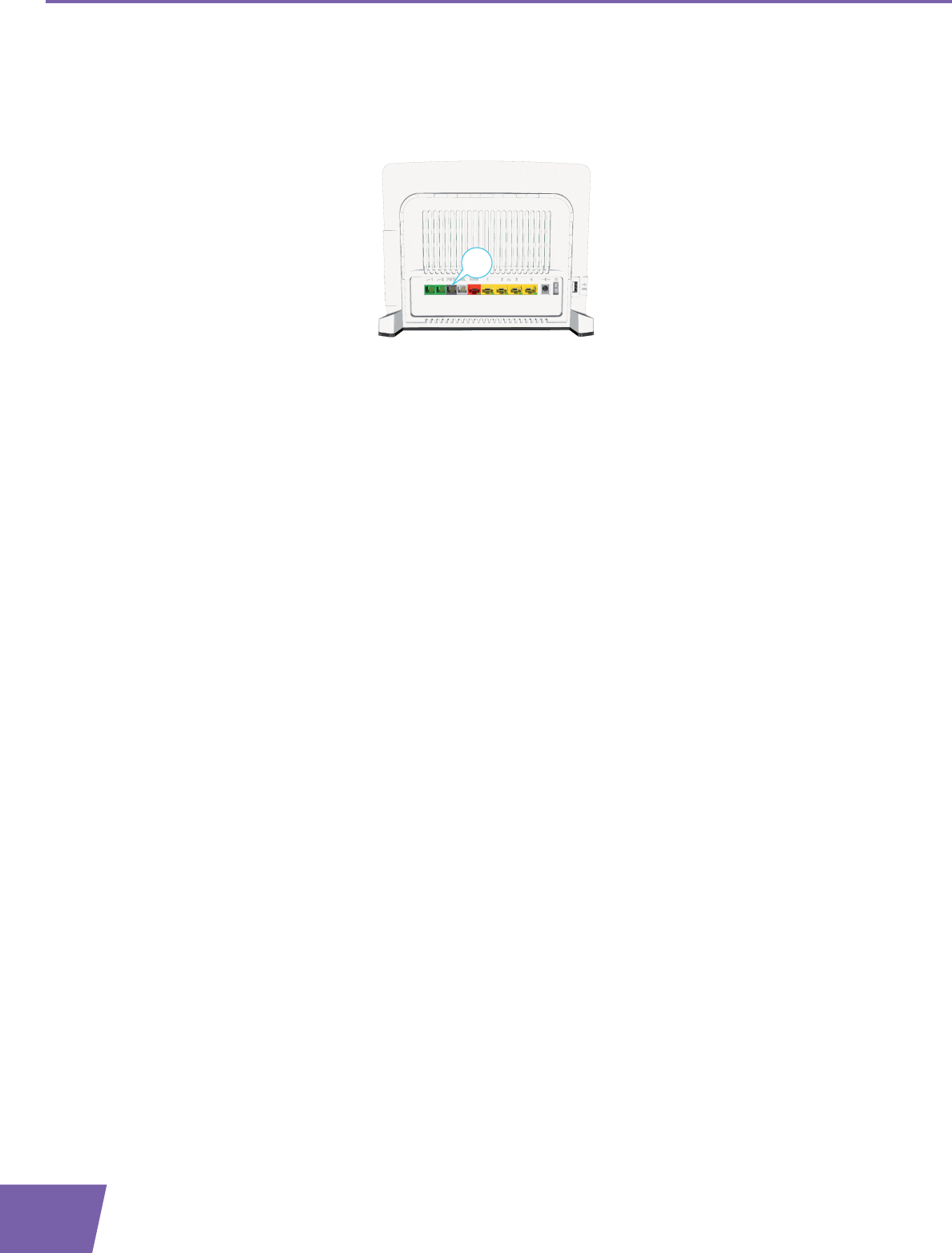
E-DOC-CTC-20080527-0012 v1.0
6
1 Installation
How do I know if my Thomson Gateway has an integrated filter?
Thomson Gateways:
With an integrated filter have no PSTN port on their back panel.
Without integrated filter have a PSTN port on their back panel.
Here you will have to put a filters/splitter between the telephone outlet and your Thomson Gateway.
PSTN
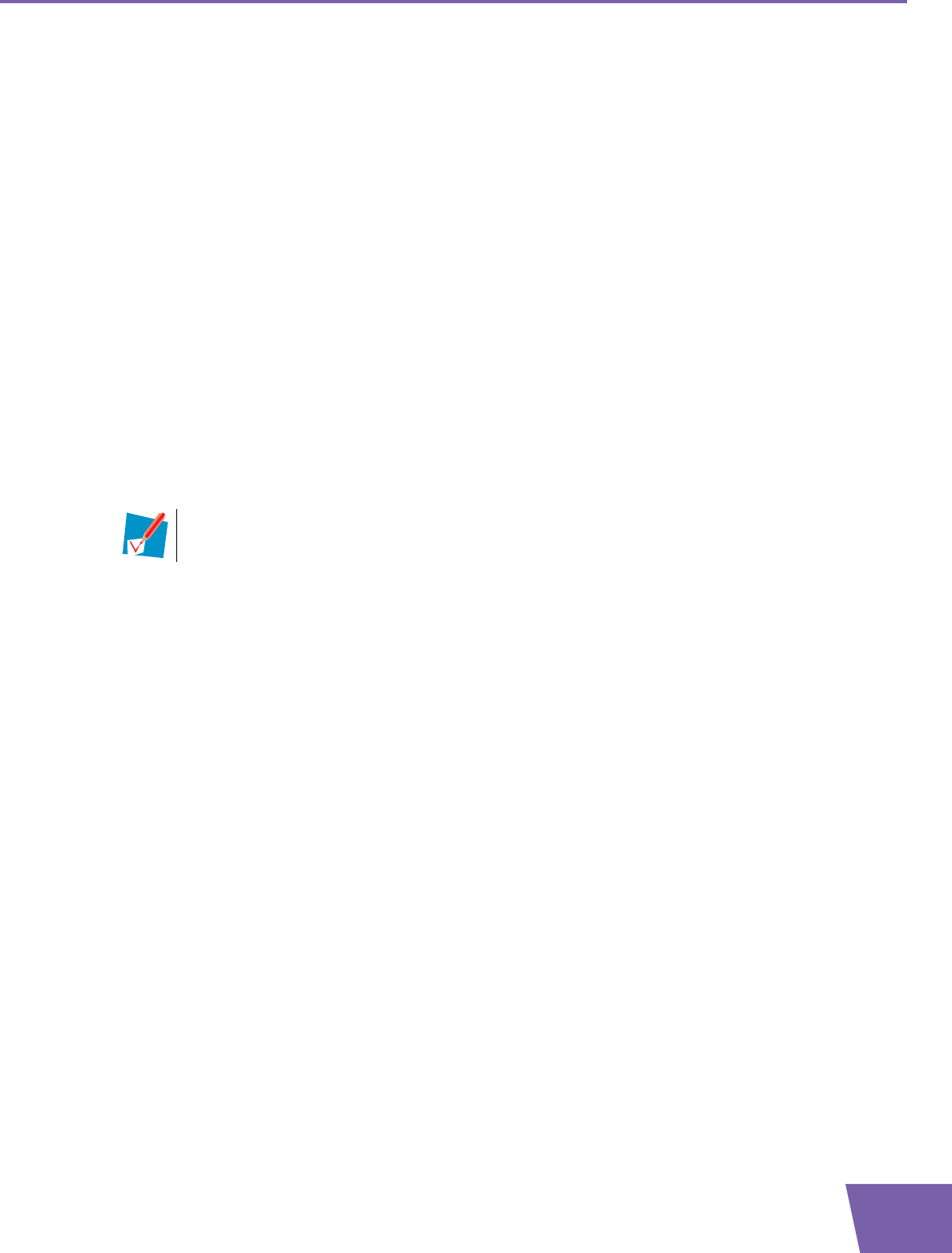
E-DOC-CTC-20080527-0012 v1.0 7
1 Installation
1.1.2 Connection Requirements
Wireless connection
If you want to connect your computer using a wireless connection, you will need a WiFi-certified wireless
client adapter for each computer you want to connect wirelessly.
Wired connection
If you want to connect one or more computer using a wired connection, make sure those computers are
equipped with an Ethernet Network Interface Card (NIC).
Internet connection
You may need the following connection details from your service provider:
Your service provider’s method for connecting to the Internet (for example PPPoE)
The VPI/VCI (for example 8/35)
Your user name and password to connect to the Internet for PPP connections
Your IP settings in case of static configurations
You may have received this information when you subscribed at your Internet Service Provider. You may be
prompted for this information at a given step in the installation procedure.
Optionally your service provider may indicate the service profile to use during the setup.

E-DOC-CTC-20080527-0012 v1.0
8
1 Installation
1.2 Installing your Thomson Gateway
Warning
Do not plug in any cables or connect any devices until you are instructed to do so.
Installation methods
There two ways to set up your Thomson Gateway:
Guided Installation
The Setup wizard included on the Setup CD will guide you through all configuration aspects of your
Thomson Gateway. This is the recommended way to install your Thomson Gateway.
Manual Installation
The Setup and User Guide will first help you to connect your computer to the Thomson Gateway. After
this is done, you can configure your Thomson Gateway using your web browser.
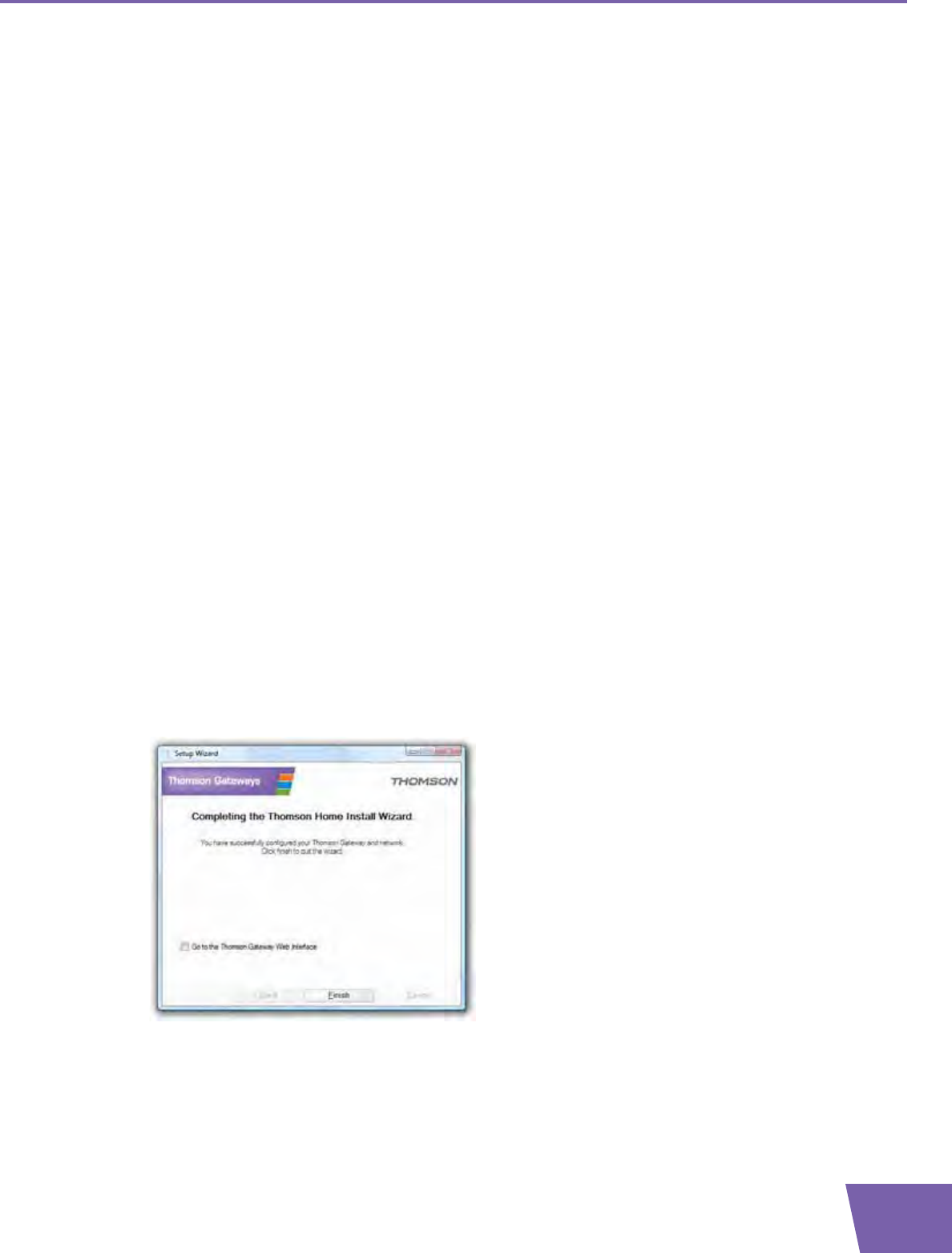
E-DOC-CTC-20080527-0012 v1.0 9
1 Installation
1.2.1 Guided Installation
Requirements
Your computer must run one of the following operating systems:
Microsoft Windows 7 or higher
Microsoft Windows 7 x64 or higher
Microsoft Windows Vista (SP1) or higher
Microsoft Windows Vista x64 (SP1) or higher
Microsoft Windows XP SP2 or higher
Microsoft Windows XP x64 SP1 or higher
Microsoft Windows 2000 SP4
Mac OS X 10.4 (Tiger)
Mac OS X 10.5 (Leopard)
If you are using another operating system, use the Manual Installation.
You must have administrative rights on your computer
Starting the wizard
To start the wizard:
1Insert the Setup CD into your computer's CD- or DVD-ROM drive.
2If your computer runs:
Microsoft Windows: The CD should autostart.
If the CD does not autostart, see “The Setup CD does not start automatically” on page 80.
Mac OS X: Double-click Menu in the window with the content of the CD.
3Select the language of your choice and click OK.
4The Setup wizard will now guide you through the installation of your Thomson Gateway.
5At the end of the installation, the following screen appears:
6Select Go to the Thomson Gateway Web Interface if you want to go to the Thomson Gateway GUI after
closing the wizard. On the Thomson Gateway GUI, you can configure all services of your Thomson
Gateway.
7Click Finish.
8The CD menu appears.
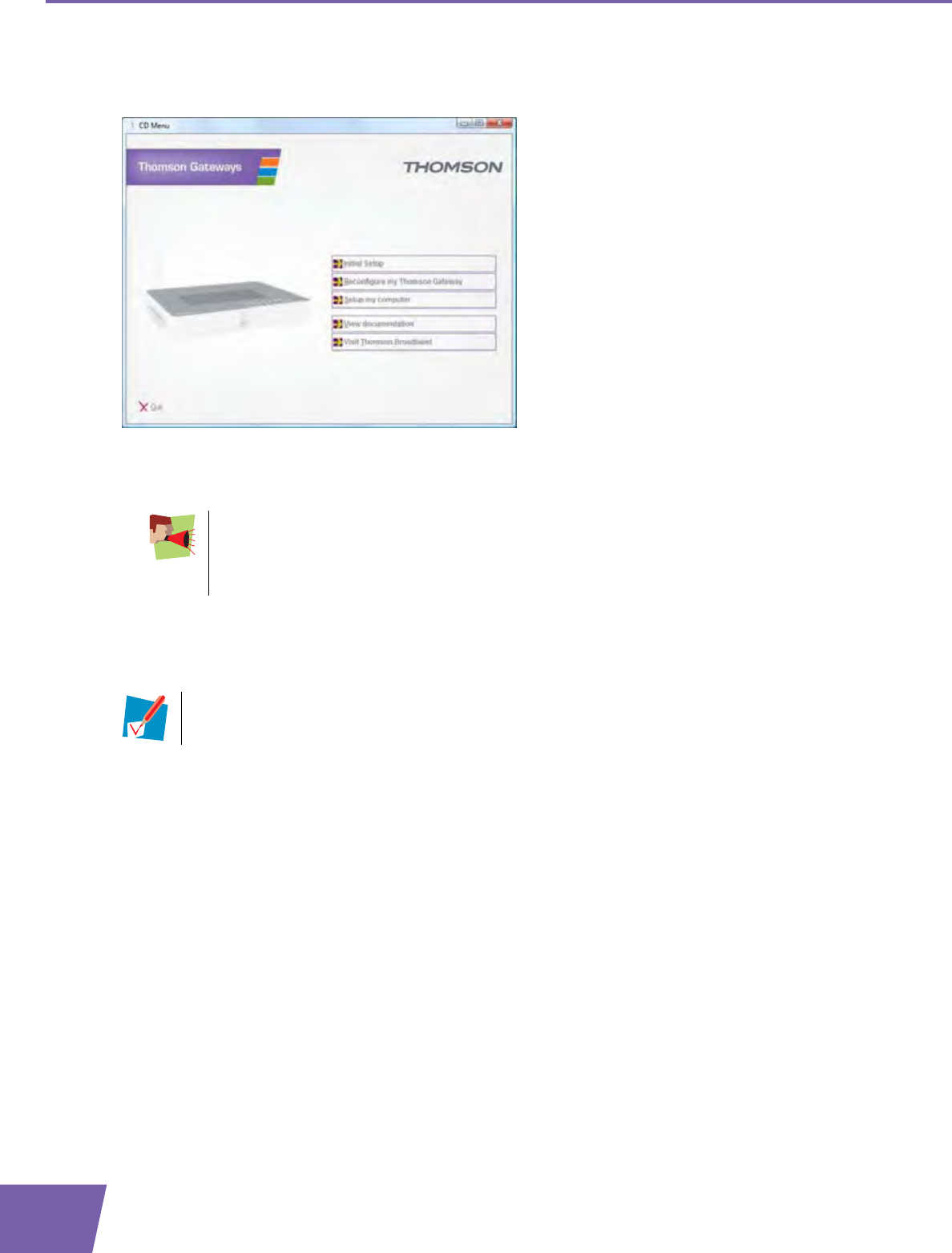
E-DOC-CTC-20080527-0012 v1.0
10
1 Installation
CD menu
On the CD Menu, you can click:
Initial Setup to connect your computer to the Thomson Gateway and configure it.
Reconfigure my Thomson Gateway to fully reconfigure your Thomson Gateway.
Setup my computer to connect your computer to the Thomson Gateway network.
View Documentation to view a list of the documentation that is available for your Thomson Gateway.
This list will be automatically updated if you are connected to the Internet.
Visit thomson.net to visit the online support sections.
In case of problems
If you encounter problems during this installation please refer to “9.1 Setup Troubleshooting” on page 80.
If you reconfigure your Thomson Gateway via the CD menu, the Thomson Gateway will be
reconfigured from scratch. All your current settings will be lost. If you only want to make small
changes to your configuration (e.g. changing the security), we recommended you to do this via
the Thomson Gateway GUI. For more information, see “2.2 Thomson Gateway GUI” on
page 22.
Actual available items may depend on the Setup CD delivered with your Thomson Gateway.
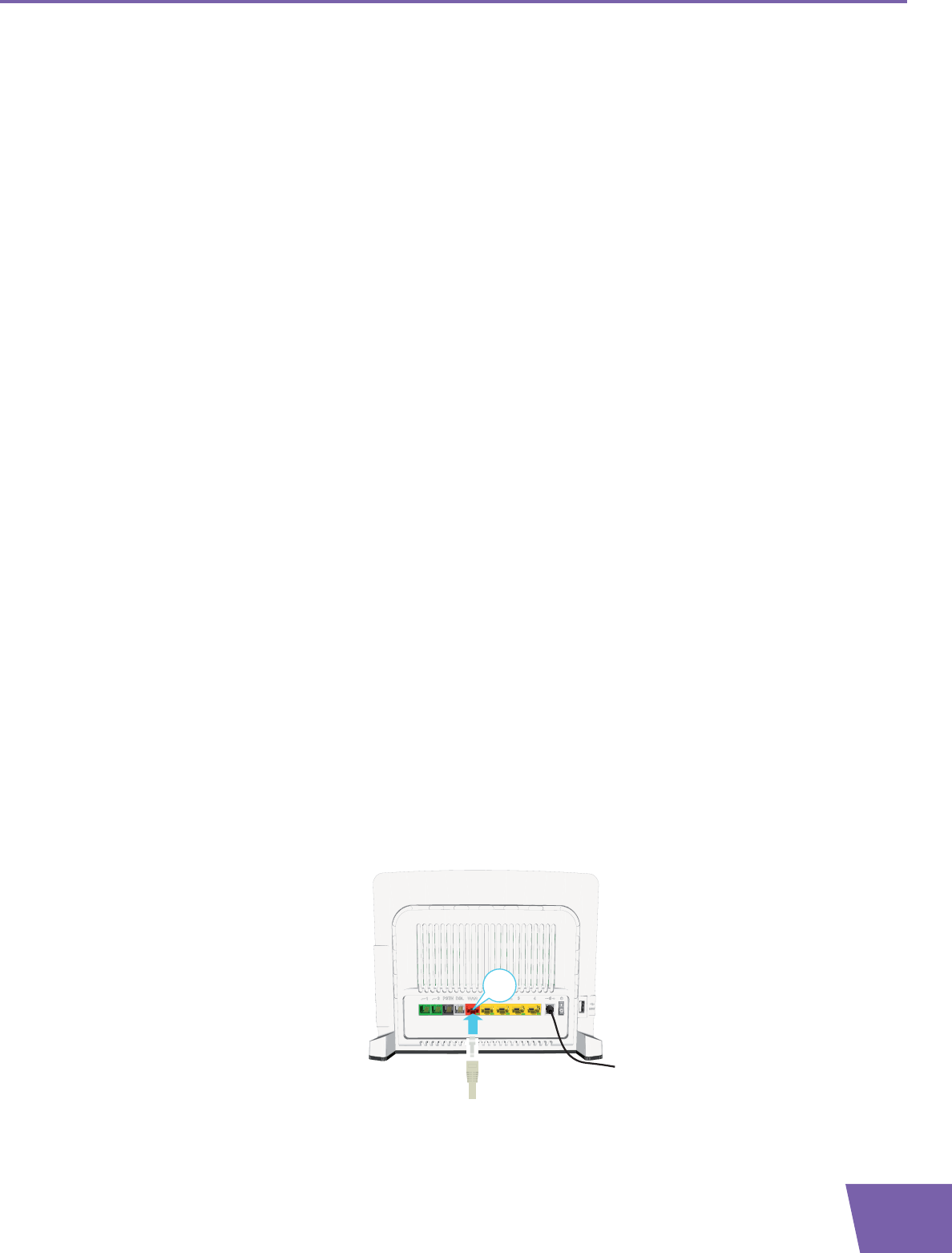
E-DOC-CTC-20080527-0012 v1.0 11
1 Installation
1.2.2 Manual Installation
Requirements
JavaScript must be enabled (this is the default setting) on your browser. For more information, consult the
help of your web browser.
Procedure
Proceed as follows:
1Connect the Thomson Gateway to your broadband service.
2Power on the Thomson Gateway.
3Connect your computer to the Thomson Gateway.
4Configure the Thomson Gateway.
This is described in the sections below.
Connect the Thomson Gateway to your broadband service
As described in “User-specific requirements” on page 4, you can use your Thomson Gateway in either of the
following scenarios:
DSL Gateway
Home Router
When setting up Thomson Gateway as DSL Gateway
Proceed as follows:
1Take the DSL cable with the grey connectors. This cable is included in your box.
2Plug one end of the cable in the grey DSL port on the back of your Thomson Gateway.
3If you are:
Using a splitter, plug the other end of the cable into the Modem/ADSL out put of your splitter.
Not using a splitter, plug the other end of the cable directly in the wall outlet.
For more information about splitters, see “Filters and splitters” on page 5.
When setting up Thomson Gateway as Home Router
Proceed as follows:
1Take an Ethernet cable.
2Plug one end of the cable in the red WAN port on the back of your Thomson Gateway.
WAN
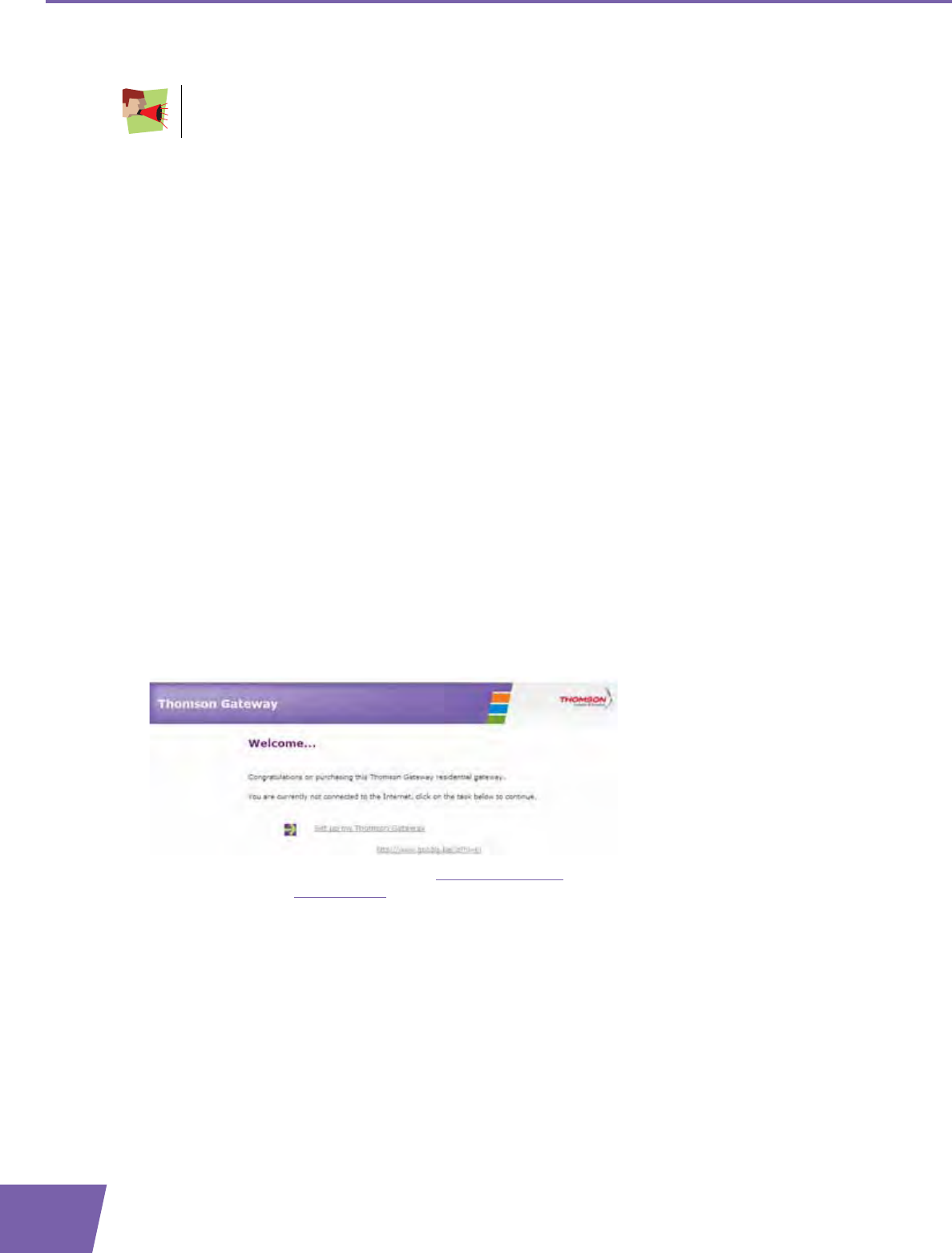
E-DOC-CTC-20080527-0012 v1.0
12
1 Installation
3Plug the other end into the Ethernet port of your Internet gateway/modem.
Power on the Thomson Gateway
Proceed as follows:
1Connect the power cord to the Thomson Gateway’s power port.
2Plug the other end into an electrical outlet.
3Push the power button to turn on the Thomson Gateway.
4Wait two minutes to allow the Thomson Gateway to complete the start up phase.
Connect your computer to the Thomson Gateway
Setting up a wireless connections
For more information on how to setup a wireless connection to your Thomson Gateway, see “3 Wireless
Access” on page 27.
Setting up a wired connection
For more information on how to setup a wired connection (i.e. an Ethernet connection) to your Thomson
Gateway, see “1.4 Connecting a Computer Using the Ethernet Cable” on page 14.
Configure the Thomson Gateway
Proceed as follows:
1Open your web browser.
2The Thomson Gateway informs you that you have not yet configured your Thomson Gateway.
If this window does not appear browse to http://dsldevice.lan or to the IP address of your Thomson
Gateway (by default: 192.168.1.254) and click Thomson Gateway on the menu on the left-hand side.
3Click Setup my Thomson Gateway.
4The Easy Setup wizard appears. This wizard will guide you through the configuration of your Thomson
Gateway. Click Next and follow the instructions.
The WAN port can only be used to connect your Thomson Gateway to an Internet gateway/modem.
You can not use it to connect your computer to the Thomson Gateway.
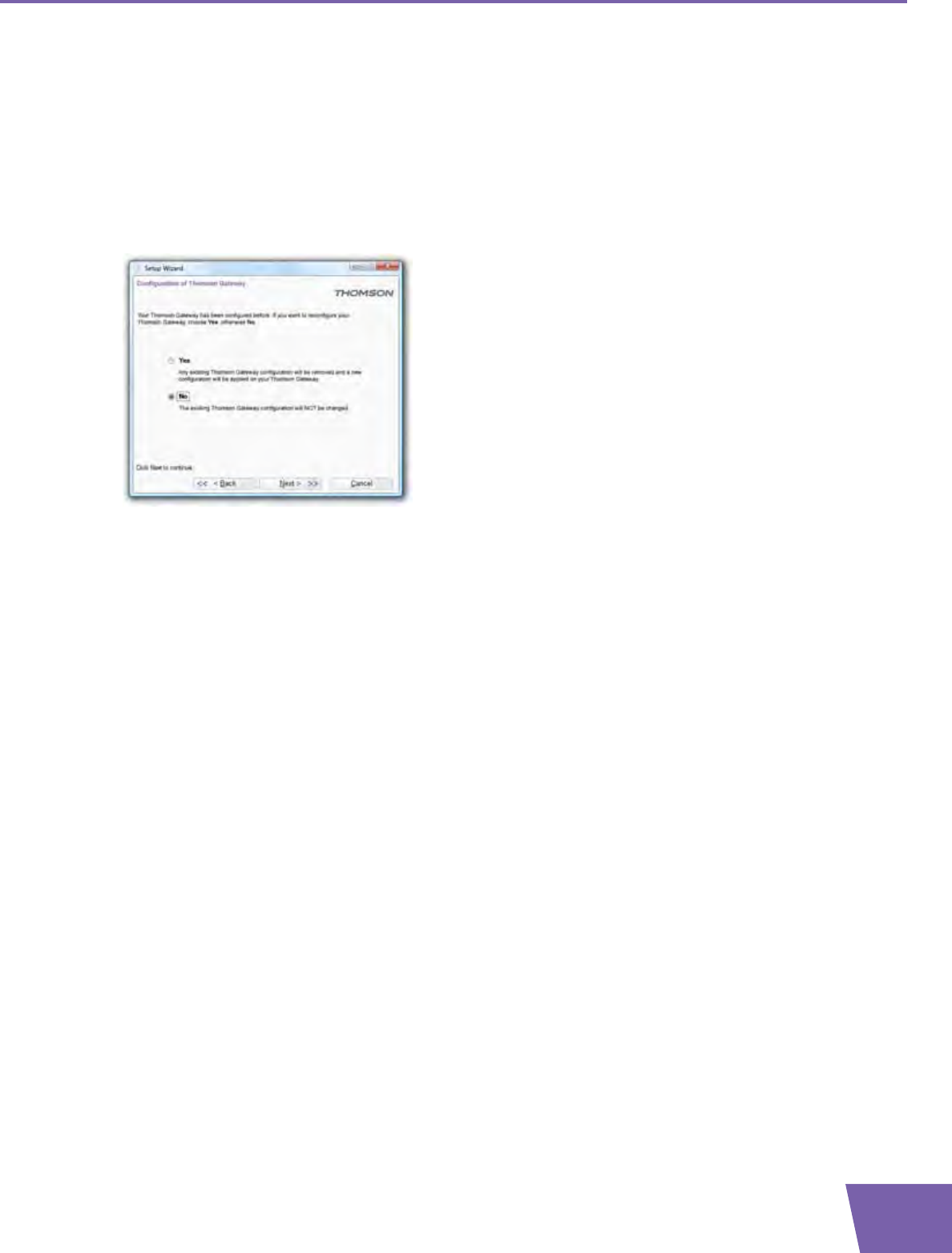
E-DOC-CTC-20080527-0012 v1.0 13
1 Installation
1.3 Adding a New Computer to your Network
Guided Installation
If you configured your Thomson Gateway using the Guided Installation, use the same procedure on the
computer that you want to add.
When the Setup wizard informs you that the Thomson Gateway has already been configured, select No and
click Next to continue.
Manual Installation
Setting up a wireless connections
For more information on how to setup a wireless connection to your Thomson Gateway, see “3 Wireless
Access” on page 27.
Setting up a wired connection
For more information on how to setup a wired connection (i.e. an Ethernet connection) to your Thomson
Gateway, see “1.4 Connecting a Computer Using the Ethernet Cable” on page 14.
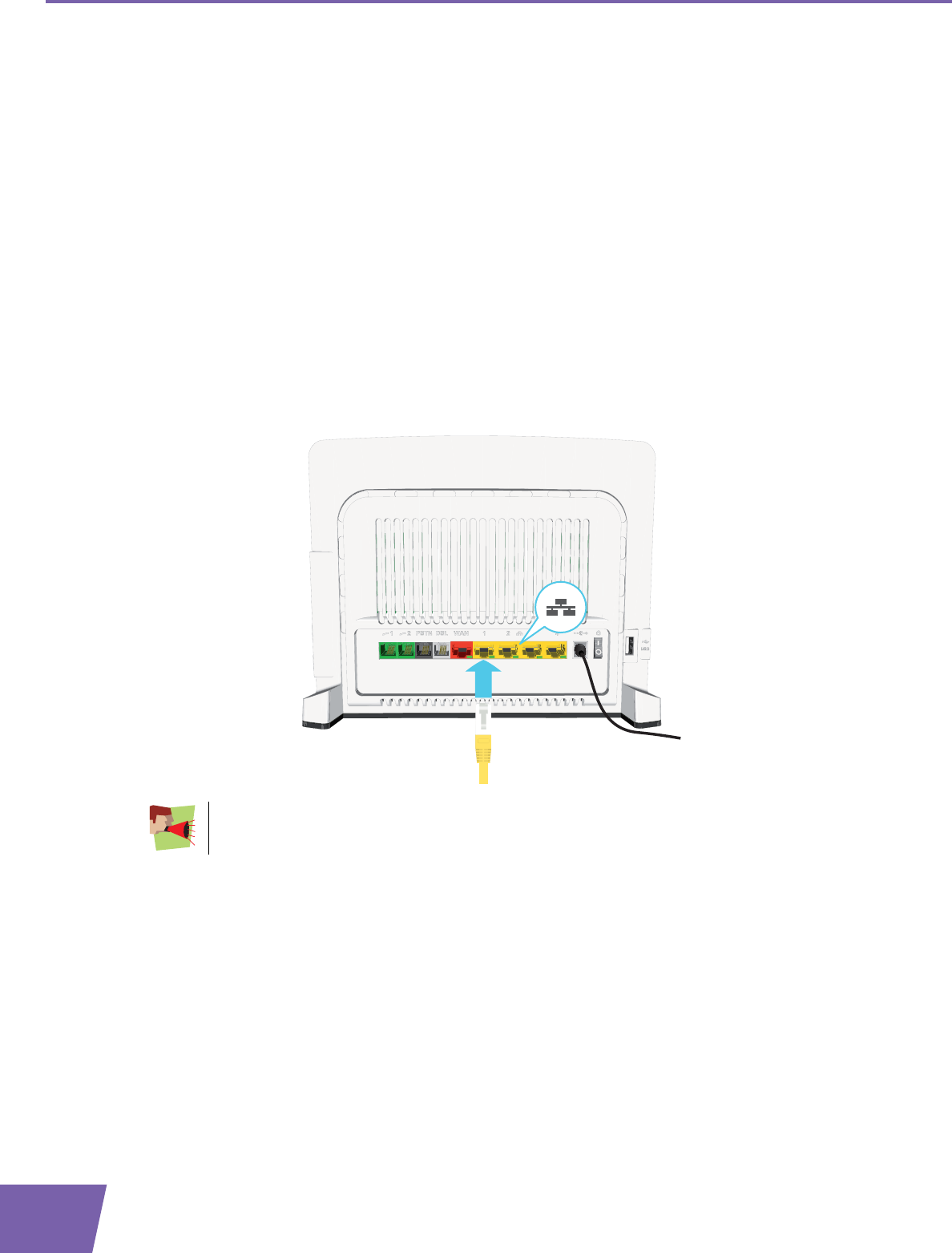
E-DOC-CTC-20080527-0012 v1.0
14
1 Installation
1.4 Connecting a Computer Using the Ethernet Cable
Requirements
Both your computer and Thomson Gateway must have a free Ethernet port.
Your computer must be configured to obtain an IP address automatically. This is the default setting.
Ethernet cable
In your package, you will find a cable with yellow connectors. This is the Ethernet cable.
Procedure
Proceed as follows:
1Connect one end of the Ethernet cable to one of the yellow Ethernet ports of your Thomson Gateway:
2Connect the other end of the Ethernet cable to your computer.
3Your computer is now connected to your network. No additional configuration is needed.
You can not use the red WAN port for this. The WAN port can only be used to connect your
Thomson Gateway to an Internet gateway/modem.
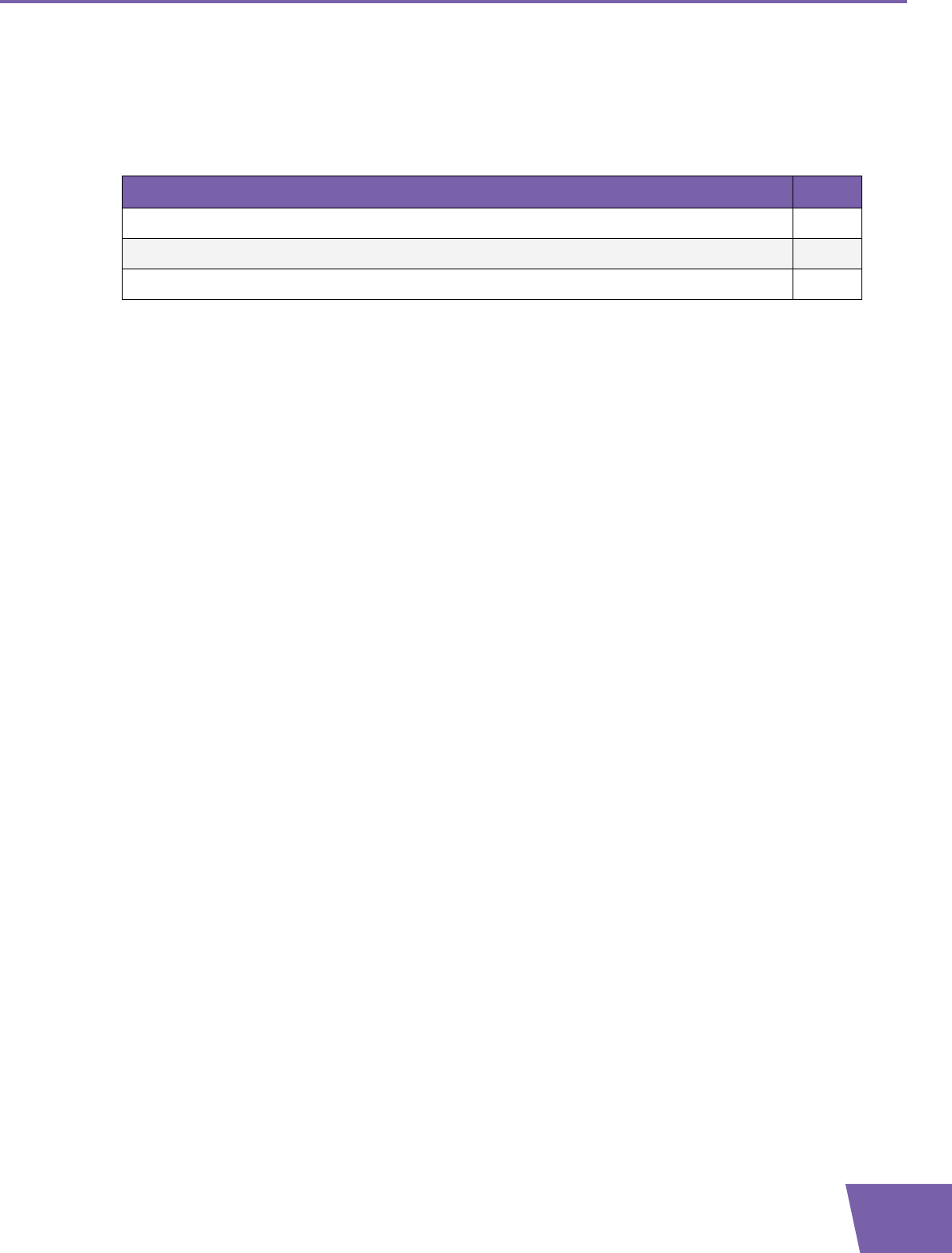
E-DOC-CTC-20080527-0012 v1.0 15
2 Thomson Gateway Basics
2 Thomson Gateway Basics
In this chapter
Topic Page
Thomson Gateway LED Behaviour 16
Thomson Gateway GUI 22
Backing Up/Restoring your Configuration 25

E-DOC-CTC-20080527-0012 v1.0
16
2 Thomson Gateway Basics
2.1 Thomson Gateway LED Behaviour
Content
This chapter describes the behaviour of:
Status LEDs
WPS Button LED
Ethernet LEDs
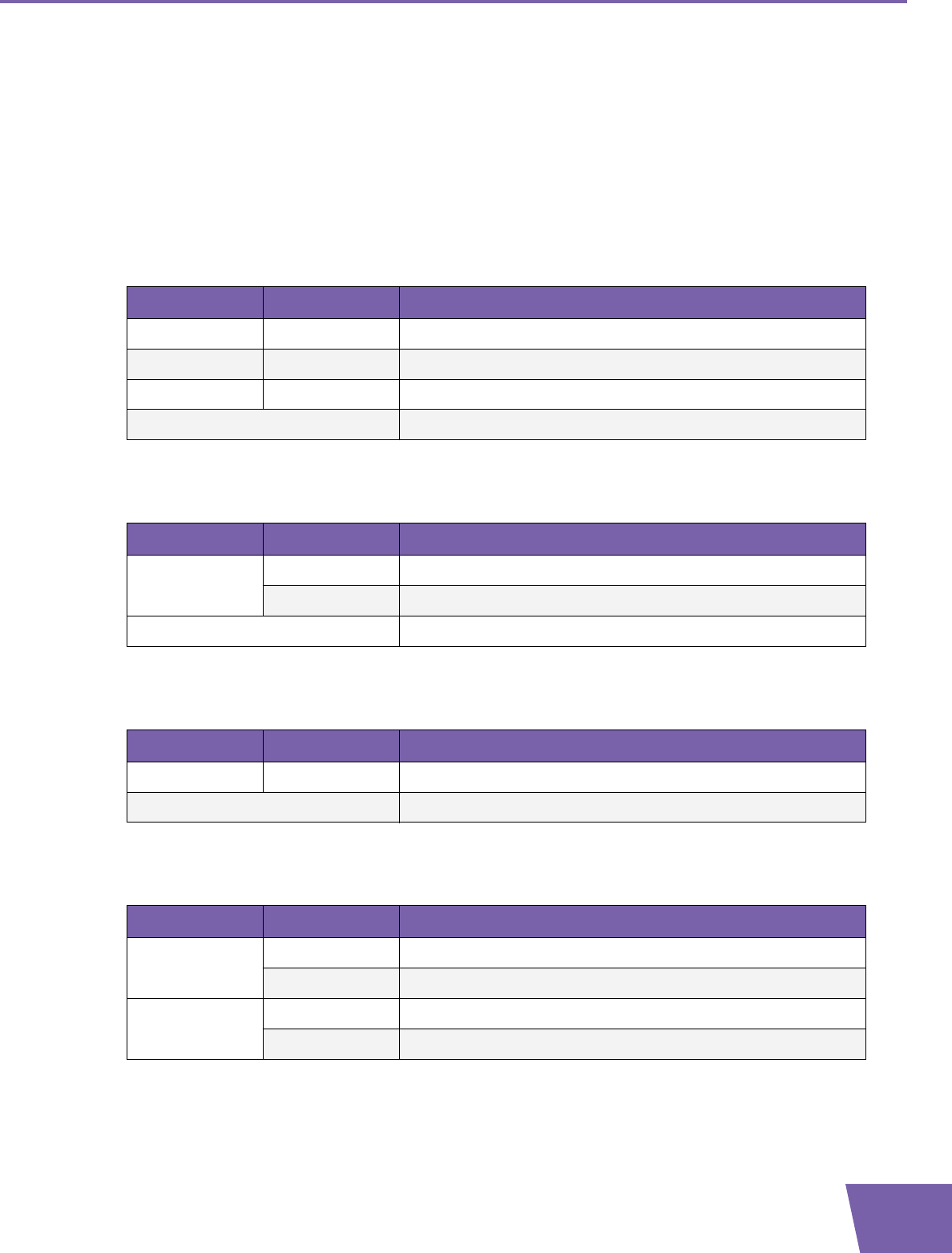
E-DOC-CTC-20080527-0012 v1.0 17
2 Thomson Gateway Basics
2.1.1 Status LEDs
Introduction
On the front panel of your Thomson Gateway, you can find a number of status LEDs, indicating the state of
the device.
Power LED
Ethernet LED
USB LED
Wireless LED
Colour State Description
Green Solid on Power on, normal operation
Red Solid on Power on, self-test failed, indicating device malfunction
Orange Blinking Bootloader active (during upgrade)
Off Power off
Colour State Description
Green Solid on Ethernet connection, no activity
Blinking Ethernet activity
Off No Ethernet connection
Colour State Description
Green Solid on Device connected to the Thomson Gateway’s USB port
Off No device connected to the Thomson Gateway’s USB port
Colour State Description
Green Solid on No wireless activity, WPA(2) encryption
Blinking Wireless activity, WPA(2) encryption
Orange Solid on No wireless activity, WEP encryption
Blinking Wireless activity, WEP encryption
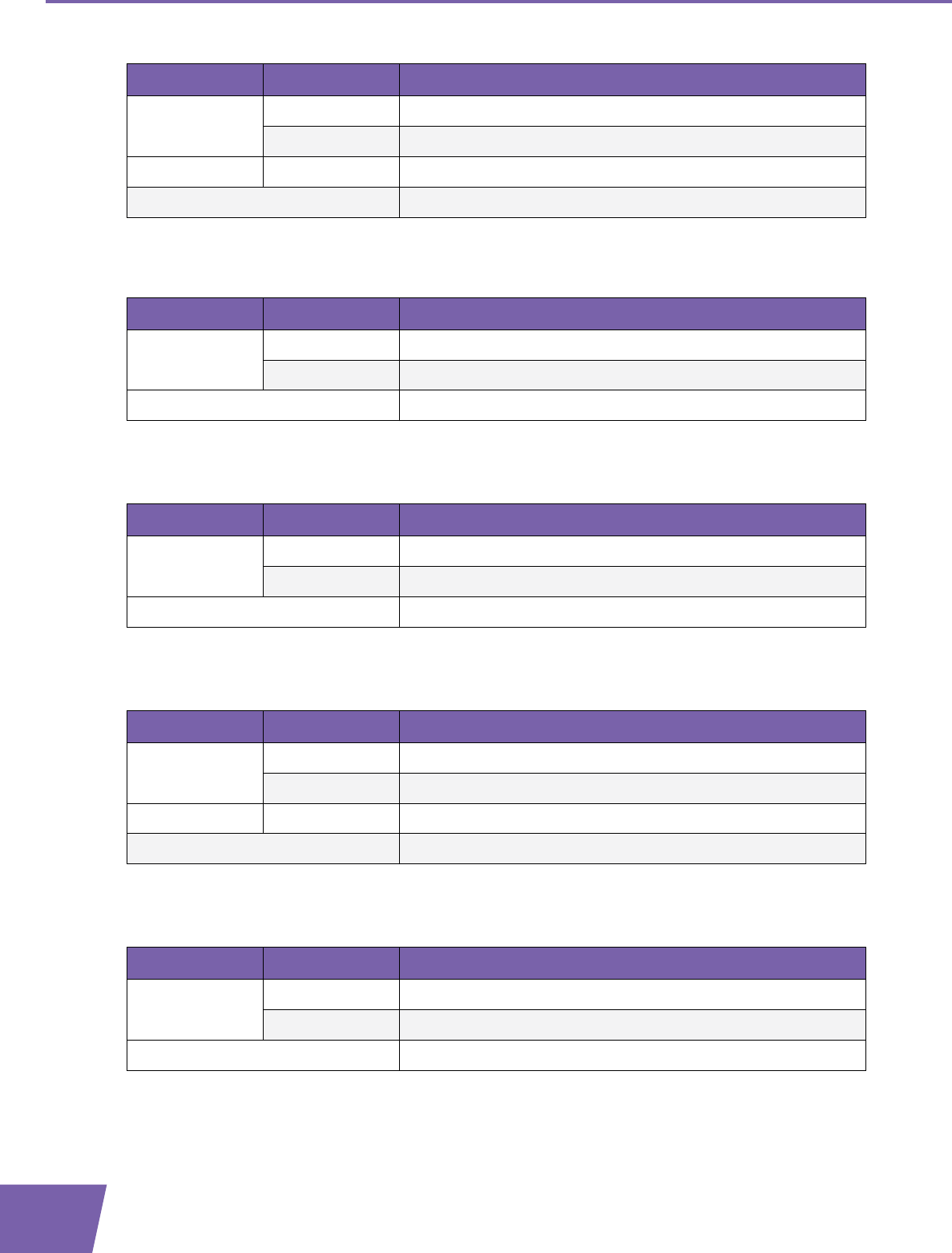
E-DOC-CTC-20080527-0012 v1.0
18
2 Thomson Gateway Basics
Phone LED
Broadband LED
Internet LED
TV LED
Red Solid on No wireless activity, no security
Blinking Wireless activity, no security
Red/green Toggling Wireless client registration phase
Off WLAN disabled
Colour State Description
Green Solid on VoIP service up
Blinking VoIP activity
Off VoIP service down
Colour State Description
Green Solid on DSL line synchronised
Blinking Pending DSL line synchronisation
Off No DSL line
Colour State Description
Green Solid on Internet connectivity, no activity
Blinking Internet activity
Red Solid on Internet connection setup failed
Off No Internet connection
Colour State Description
Green Solid on Set-Top Box (STB) connected to the Thomson Gateway
Blinking Unknown STB connected to the Thomson Gateway
Off No STB connected to the Thomson Gateway
Colour State Description
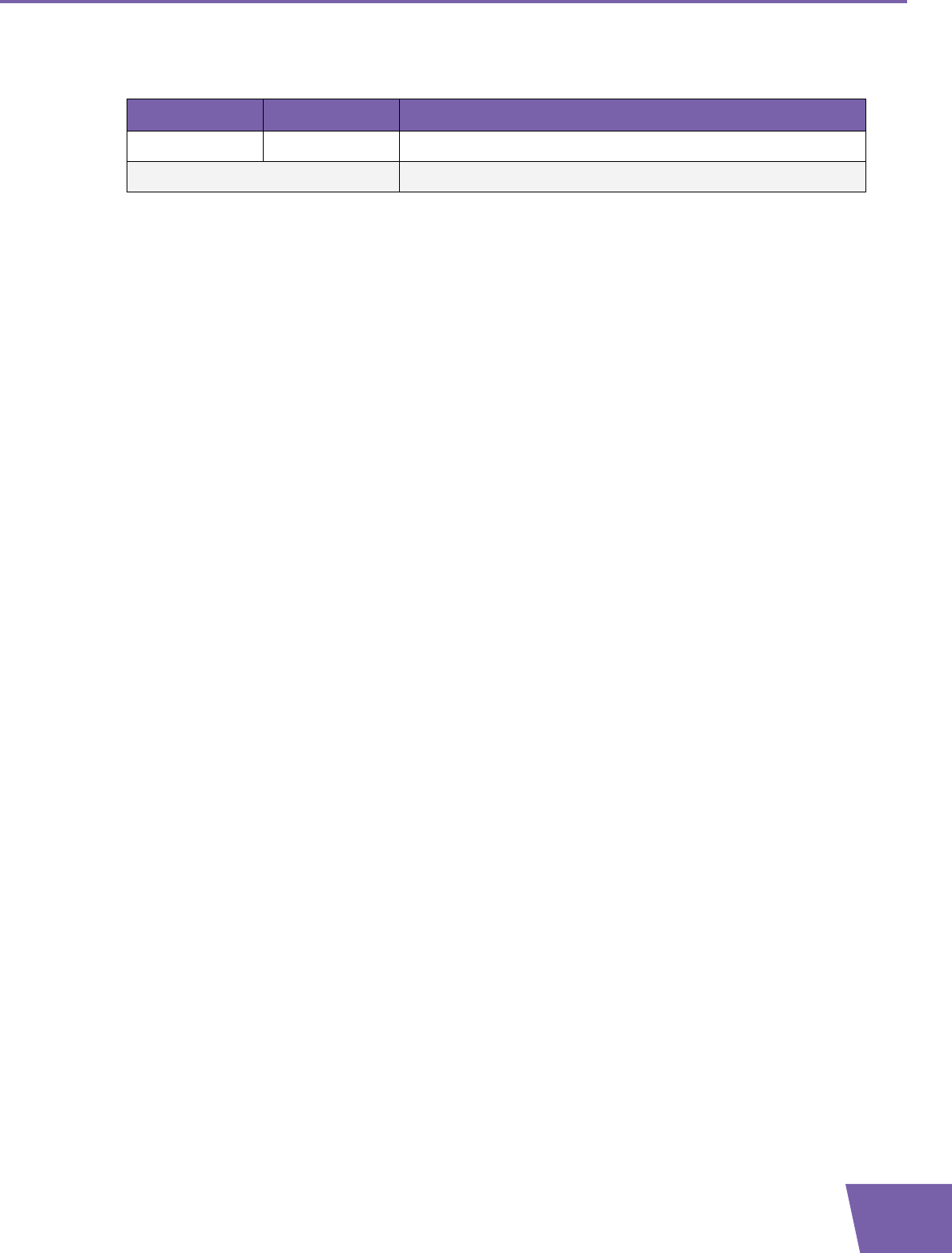
E-DOC-CTC-20080527-0012 v1.0 19
2 Thomson Gateway Basics
Upgrade LED
Colour State Description
Blue Solid on Software upgrade ongoing
Off No software upgrade ongoing
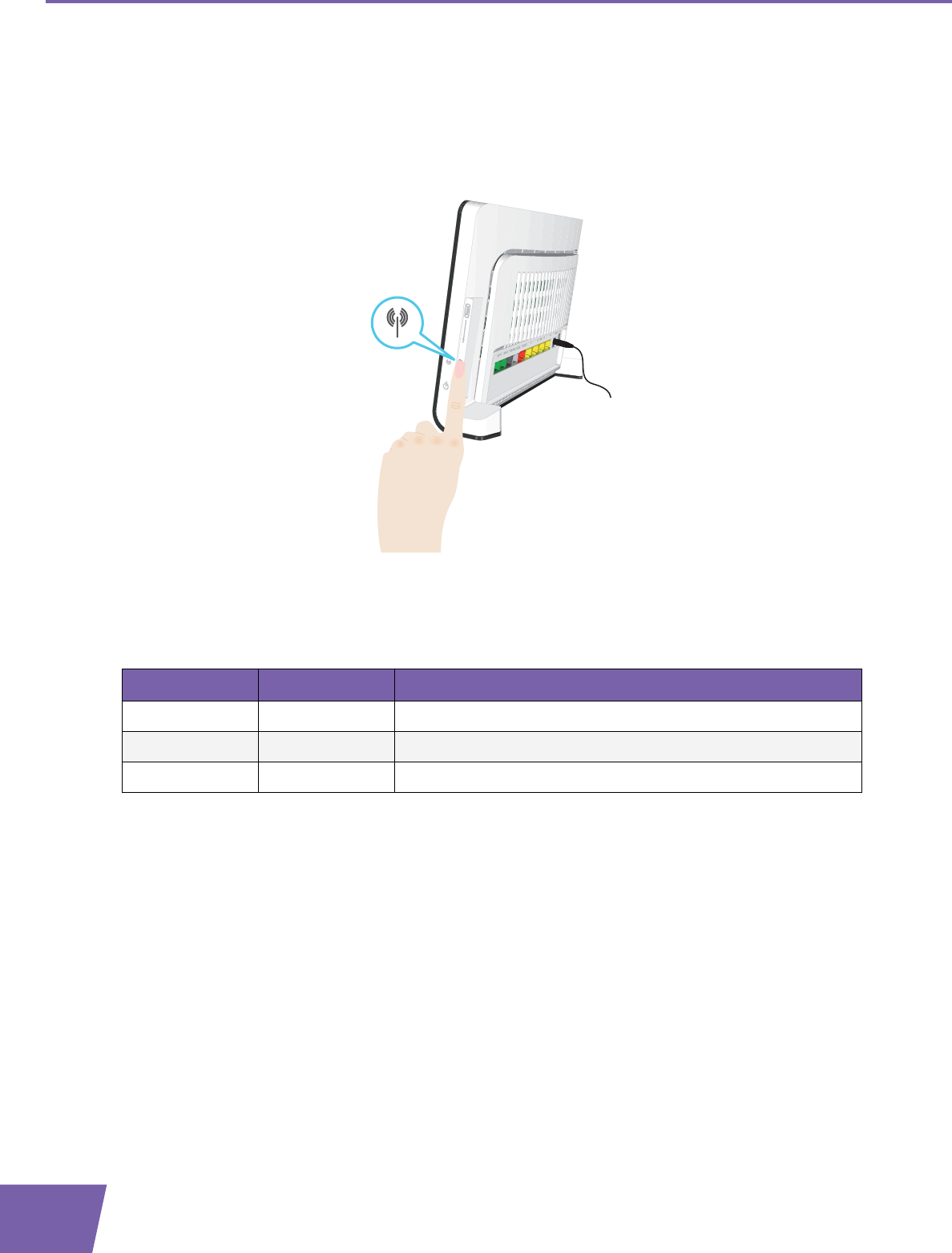
E-DOC-CTC-20080527-0012 v1.0
20
2 Thomson Gateway Basics
2.1.2 WPS Button LED
WPS button
The Wi-Fi Protected Setup (WPS) button allows you to add new wireless clients to your network.
For more information, see “3.1 Connecting Your Wireless Client via WPS” on page 28.
WPS Button LED
Colour State Description
Green Solid On Client successfully registered via WPS
Orange Blinking WPS registration ongoing
Red Blinking Error occurred
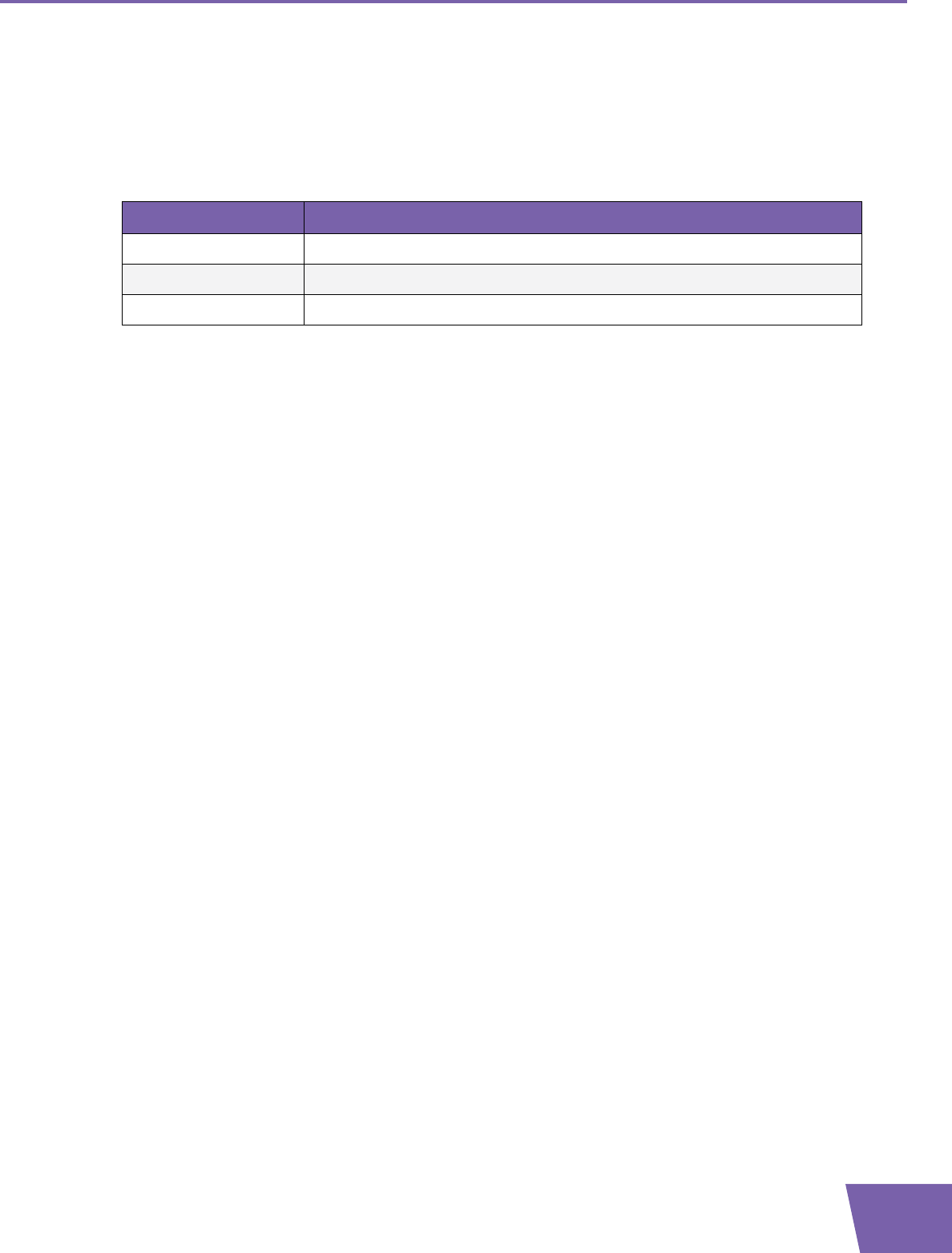
E-DOC-CTC-20080527-0012 v1.0 21
2 Thomson Gateway Basics
2.1.3 Ethernet LEDs
Ethernet LED
A LED may be provided per Ethernet port to indicate link integrity (or activity).
LED Status Description
Off No connection on this port
Solid on Ethernet link up
Blinking Data is flowing from/to this port

E-DOC-CTC-20080527-0012 v1.0
22
2 Thomson Gateway Basics
2.2 Thomson Gateway GUI
Introduction
The Thomson Gateway Graphical User Interface (GIU) allows you to configure your Thomson Gateway using
your web browser.
Requirements
JavaScript must be enabled (this is the default setting) on your browser. For more information, consult the
help of your web browser.
Accessing the Thomson Gateway GUI
Proceed as follows:
1Open your web browser.
2Browse to http://dsldevice.lan or to the IP address of your Thomson Gateway (by default: 192.168.1.254).
3If you have protected your Thomson Gateway with a user name and password, the Thomson Gateway
will prompt you to enter these. Enter your user name and password and click OK.
4The Thomson Gateway GUI appears.
Access the Thomson Gateway via UPnP
You can also access the Thomson Gateway GUI using the Internet Gateway Device (IGD) icon if your
computer runs one of the following operating systems:
Windows 7
Windows Vista
Windows XP
For more information, see “7.1 UPnP” on page 62.
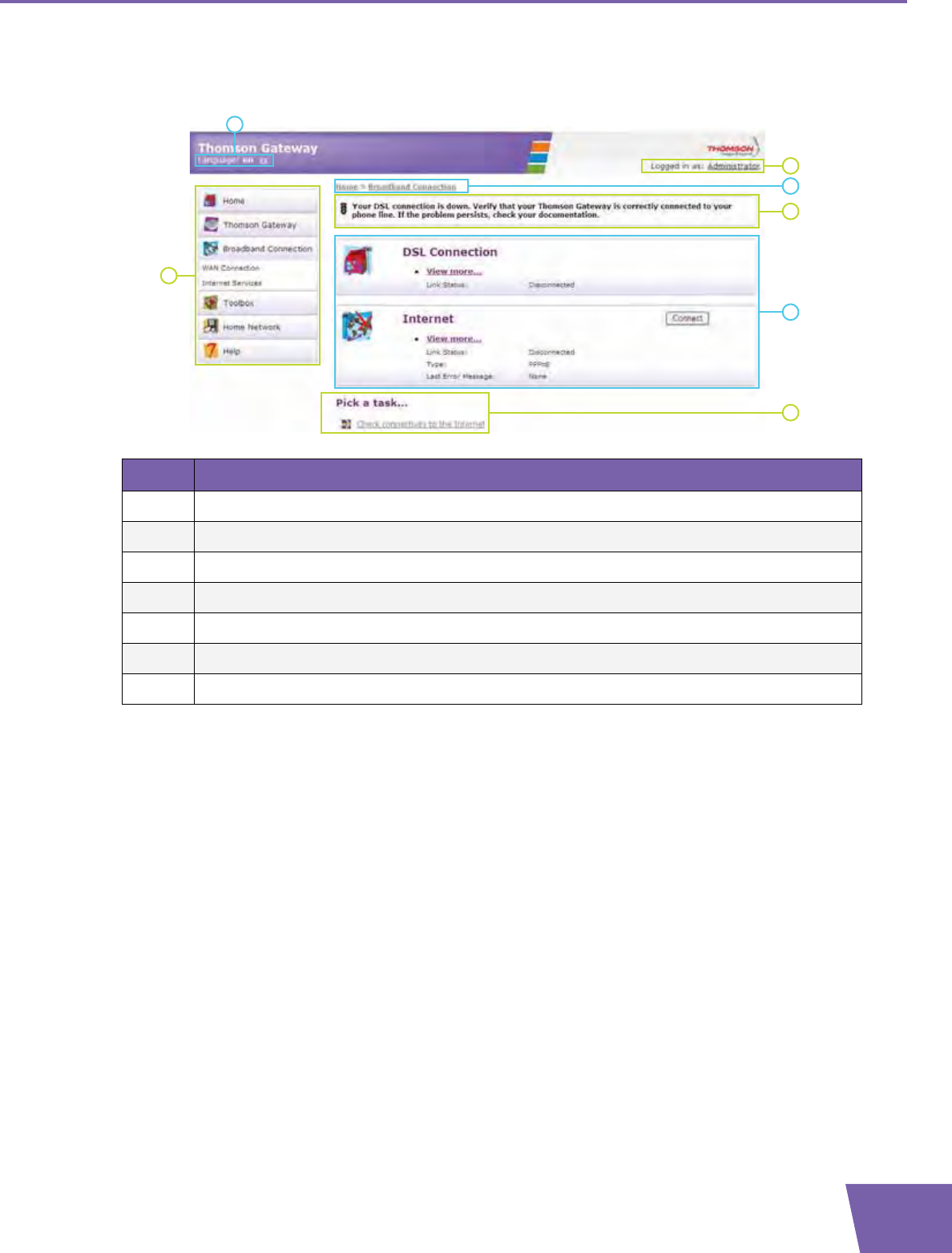
E-DOC-CTC-20080527-0012 v1.0 23
2 Thomson Gateway Basics
Components
All the pages contain following components:
Menu
The menu consists of the following menu items:
Home:
Allows you to go back to the home page.
Thomson Gateway:
Provides basic information on the Thomson Gateway.
Broadband Connection:
Allows you to view/configure your broadband connections.
Toolbox:
Allows you to configure the network services and Internet security settings of your Thomson Gateway.
Home Network:
Allows you to manage your local network.
Help:
Allows you to view context-related help information.
Label Description
1Menu
2Language bar
3Login section
4Navigation bar
5Notification area
6Content pane
7Tasks
1
7
6
5
4
3
2
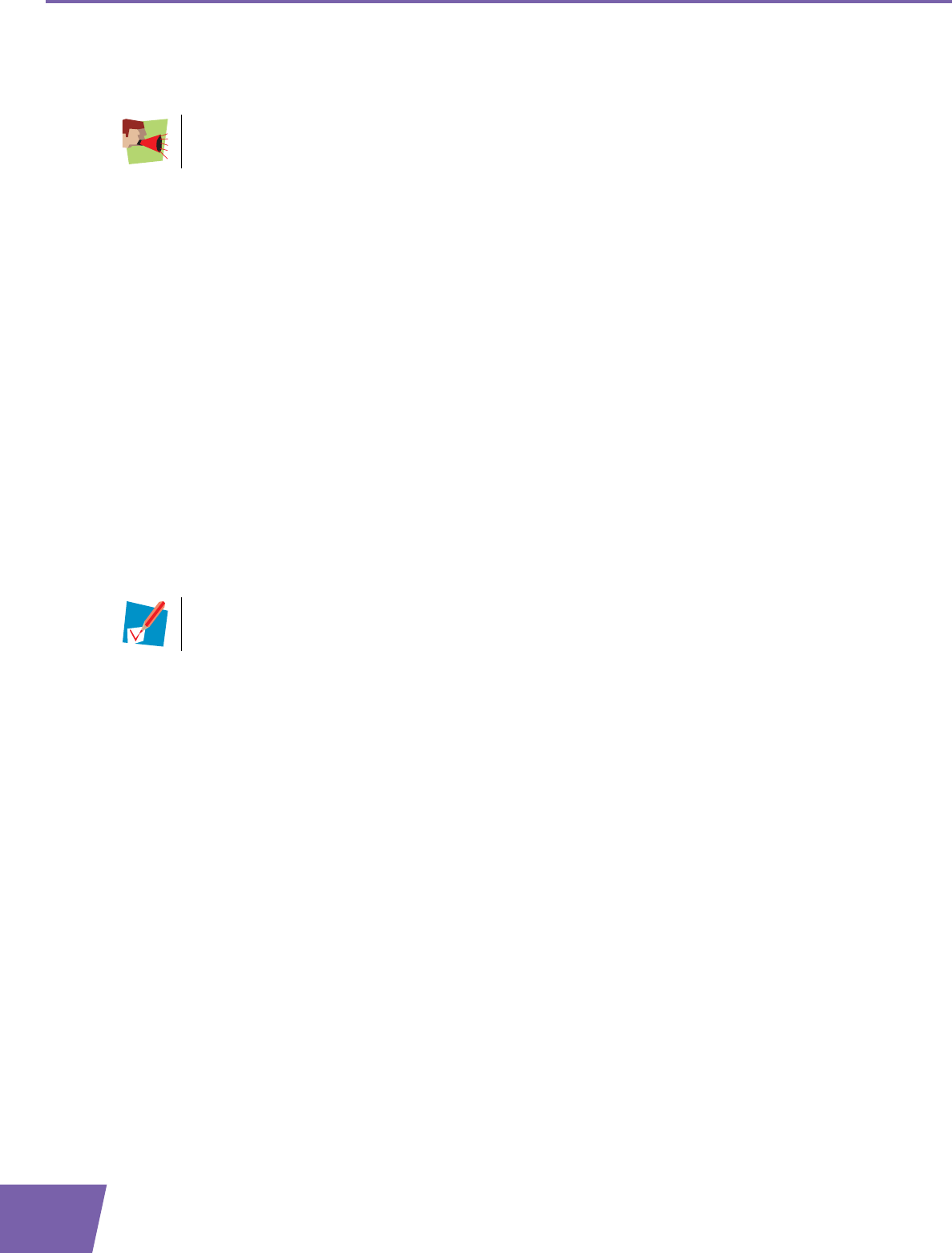
E-DOC-CTC-20080527-0012 v1.0
24
2 Thomson Gateway Basics
Language bar
The language bar allows you to change the language of the Thomson Gateway Web interface.
Login section
In this section you can see the current user name.
By clicking the user name, you can:
Change your password.
Switch to another user.
Navigation bar
The location bar displays your current position on the Thomson Gateway GUI.
Notification area
The notification area is used to display:
Error messages, indicated by a red traffic light.
Warnings, indicated by an orange traffic light.
Information, indicated by a green traffic light.
Content pane
The content pane displays the information and configurable items of the selected item.
Tasks
To allow a quick configuration of your Thomson Gateway, some pages may offer you a number of related
tasks in the Pick a task list. These tasks will guide you to the page where you can perform the selected task.
The language bar will only be shown if more than one language is available.
If none of these events occur, the notification area will not be shown.

E-DOC-CTC-20080527-0012 v1.0 25
2 Thomson Gateway Basics
2.3 Backing Up/Restoring your Configuration
Introduction
Once you have configured your Thomson Gateway to your needs, it is recommended to backup your
configuration for later use. This way you can always return to your working configuration in case of
problems.
Backing up your configuration
Proceed as follows:
1Browse to the Thomson Gateway GUI.
2On the Thomson Gateway menu, click Configuration.
3In the Pick a task list, click Save or Restore Configuration.
4Under Backup current configuration, click Backup Configuration Now.
5The Thomson Gateway prompts you to save your backup file.
6Save your file to a location of your choice.
Warning
Do not edit the backup files, this may result in corrupt files making them worthless as a configuration backup.
Restoring your configuration
Proceed as follows:
1Browse to the Thomson Gateway GUI.
2On the Thomson Gateway menu, click Configuration.
3In the Pick a task list, click Save or Restore Configuration.
4Under Restore saved configuration, click Browse.
5Browse to your backup file and open it.
6The Thomson Gateway restores your configuration.
These files usually have .ini as extension.

E-DOC-CTC-20080527-0012 v1.0
26
2 Thomson Gateway Basics

E-DOC-CTC-20080527-0012 v1.0 27
3 Wireless Access
3 Wireless Access
Introduction
With the built-in wireless access point you do no longer need a cable connection between your computer and
your Thomson Gateway.
What you need to set up a wireless network
To set up a wireless network, you need the following components:
AWireless Access Point (integrated into your Thomson Gateway)
AWireless client
Wireless Access Point
You can consider the wireless access point as the heart of your wireless network. The wireless access point:
Connects different wireless devices with each other.
Secures the data sent over wireless connection.
The Thomson Gateway comes with an integrated wireless access point.
Wireless client
The wireless client allows you to connect a device, typically a computer, to a wireless access point. Both built-
in and external (for example via USB) clients are available.
Check the documentation of your computer if you are not sure if your computer is equipped with a wireless
client.
Configuring your wireless clients
Before you can start surfing the internet with a wireless connection, you must first connect your wireless
client to your Thomson Gateway wireless access point.
For more information, see “3.1 Connecting Your Wireless Client via WPS” on page 28 and “3.2 Connecting
Your Wireless Client without WPS” on page 30.
Secure your wireless connection!
Because you no longer need a physical connection, everyone who is within the range of your Thomson
Gateway can access your network. If you do not protect your wireless network, the following could happen:
People can use your connection to access the Internet.
Hackers can use your connection to commit computer crimes.
You can easily prevent this by securing your wireless connection. For more information, see “3.3 Securing
Your Wireless Connection” on page 31.
Other devices like media players and smartphones may also have a built-in wireless client. Check
the documentation of your device for more information.
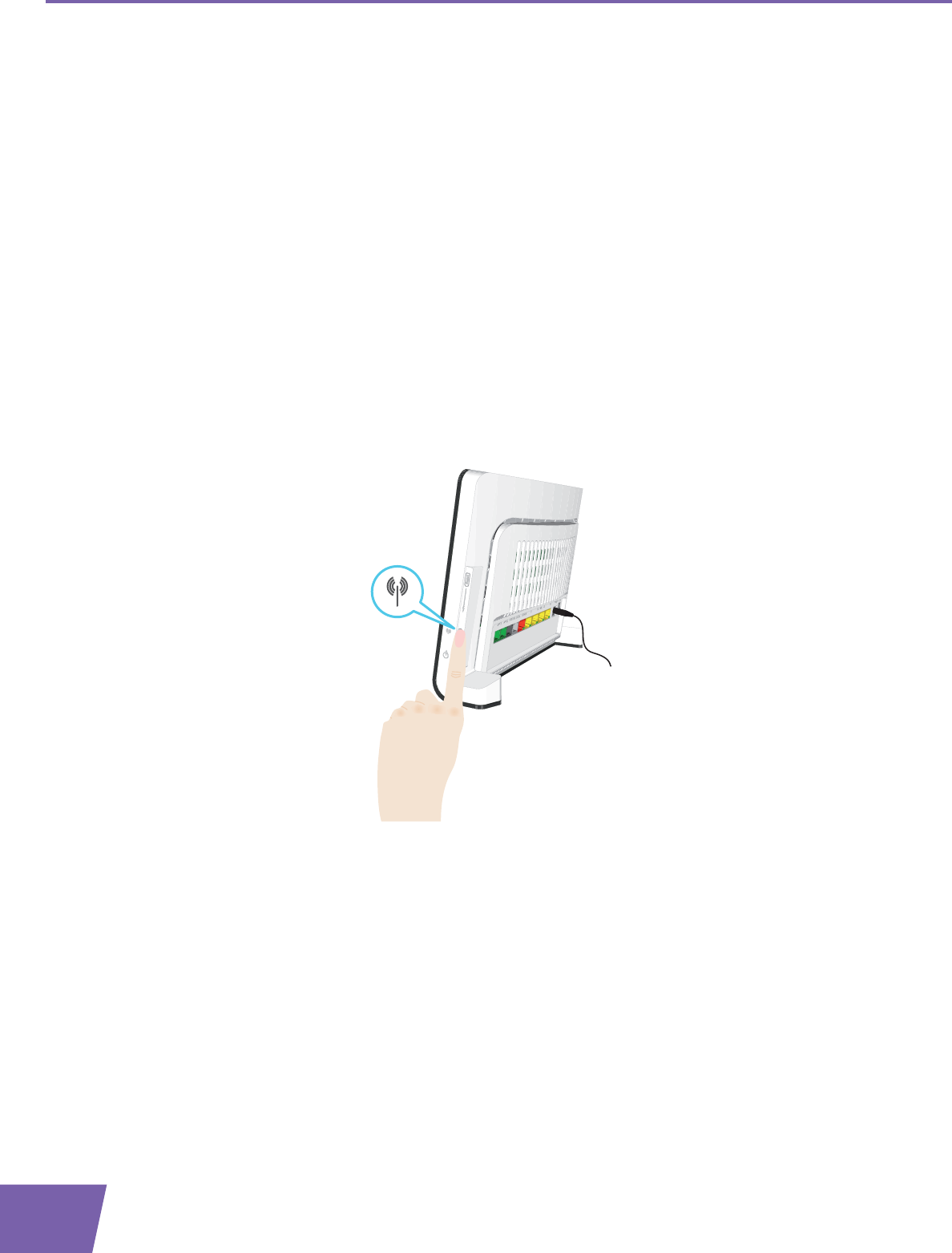
E-DOC-CTC-20080527-0012 v1.0
28
3 Wireless Access
3.1 Connecting Your Wireless Client via WPS
WPS
Wi-Fi Protected Setup (WPS) allows you to add new wireless clients to your network in a swift and easy way,
without the need to enter all your wireless settings (network name, wireless key, encryption type).
Requirements
Your wireless client must support WPS. Check the documentation of your wireless client for this.
Your Thomson Gateway must use WPA(2)-PSK encryption (default encryption) or no encryption. WPS
with WEP encryption is not possible.
Procedure
Proceed as follows:
1Shortly press the WPS button on the Thomson Gateway:
2The WPS button LED starts blinking orange. This indicates that the Thomson Gateway is now searching
for wireless clients that are in registration mode. You now have two minutes to start WPS on your
wireless client.
3Start WPS on your wireless client.
The WPS button LED is solid green
This indicates that you have successfully registered your wireless client. You are now connected to the
Thomson Gateway network.

E-DOC-CTC-20080527-0012 v1.0 29
3 Wireless Access
The WPS button LED is blinking red
This indicates that the Thomson Gateway could not find your wireless client. Make sure that the WPS button
LED is blinking orange when you start WPS on your wireless client.
Troubleshooting
If you are having trouble connecting your wireless client via WPS, try to configure it manually. For more
information, see “3.2 Connecting Your Wireless Client without WPS” on page 30.

E-DOC-CTC-20080527-0012 v1.0
30
3 Wireless Access
3.2 Connecting Your Wireless Client without WPS
Before you start
Before you can connect a computer to your wireless network you need to know the wireless settings that are
currently used by the Thomson Gateway, i.e.:
The Network Name (SSID)
The wireless key
What Network Name (SSID) is my Thomson Gateway using?
If you did not change the SSID manually, your Thomson Gateway uses the Network Name that is printed on
the back panel label of your Thomson Gateway.
What wireless security is my Thomson Gateway using?
You have not yet configured your Thomson Gateway
In this case, no wireless key is used.
You have already configured your Thomson Gateway using the Guided Installation
If you choose to use the wireless settings proposed by the Setup wizard, you can find the wireless key on the
label on the back of your Thomson Gateway.
Forgot your wireless settings?
If you have changed the wireless settings manually and you can’t remember your settings, try one of the
following:
If one of your computers is already connected to your network:
1Browse to the Thomson Gateway GUI on that computer.
2On the Home Network menu, click Wireless.
3In the upper-right corner, click Details.
4Under:
Configuration, you can find the network name (SSID).
Security, you can find the encryption.
If none of your computers is connected to your network, connect a computer using a wired connection
and follow the procedure above to find out what your wireless settings are.
The last option is to reset your Thomson Gateway (all your changes will be lost!) and reconfigure it. For more
information, see “9.6 Reset to Factory Defaults” on page 85.
Procedure
Configure your computer with the same wireless settings as your Thomson Gateway. For more information,
consult the documentation of your wireless client.

E-DOC-CTC-20080527-0012 v1.0 31
3 Wireless Access
3.3 Securing Your Wireless Connection
Introduction
By using encryption, you can protect the wireless communication between the wireless clients and your
Thomson Gateway with a wireless key. This way, only clients which use the correct Network Name (SSID)
and wireless key can connect to your network.
Encryption types
Over the years a number of encryption types have been developed. The list below gives you an overview of
the supported encryption types ordered by descending security level, you will find the highest level of
security at the top of the list:
WPA-PSK Encryption:
The wireless data is being encrypted with a user-defined key. Wireless clients must be configured with
this key before they can connect to the Thomson Gateway.
WEP Encryption:
The first encryption type used for wireless connections. Like WPA-PSK it uses a user-defined key, but WEP
has been proven to have some security issues. We strongly recommend you to use WPA-PSK instead.
Which encryption type should I use?
We strongly recommend you to WPA-PSK.
Although the Thomson Gateway allows you to use WEP or no security, it is not recommended to use these
settings. Only use WEP if you have wireless clients that don’t support a higher encryption level.
Configuring the wireless encryption
Proceed as follows:
1Open the Thomson Gateway GUI.
2On the left menu, click Home Network.
3Under Wireless, click your access point.
Your access point is listed in the following format: “WLAN:<Network Name> (<Actual Speed>)”. For
example, WLAN: Thomson83C7C7 (54Mbps).
4The Wireless Access Point page appears.
5In the Navigation bar, click Configure.
6Under Security, you can change the Encryption. If you want to use:
WPA-PSK encryption, continue with “3.3.1 Configuring WPA-PSK Encryption” on page 32.
WEP encryption, continue with “3.3.2 Configuring WEP Encryption” on page 33.

E-DOC-CTC-20080527-0012 v1.0
32
3 Wireless Access
3.3.1 Configuring WPA-PSK Encryption
Procedure
Continuing from “Configuring the wireless encryption” on page 31:
1Select Use WPA-PSK Encryption.
2In the WPA-PSK Encryption Key box, type a the key of your choice. The key must be in one of the
following formats:
8 to 63 alphanumeric characters. For example: MyKey123
8 to 64 hexadecimal characters (characters from 0 to 9 and from A to F). For example: C54F48A5.
3In the WPA-PSK Version list, click the WPA-version of your choice. Following options are available:
WPA2:
WPA2 is the most secure version, but not all wireless clients already support it. Before you select this
version, make sure all of your wireless clients support it.
WPA+WPA2:
If not all of your wireless clients support WPA2 or you are not sure if they support WPA2, we
recommend you to choose WPA+WPA2. Wireless clients that support WPA2 will use WPA2, the
others will use WPA.
WPA:
If none of your wireless clients support WPA2 choose this option.
4Click Apply.
5Configure your wireless client(s) with the same settings.
If you want to configure WPA2 on the built-in wireless utility of Windows XP Service Pack 2
(SP2), you first have to:
Upgrade your Windows XP to Service Pack 3.
- or -
Install the following update: http://support.microsoft.com/kb/917021.

E-DOC-CTC-20080527-0012 v1.0 33
3 Wireless Access
3.3.2 Configuring WEP Encryption
Warning
Although the Thomson Gateway allows you to use WEP or no security, it is not recommended to use these
settings. Only use WEP if you have wireless clients that do not support any higher encryption levels.
Procedure
Continuing from “Configuring the wireless encryption” on page 31:
1Select Use WEP Encryption
2In the WEP Key Length list, click the desired key length (a higher key length offers higher security).
3In the Encryption key box, type a Network key of your choice. If you are using:
A 64-bit key:
Type 10 hexadecimal characters (characters from 0 to 9 and from A to F) or 5 alphanumeric
characters.
A 128-bit key:
Type 26 hexadecimal characters (characters from 0 to 9 and from A to F) or 13 alphanumeric
characters.
4Click Apply.
5Configure your wireless client(s) with the same settings.

E-DOC-CTC-20080527-0012 v1.0
34
3 Wireless Access
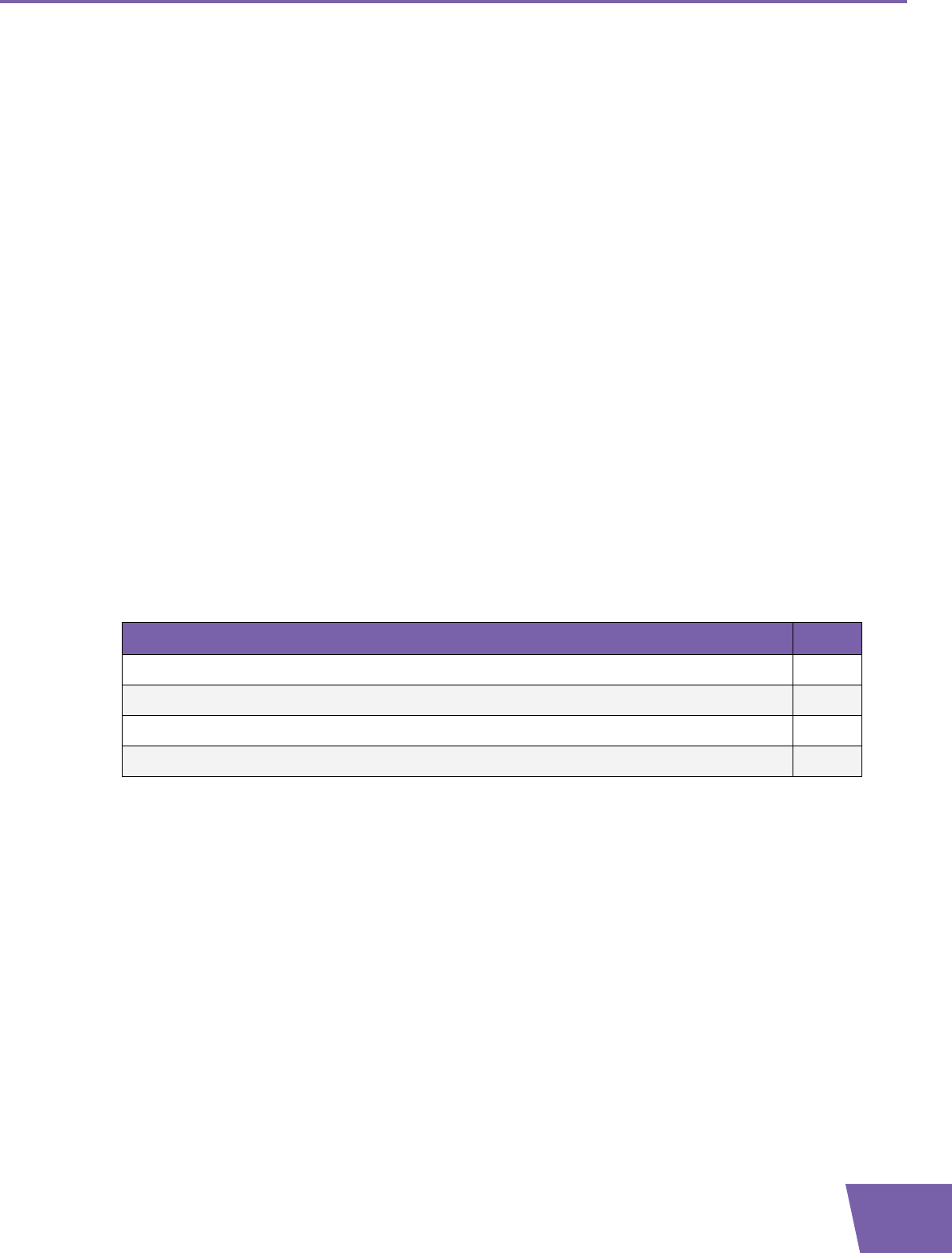
E-DOC-CTC-20080527-0012 v1.0 35
4 Telephony
4 Telephony
Voice over IP (VoIP)
VoIP is a technology in which telephone calls are made over the Internet. This allows you to save on
communication costs, especially for long-distance calls.
The expensive solution
To be able to make your phone calls over the Internet you could:
Buy an IP phone.
These IP phones are special phones that you can connect to your Internet Gateway.
Install VoIP software on your computer and make your phone calls via your computer.
The THOMSON solution
With the Thomson Gateway you can make both VoIP and traditional telephone calls using a traditional
analogue phone or
If your Thomson Gateway is not powered, the traditional telephone network (if connected) will automatically
selected. This way you are still able to make emergency calls.
In this chapter
This chapter covers following topics:
Topic Page
Setting Up Your Telephone Network 36
Address Book 41
Telephony Services 42
Viewing Telephony Statistics 48

E-DOC-CTC-20080527-0012 v1.0
36
4 Telephony
4.1 Setting Up Your Telephone Network
Procedure
To set up your Thomson Gateway successfully, you must follow the following steps:
1Connect your traditional phone(s) or fax to the green Phone port(s) on the Thomson Gateway’s back
panel.
2Connect your Thomson Gateway to the traditional network.
For more information, see “4.1.1 Connection to the Traditional Telephone Network” on page 37.
3Configure the VoIP service on your Thomson Gateway.
For more information, see “4.1.2 Configuring the Thomson Gateway VoIP Settings” on page 38.
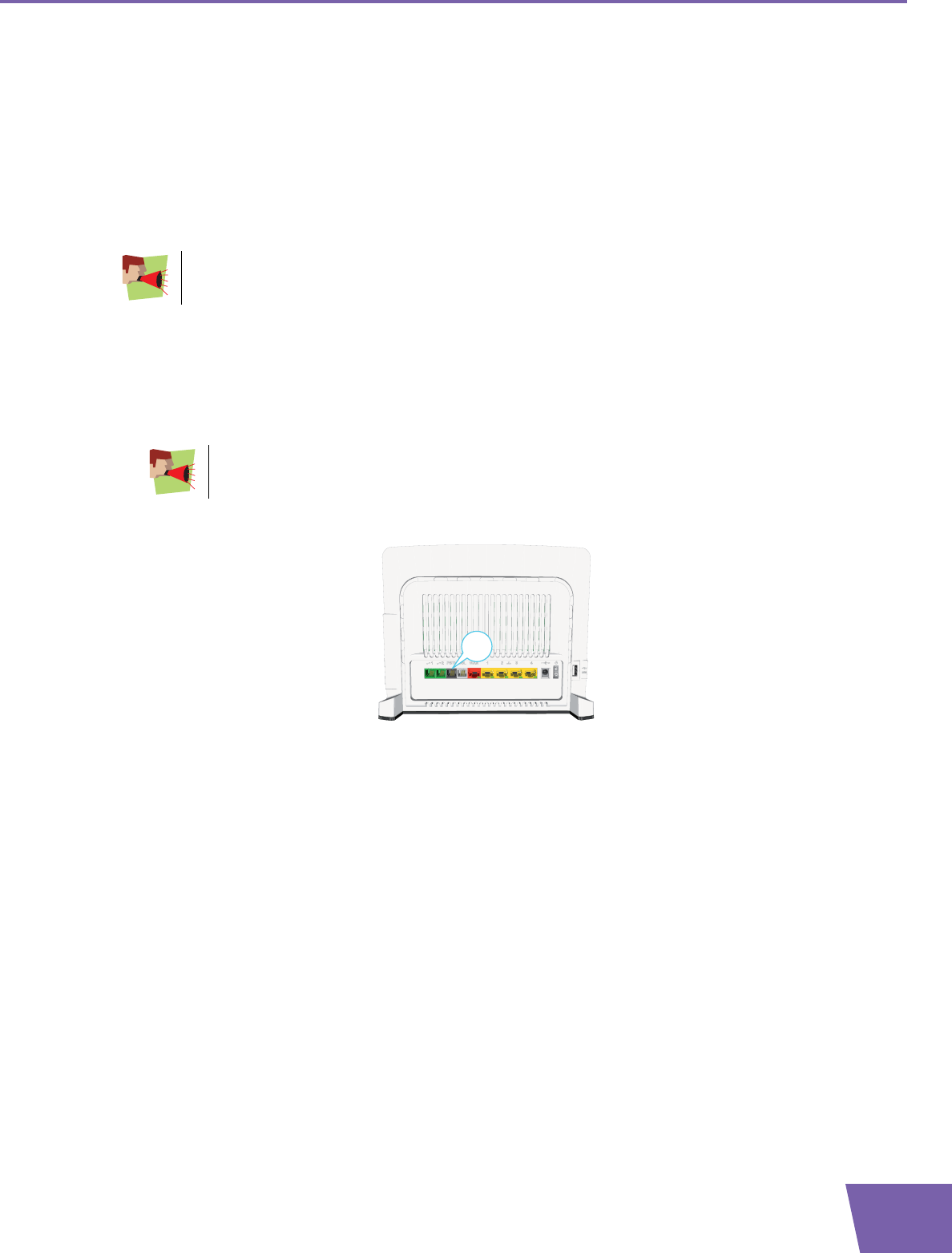
E-DOC-CTC-20080527-0012 v1.0 37
4 Telephony
4.1.1 Connection to the Traditional Telephone Network
Combining VoIP with the traditional telephone network
The Thomson Gateway allows you to use both the traditional telephone network (PSTN) as the VoIP network
on the same device.
This way, you can still make calls over the traditional network if the VoIP service is down (e.g. your Thomson
Gateway is powered off).
What do I have to do to configure this?
If your Thomson Gateway:
Does not have a PSTN port on its back panel then the Thomson Gateway has an integrated filter. Both
DSL and PSTN are coming in via the DSL port, so no extra connections are needed.
Has a PSTN port on its back panel you have to connect this port to the Phone output of your filter or
splitter:
For more information about filters and splitters, see “Filters and splitters” on page 5.
Be aware that, if you are not connected to the traditional telephone network, emergency calls will
not be possible when your Internet connection is down or your Thomson Gateway is powered off.
In this case the DSL port must be directly connected to your telephone outlet. Do not put any
filter or splitter between them!
PSTN

E-DOC-CTC-20080527-0012 v1.0
38
4 Telephony
4.1.2 Configuring the Thomson Gateway VoIP Settings
Introduction
If you configured your Thomson Gateway using the Guided Installation, the VoIP settings may already be
configured by the Setup wizard.
If you choose to configure your Thomson Gateway manually or you still need to configure the VoIP settings,
you can follow the procedure below.
How can I check if the VoIP settings have already been configured?
If the Phone LED is:
Solid or blinking green then the telephony service has already been configured. No configuration is
needed.
Off then telephony service is not yet configured. Follow the instructions below.
Requirements
Your Internet connection must be up and running before you can configure Internet telephony.
Configuring the VoIP settings
Proceed as follows:
1Enter the proxy and registrar settings.
2Enter your VoIP account settings.
Enter the proxy and registrar settings
Proceed as follows:
1Browse to the Thomson Gateway GUI.
2On the Toolbox menu, click Telephony.
3In the Navigation bar, click Expert configure.
4Complete the following fields with the settings provided by your VoIP provider:
Proxy:
Type the URL (for example: sip.provider.com) or IP address of the proxy.
Registrar:
Type the URL (for example: sip.provider.com) or IP address of the registrar.
Registrar Port and Proxy Port.
In most cases the default port (5060) will be used. Only change these values if your provider is using
other port numbers.
5Click Apply.
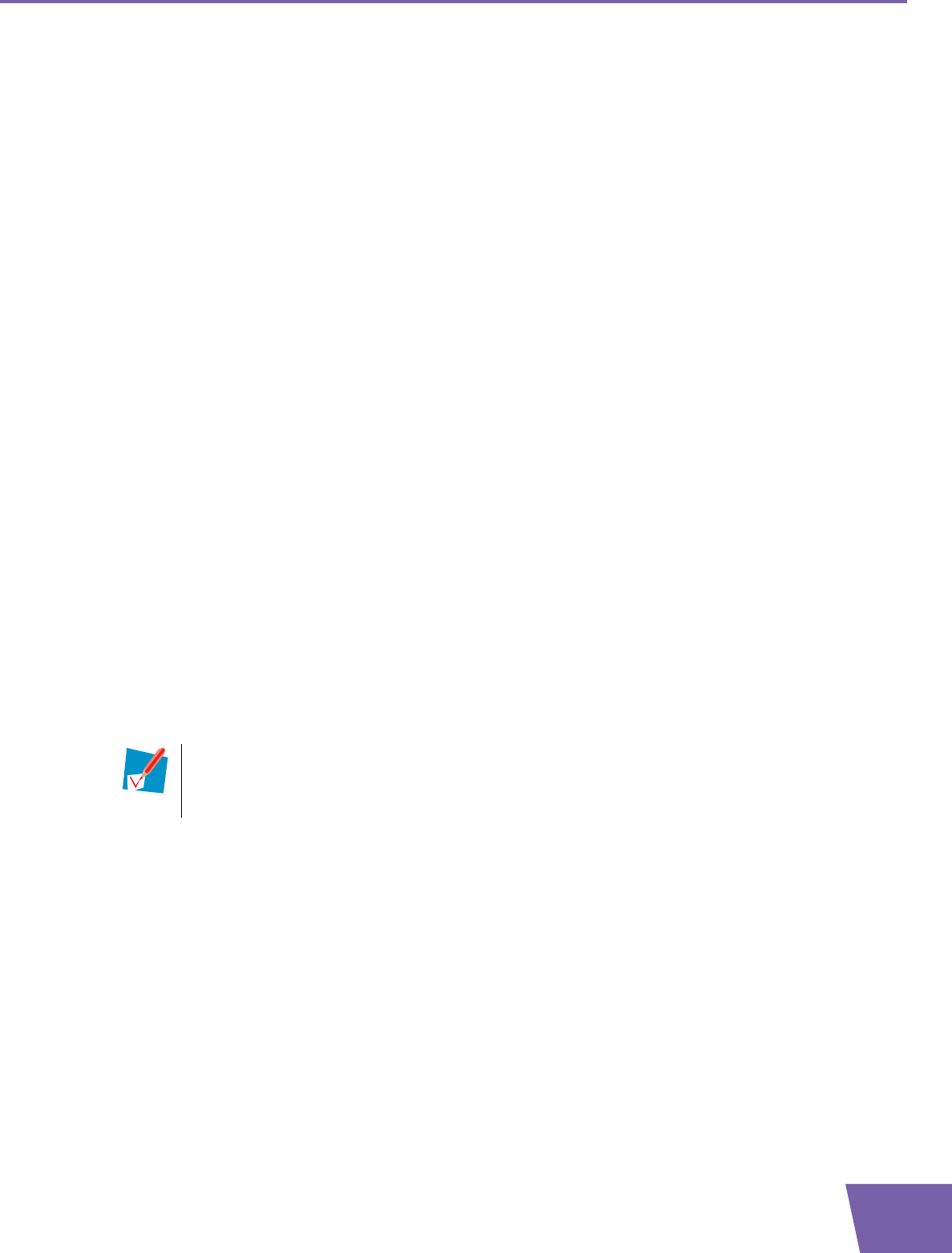
E-DOC-CTC-20080527-0012 v1.0 39
4 Telephony
Enter your VoIP account settings
Proceed as follows:
1In the Navigation bar, click Configure.
2Under Service Configuration, select Enable Telephony.
3Under Telephone Numbers, complete the following fields:
SIP URI:
The Uniform Resource Identifier (URI) of your SIP account (for example: 050579, john.doe,...). This is
the telephone number that people have to dial to call you.
Username:
The user name of your VoIP account (for example: 050579, john.doe,...).
Password:
The password of your VoIP account.
Displayname:
The name that you want people to see on the phone’s screen when you are calling. Your VoIP
provider may not support this feature.
Abbreviated number:
An internal number to call the phones associated with this VoIP account.
Port:
The phone port that you want to associate with this VoIP account. If you want to use the same VoIP
account for all ports, select Port ‘All’.
4Click Apply.
Verifying Telephone Connectivity
Proceed as follows to verify the voice connection:
1Make sure the Thomson Gateway is turned on.
2Check whether your phone is properly attached to the Thomson Gateway.
3Make sure the Internet telephony service is enabled and configured.
4The Phone LED must be solid green.
5Pick up your phone, wait for the dialling tone, and dial the number. If you dial a ‘#’ after the phone
number, the phone number will be called over the traditional telephone network.
Multiple Identities
You can assign up to three Internet telephone numbers or URIs to one or both phone ports, or you can assign
a common number to both phone ports.
Using Multiple Identities
Proceed as follows:
1Browse to the Thomson Gateway GUI.
2On the Toolbox menu, click Telephony.
3In the Navigation bar, click Configure.
4In the Pick a task list,click Use multiple identities.
The phone(s) attached to the Thomson Gateway can only receive incoming VoIP calls, as long as
your Thomson Gateway is turned on and the Phone LED is lit.
For calls over the traditional telephone, your phones are line-powered by the telephone company
and can therefore always be reached, even if the Thomson Gateway is turned off.

E-DOC-CTC-20080527-0012 v1.0
40
4 Telephony
5Click Add.
6Enter another URI, your user name and password.
7Choose the phone port for which you want to use this telephone number.
8Click Apply.
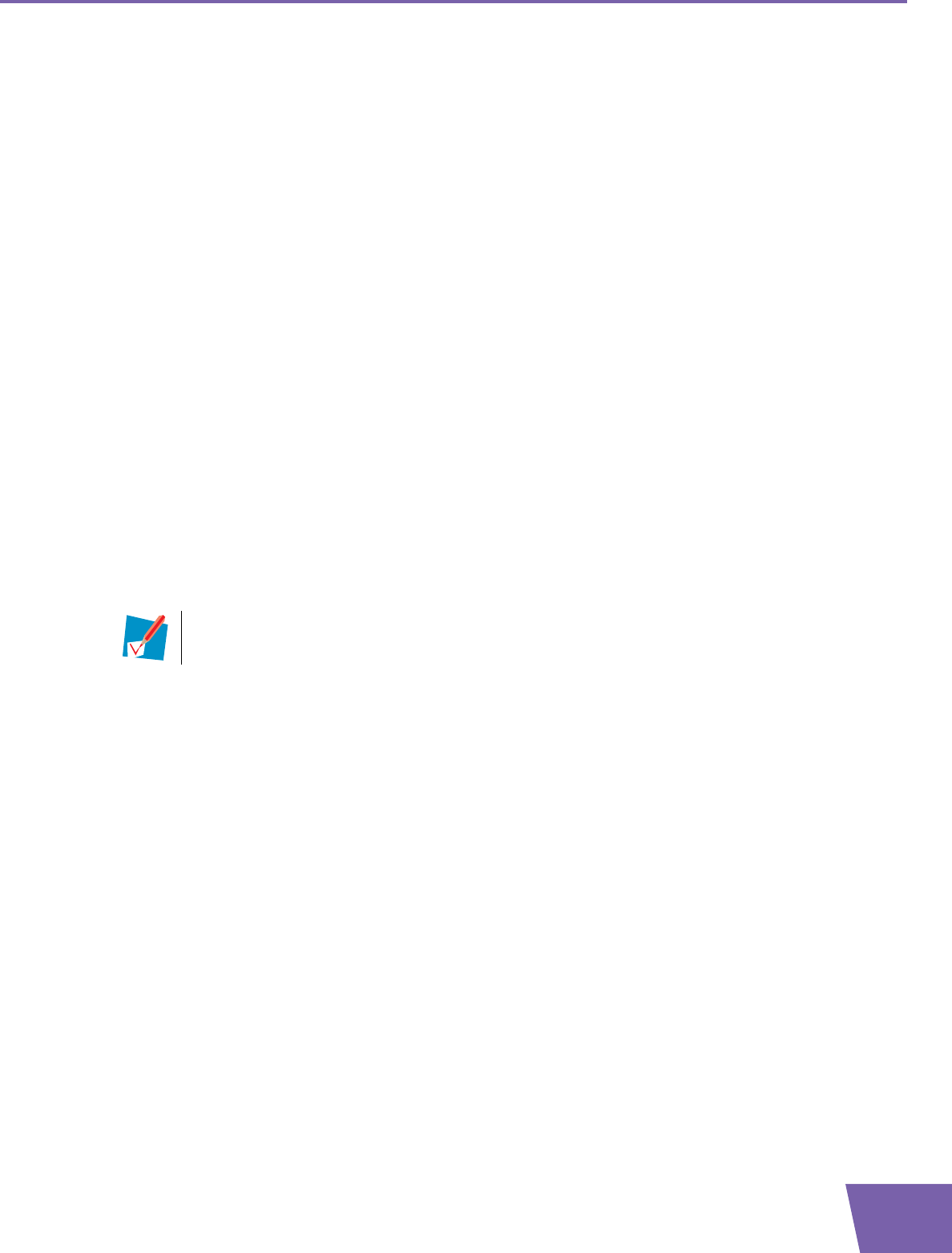
E-DOC-CTC-20080527-0012 v1.0 41
4 Telephony
4.2 Address Book
Introduction
The Address Book page is located on the Thomson Gateway GUI and allows you to:
Store your contacts on the Thomson Gateway GUI.
Initiate a call or send a message by clicking the phone number or e-mail address in the contact details.
Accessing the Address Book page
Proceed as follows:
1Browse to the Thomson Gateway GUI.
2On the Toolbox menu, click Address Book.
3The Address Book page appears.
Managing contacts
To:
Add a contact, click Add.
Edit a contact, click Edit.
Delete a contact, click Delete.
All information provided per contact is optional except for the last and first name, and can be updated or
completed at any time.
Using the Address book
The contact details of a contact in your Address book allow you to directly make a call or send a message
from out the Thomson Gateway web interface.
Per contact you can click (if available):
Business: to make a call to the contact’s business telephone number
Home: to make a call to the contacts home telephone number
Mobile: to make a call to the contact’s mobile telephone number
Other or SIP uri: to make a call to the contact’s VoIP telephone number
E-mail to send an E-mail message to the contact with your e-mail client.
The Address book resides on the Thomson Gateway, so everyone with access to the Thomson
Gateway web interface can view and use the Address book.

E-DOC-CTC-20080527-0012 v1.0
42
4 Telephony
4.3 Telephony Services
Introduction
Telephony services add extra functionality to your phone. For example: putting a call on hold, transferring
calls,...
Requirements
Before you can use a service, it:
1Must be supported by your service provider.
For more information, see “4.3.1 Services supported by Your Service Provider” on page 43.
2Must be activated on your Thomson Gateway.
For more information, see “4.3.2 Activating a Telephony Service on your Thomson Gateway” on page 44.
Only if these two conditions are met, you will be able to use all functions associated to the service. For more
information, see “4.3.3 Using Telephony Services” on page 45.

E-DOC-CTC-20080527-0012 v1.0 43
4 Telephony
4.3.1 Services supported by Your Service Provider
Procedure
To see which services are supported by your provider:
1Browse to the Thomson Gateway GUI.
2On the Toolbox menu, click Telephony.
3In the Navigation bar, click Configure.
4In the Pick a task list, click View Telephony Services.
5Under Telephony Services, you can see the services that are supported by your provider.
Activation
If you want to use one of the supported services, make sure it is activated. For more information, see
“4.3.2 Activating a Telephony Service on your Thomson Gateway” on page 44.
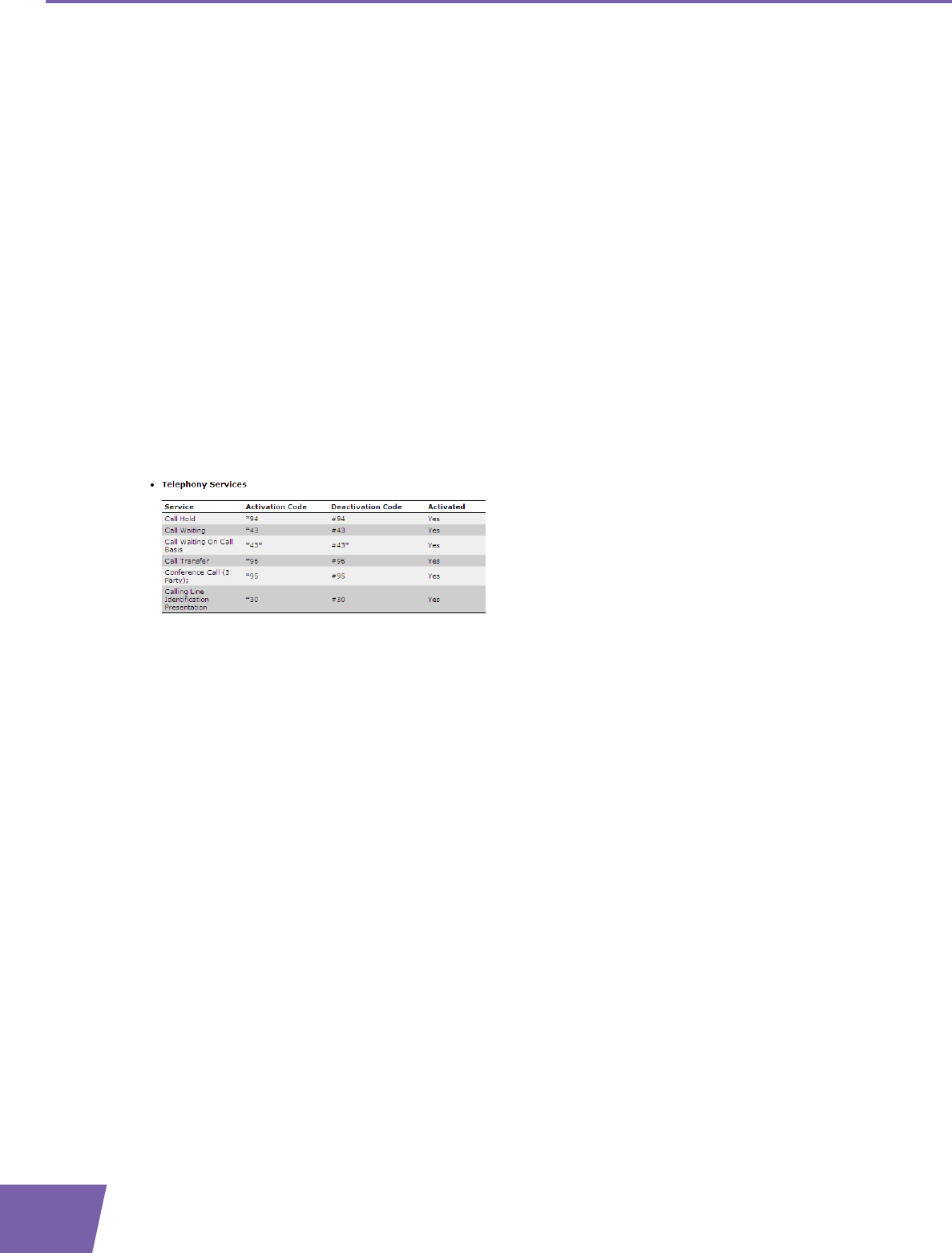
E-DOC-CTC-20080527-0012 v1.0
44
4 Telephony
4.3.2 Activating a Telephony Service on your Thomson Gateway
How can I (de)activate a service on my Thomson Gateway?
You can (de)activate services in two ways:
Via (de)activation codes on your phone.
Via the Thomson Gateway GUI.
Activating a Telephony Service via Your Phone
Where can I find the (de)activation codes?
Proceed as follows:
1Browse to the Thomson Gateway GUI.
2On the Toolbox menu, click Telephony.
3In the Navigation bar, click Configure.
4In the Pick a task list, click View Telephony Services.
5In the Telephony Services table, you can find the activation and deactivation codes.
Using the codes
To (de)activate one of the services just dial the corresponding code on your phone.
For example, to activate Call Hold dial *94; to deactivate the service dial #94.
Activating a Telephony Service via the Thomson Gateway GUI
Proceed as follows:
1Browse to the Thomson Gateway GUI.
2On the Toolbox menu, click Telephony.
3In the Navigation bar, click Configure.
4In the Pick a task list, click View Telephony Services.
5In the Navigation bar, click Configure.
6To:
Activate a service select the check box next to the service.
Deactivate a service clear the check box next to the service.
7Click Apply.
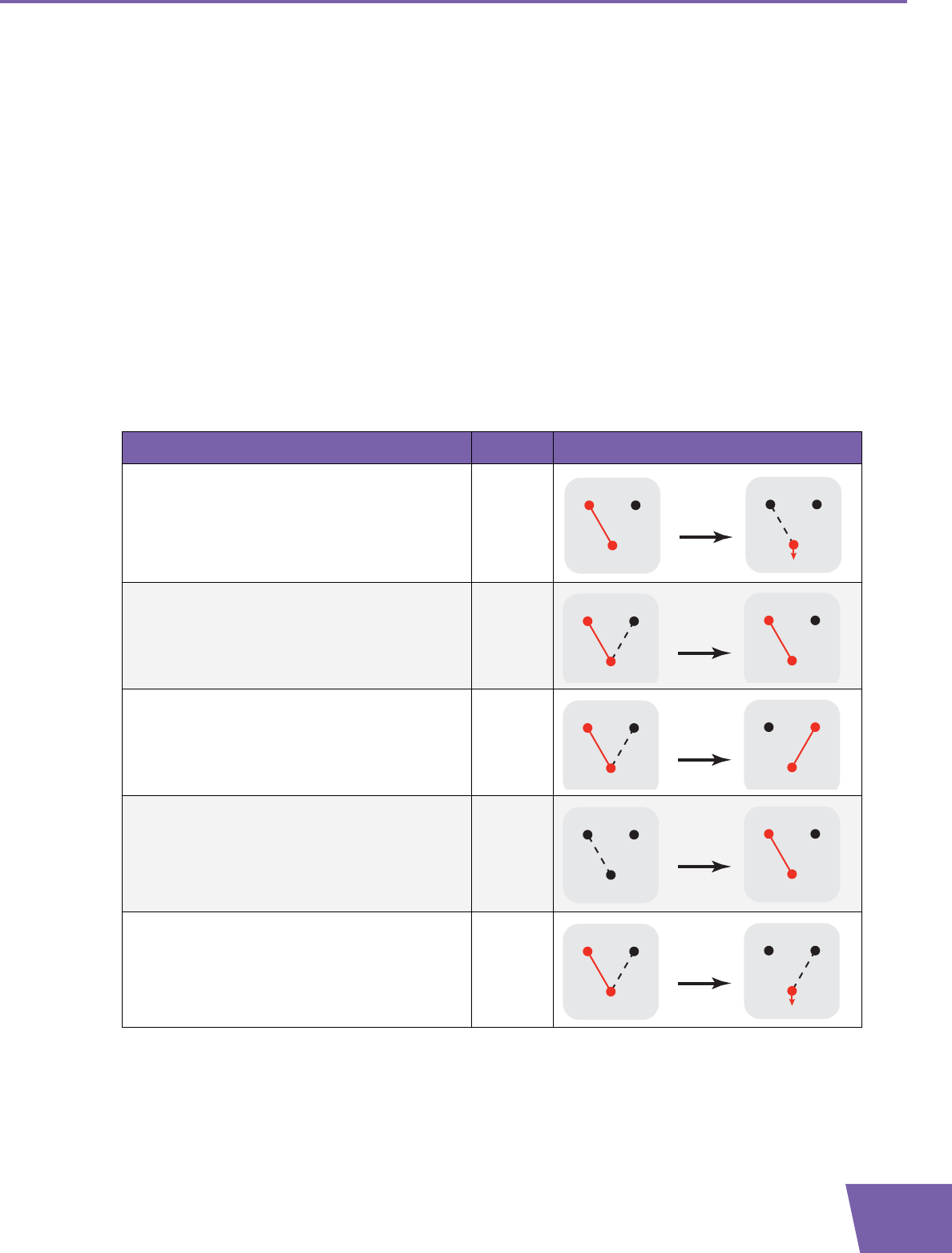
E-DOC-CTC-20080527-0012 v1.0 45
4 Telephony
4.3.3 Using Telephony Services
Introduction
This section provides an overview of the functions that will be available if you activate one of the following
services:
Call Hold service
Call Waiting service
Conference Call (3 Party) service
Call Transfer
For more information on the other services, please contact your service provider.
Call Hold service
If the Call Hold service is activated, you can use the following functions:
To... Press... Illustration
Put an active call on hold and enable a call set up
(the dial tone is generated)
R, 2
Terminate the call on hold R, 0
Terminate an active call and switch to the call on
hold
R, 1
Retrieve the call on hold (when there is no active
call)
R, 1
Terminate an active call and enables a call set up
(the dial tone is generated)
R, 9
BA
You
on hold
dial tone
BA
You
active
You press
R, 2
BA
You
active
BA
You
active on hold
You press
R, 0
BA
You
active
BA
You
active on hold
You press
R, 1
BA
You
active
BA
You
on hold
You press
R, 1
BA
You
dial tone
on hold
BA
You
active on hold
You press
R, 9
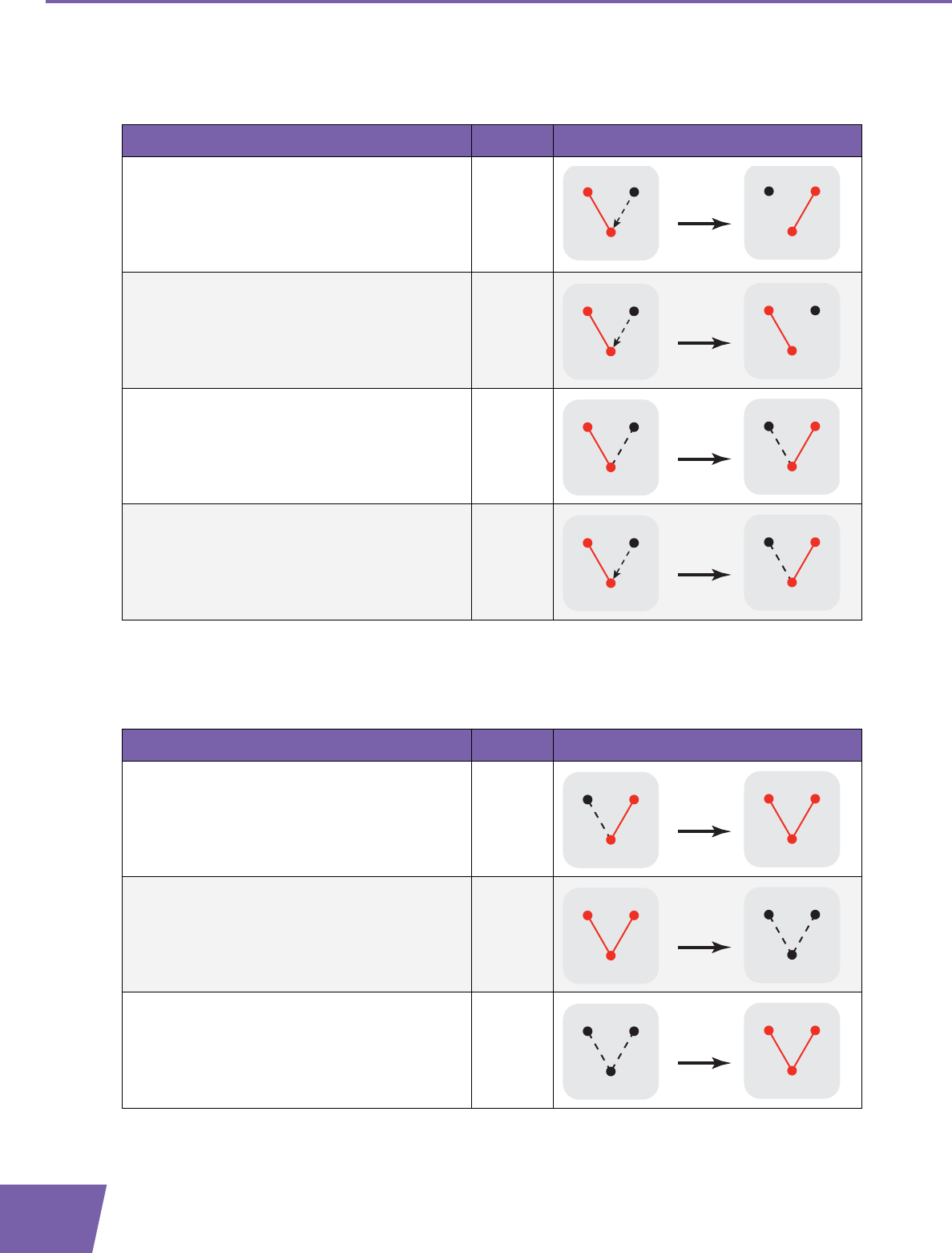
E-DOC-CTC-20080527-0012 v1.0
46
4 Telephony
Call Waiting service
If the Call Waiting service is activated, you can use the following functions:
Conference Call (3 Party) service
If the Conference Call (3 Party) service is activated, you can use the following functions:
To... Press... Illustration
Terminate an active call and switch to an
incoming call
R, 1
Reject an incoming call R, 0
Switch between an active call and a call on hold R, 2
Switch between an active call and an incoming
call
R, 2
BA
You
active
BA
You
active incoming
You press
R, 1
BA
You
active
BA
You
active incoming
You press
R, 0
BA
You
on hold active
BA
You
active on hold
You press
R, 2
BA
You
on hold active
BA
You
active incoming
You press
R, 2
To... Press... Illustration
Establish a conference call (or 3 party
connection)
R, 3
During a conference call: put B and C on hold R, 2
During a conference call: retrieve B and C when
they are on hold
R, 3
BA
You
active active
BA
You
on hold active
You press
R, 3
BA
You
on hold on hold
BA
You
active active
You press
R, 2
BA
You
active active
BA
You
on hold on hold
You press
R, 3
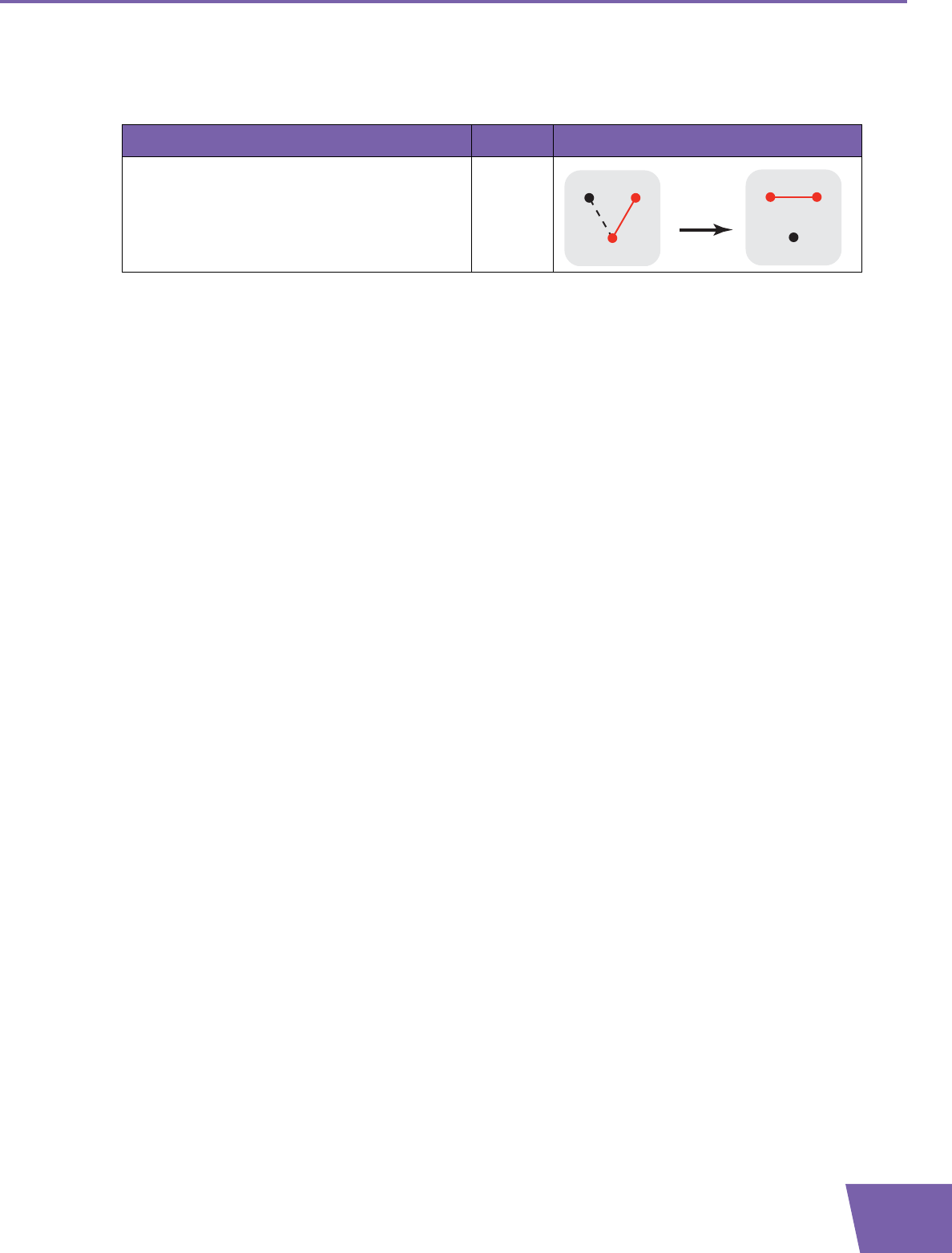
E-DOC-CTC-20080527-0012 v1.0 47
4 Telephony
Call Transfer
If the Call Transfer service is activated, you can use the following functions:
To... Press... Illustration
Transfer a call R, 4
BA
You
active
BA
You
on hold active
You press
R, 4
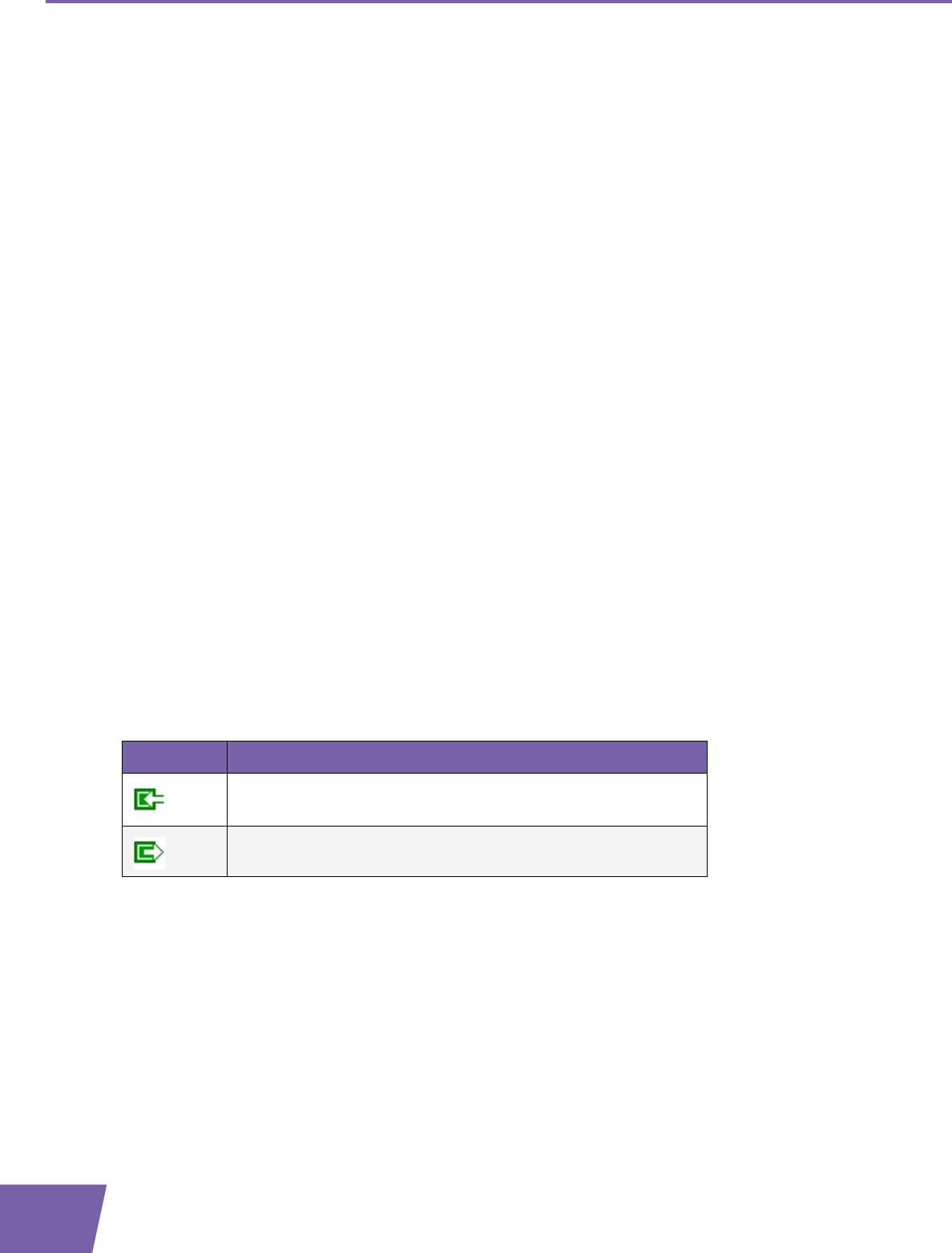
E-DOC-CTC-20080527-0012 v1.0
48
4 Telephony
4.4 Viewing Telephony Statistics
Introduction
The Telephony Statistics page on the Thomson Gateway GUI lists:
Successful incoming calls.
Missed incoming calls.
Successful outgoing calls.
Failed outgoing calls.
Viewing the telephony statistics
Proceed as follows:
1Browse to the Thomson Gateway GUI.
2On the Toolbox menu, click Telephony.
3The Telephony page appears.
On this page you can see an overview of your last calls.
4To view more detailed statistics, click View telephony statistics and logs in the Pick a task list.
5The Telephony Statistics page appears and displays the number of:
Successful incoming calls.
Missed incoming calls.
Successful outgoing calls.
Failed outgoing calls.
for each phone separately and combined.
Used icons
To displays the call logs, the following icons are used:
Icon Description
Incoming call
Outgoing call
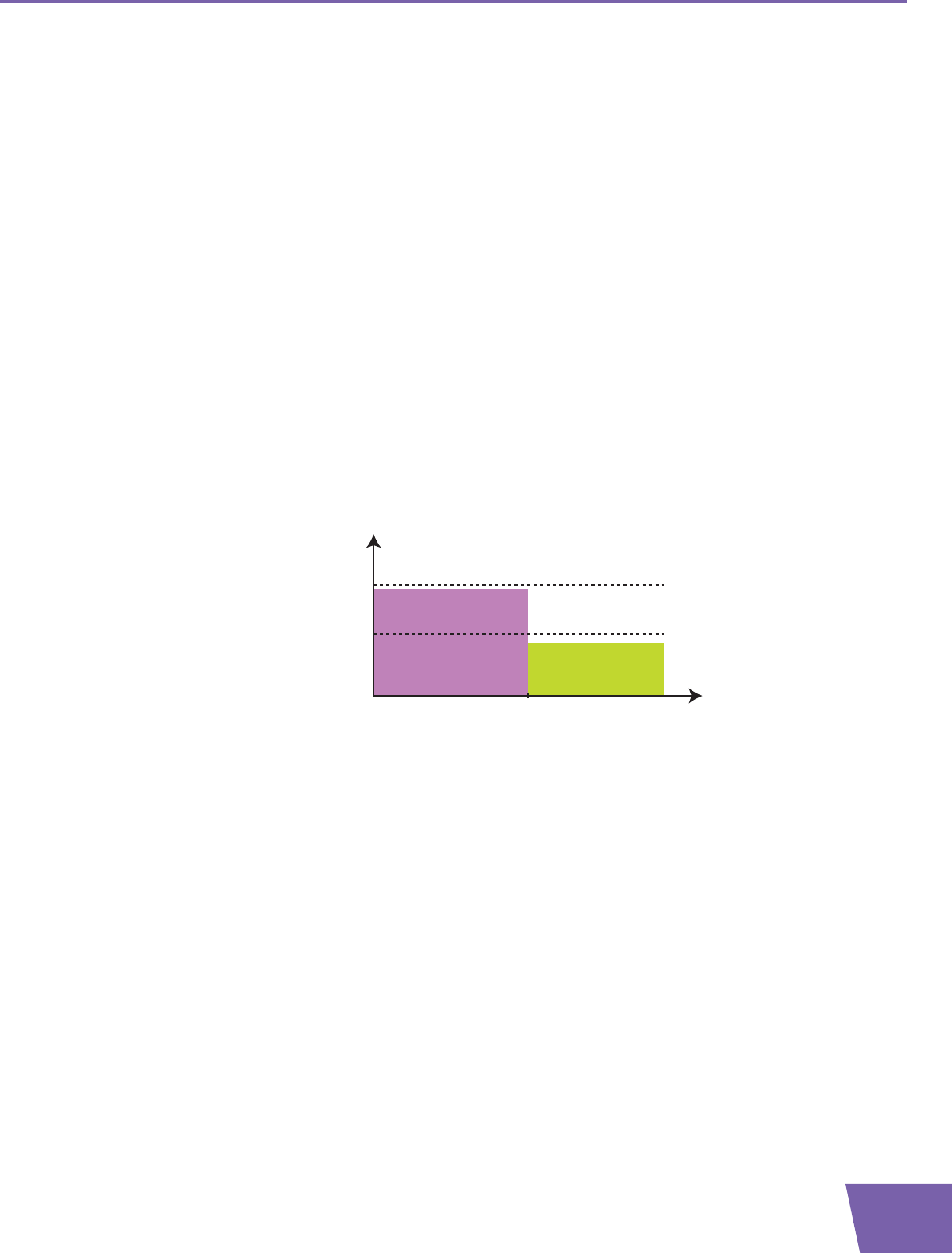
E-DOC-CTC-20080527-0012 v1.0 49
5 Saving Energy with Your Thomson Gateway
5 Saving Energy with Your Thomson Gateway
Code of Conduct v3
To prove its commitment to protect the environment, THOMSON has signed the Code of Conduct v3
(CoC v3), an agreement to reduce the power consumption of broadband devices.
It provides rules for the power consumption in:
Full power state:
This is the normal operation mode of the device, where all functionality is enabled.
Low power state:
When there is no user traffic on the device, the device should switch to low power mode. This is a state in
which devices are only allowed to use a limited amount of energy to be able to power its components
and respond to user activity.
Example:
Take the following example:
The user switches off his computer at 20:00.
There are no other devices connected to the Thomson Gateway.
The Thomson Gateway switches to low power mode. This results in a considerable drop in the overall power
consumption of the Thomson Gateway.
THOMSON power saving innovations
On top of the CoC v3 measures, THOMSON has developed the Automatic Power Management to further
reduce the power consumption.
Automatic Power Management
The Thomson Gateway constantly monitors the user activity and uses this information to optimise the power
consumption:
For example:
When there is no or low user activity, the Thomson Gateway reduces the clock frequency of the central
processor. The lowered clock frequency will result in a lower power consumption.
Switch the wireless interface to a reduced power mode in which the access point is available for
connection, but other functions are turned off. This is only possible if there are no devices connected to
the Thomson Gateway.
No user traffic
User traffic
Time
Power
Consumption
Full power limit
Low power limit
20:00
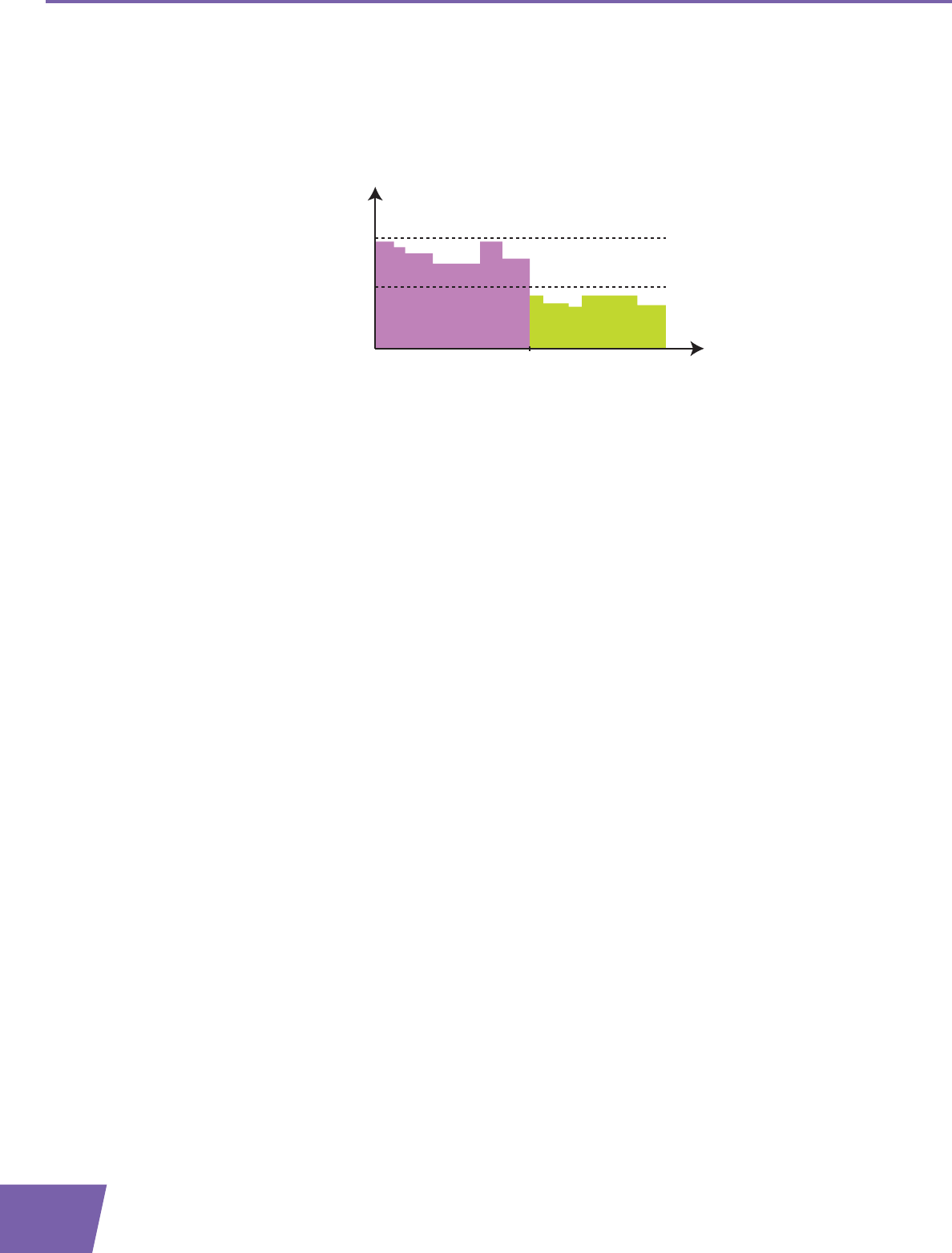
E-DOC-CTC-20080527-0012 v1.0
50
5 Saving Energy with Your Thomson Gateway
Example:
If we use the same example as in the previous section, you can see that the Thomson Gateway is now able to
further reduce the power consumption in periods where there is less action required from the Thomson
Gateway (for example: no wireless devices connected, low user traffic,...).
Zero Power Consumption
If you will not be using your Thomson Gateway for a longer time (for example: you are going on holiday), you
might consider to turn off the Thomson Gateway. This way no energy will be consumed at all.
Be aware that if you turn off the Thomson Gateway, all services provided by it will not be available. For
example:
No VoIP calls
You will no longer be able to make phone calls over the Internet. Your phone calls will automatically be
done via the traditional phone network (if available).
No Digital TV
If your set-top box is connected to your Thomson Gateway, he will no longer be able to connect to the
Internet.
...
No User Traffic
User Traffic
Time
20:00 Time
Power
Consumption
Full power limit
Low power limit
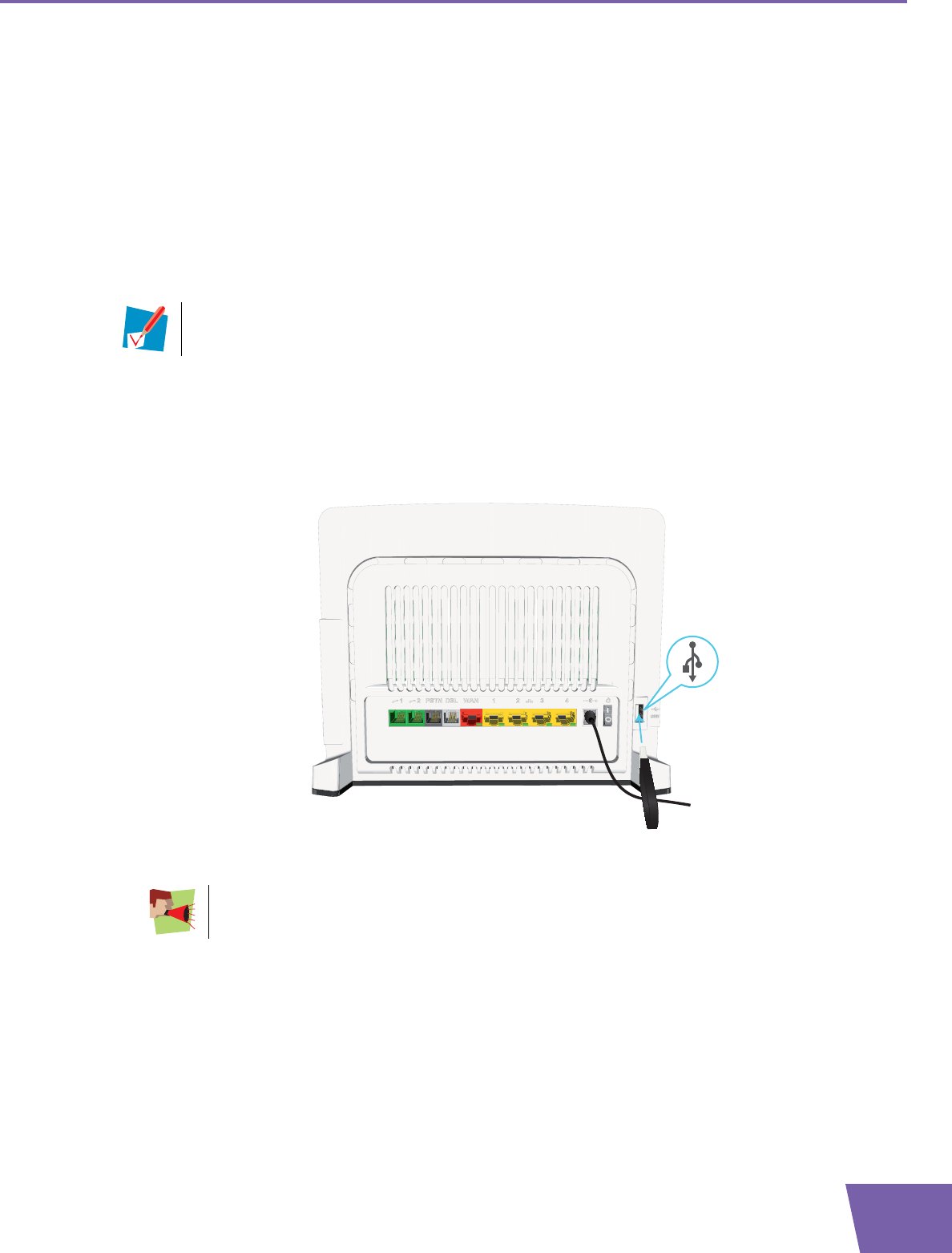
E-DOC-CTC-20080527-0012 v1.0 51
6 Sharing Content on your Thomson Gateway
6 Sharing Content on your Thomson Gateway
Introduction
The Thomson Gateway allows you to store your data on a centralised place in the network. This way you can
share your files with everyone that is connected to your network.
Requirements
Your USB storage device must be formatted as FAT32.
Connecting your USB storage device to the Thomson Gateway
Proceed as follows:
1Plug your USB memory stick or external hard disk in (one of) the USB master port(s) of your Thomson
Gateway.
2If you want to:
Share your files with other devices on the network (for example: a computer) proceed with
“6.1 Using the Network File Server” on page 52.
Share your media with UPnP AV media clients (for example: a media player or media centre),
proceed with “6.2 Using the UPnP AV Media Server” on page 55.
Make your files available for FTP access, proceed with “6.3 Using the FTP Server” on page 56.
To format your device for FAT32, consult the help of your operating system. Make sure to make a
copy of your data before you doing this. Formatting your device will erase all data.
Do not remove your USB storage device without unmounting it first, otherwise data might be
lost! For more information, see “6.5 Safely Removing your USB Storage Device” on page 60.

E-DOC-CTC-20080527-0012 v1.0
52
6 Sharing Content on your Thomson Gateway
6.1 Using the Network File Server
Introduction
The Network Server allows you to share the content on your USB storage device with other devices that are
connected to your Thomson Gateway network (mostly computers).
These devices have read and write access to this USB device.
Procedure
To enable the Network File Server:
1Browse to the Thomson Gateway GUI.
2On the Tools menu, click Content Sharing.
3In the Navigation bar, click Configure.
4Under Network File Server (Windows Networking), click Server Enabled. It is also recommended to
complete in following fields:
Server Name:
You will use this name to access the Thomson Gateway. If you leave this field empty you can only
access your USB storage device by entering the IP address (by default: 192.168.1.253)
Server Description:
Here you can add a short description for what kind of data is stored on the USB storage device.
Workgroup:
Enter the same workgroup as your computer(s).
5Click Apply.
6All users connected to the Thomson Gateway can now connect to your USB storage device.
7If you want to limit the number of folders users can access, continue with “6.4 Managing your Shared
Content” on page 58.
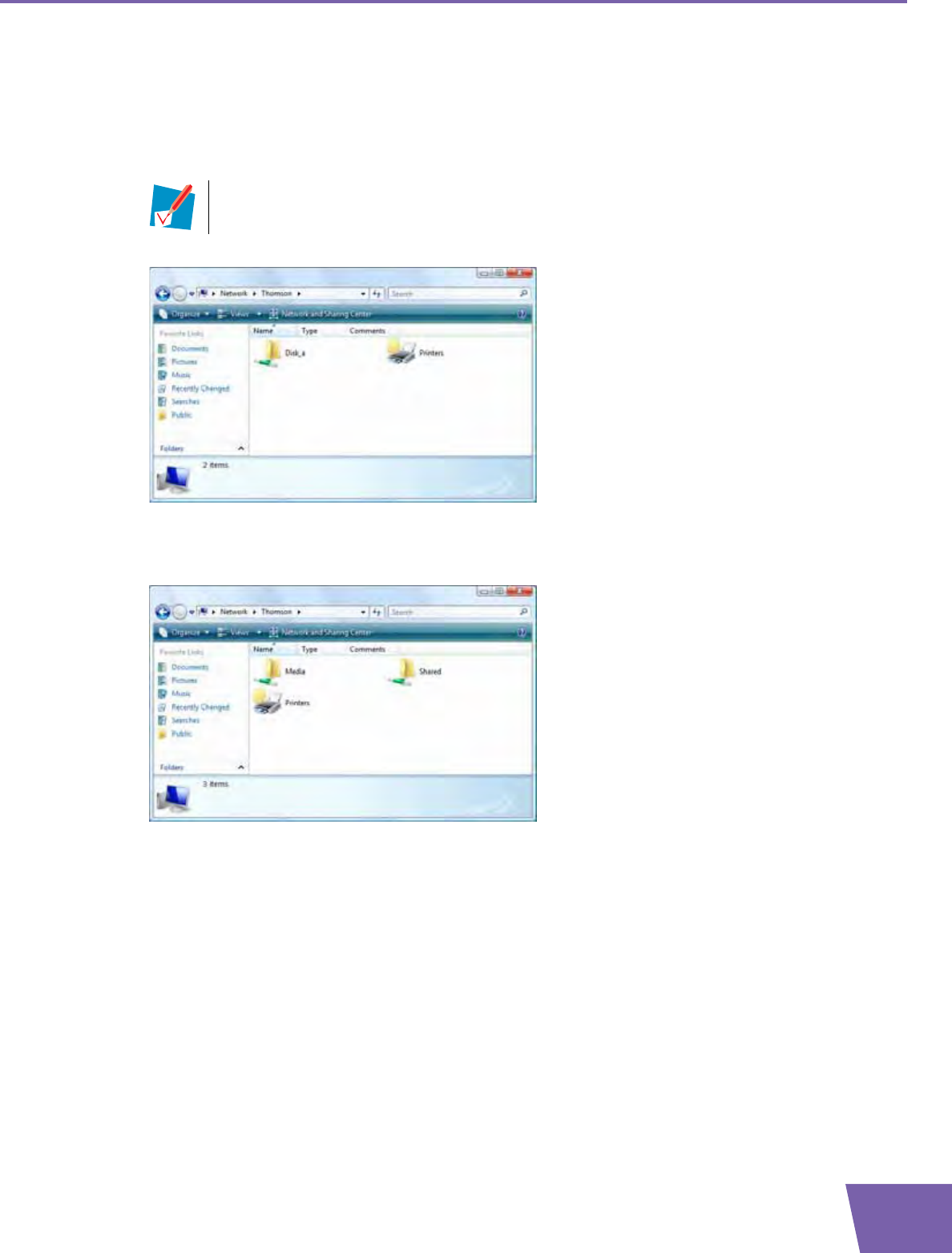
E-DOC-CTC-20080527-0012 v1.0 53
6 Sharing Content on your Thomson Gateway
Accessing the shared content on Windows
Proceed as follows:
1Open Windows Explorer.
2In the address bar type two backslashes followed by the name that you entered in the Server Name box
(in our example: \\Thomson).
3All storage devices that are attached to your Thomson Gateway are listed as folders.
If the storage device has multiple partitions an index number will be added at the end (for example:
Disk_a1 and Disk_a2).
If the partition is a managed partition, the Media and Shared folders will be displayed instead:
For more information on managed partitions, see “6.4 Managing your Shared Content” on page 58.
4If you plan to frequently use this folder, it might be useful to map this folder as a network drive. For more
information, see your operating system’s help.
If you did not provide a server name, type \\192.168.1.253.
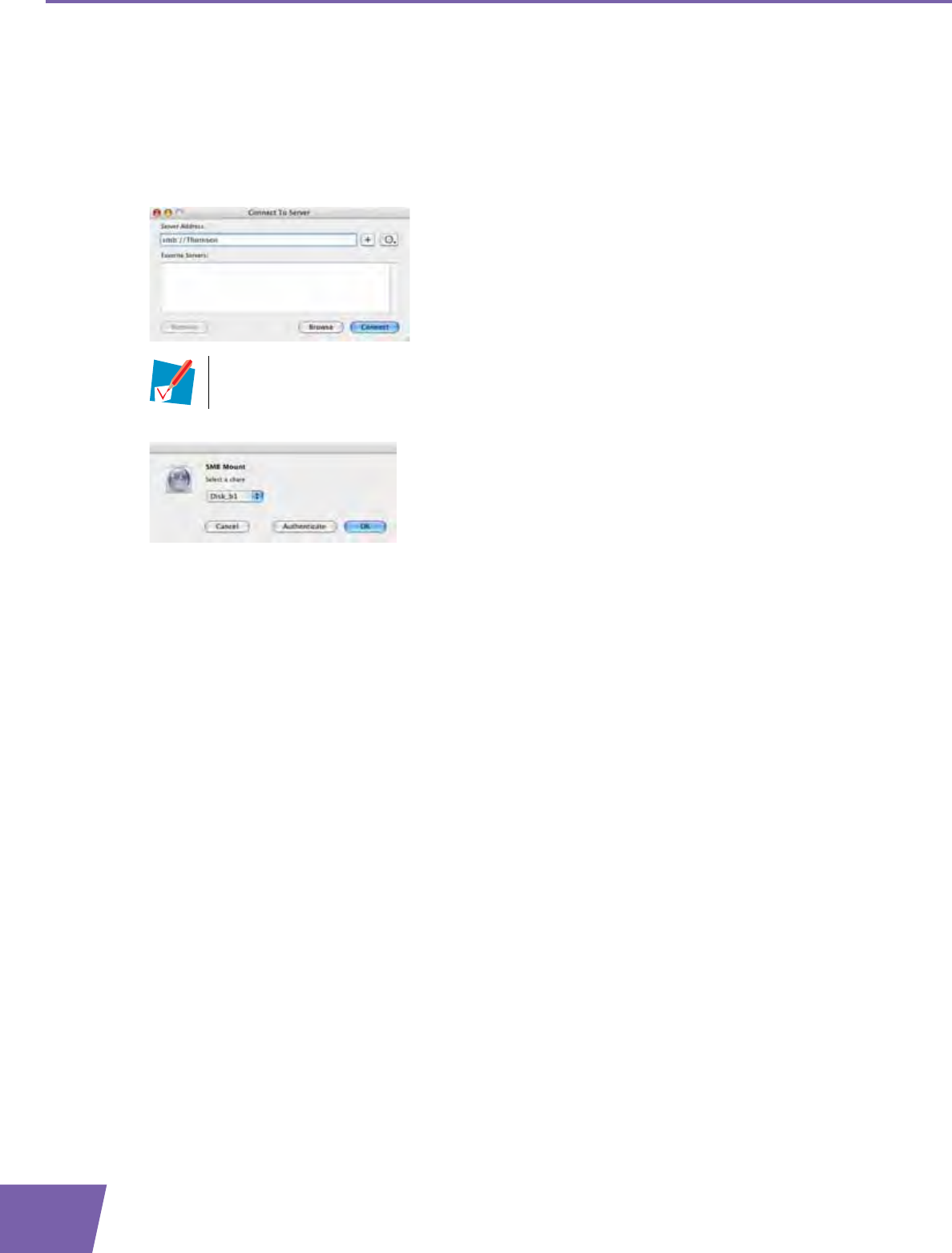
E-DOC-CTC-20080527-0012 v1.0
54
6 Sharing Content on your Thomson Gateway
Accessing the shared content on Mac
Proceed as follows:
1On the Go menu, click Connect To Server.
2The Connect To Server window appears.
3In the Server Address box, type smb://<server name>, where <server name> is the Server Name you
assigned to your USB storage device. So in our example we will type smb://Thomson.
4The SMB Mount window appears.
Select the shared folder you want to mount and click OK.
5The SMB/CIFS Filesystem Authentication window appears. You do not need to authenticate, click OK.
6Your USB storage device is now mounted and is displayed on your desktop.
If you did not provide a server name, type smb://192.168.1.253.
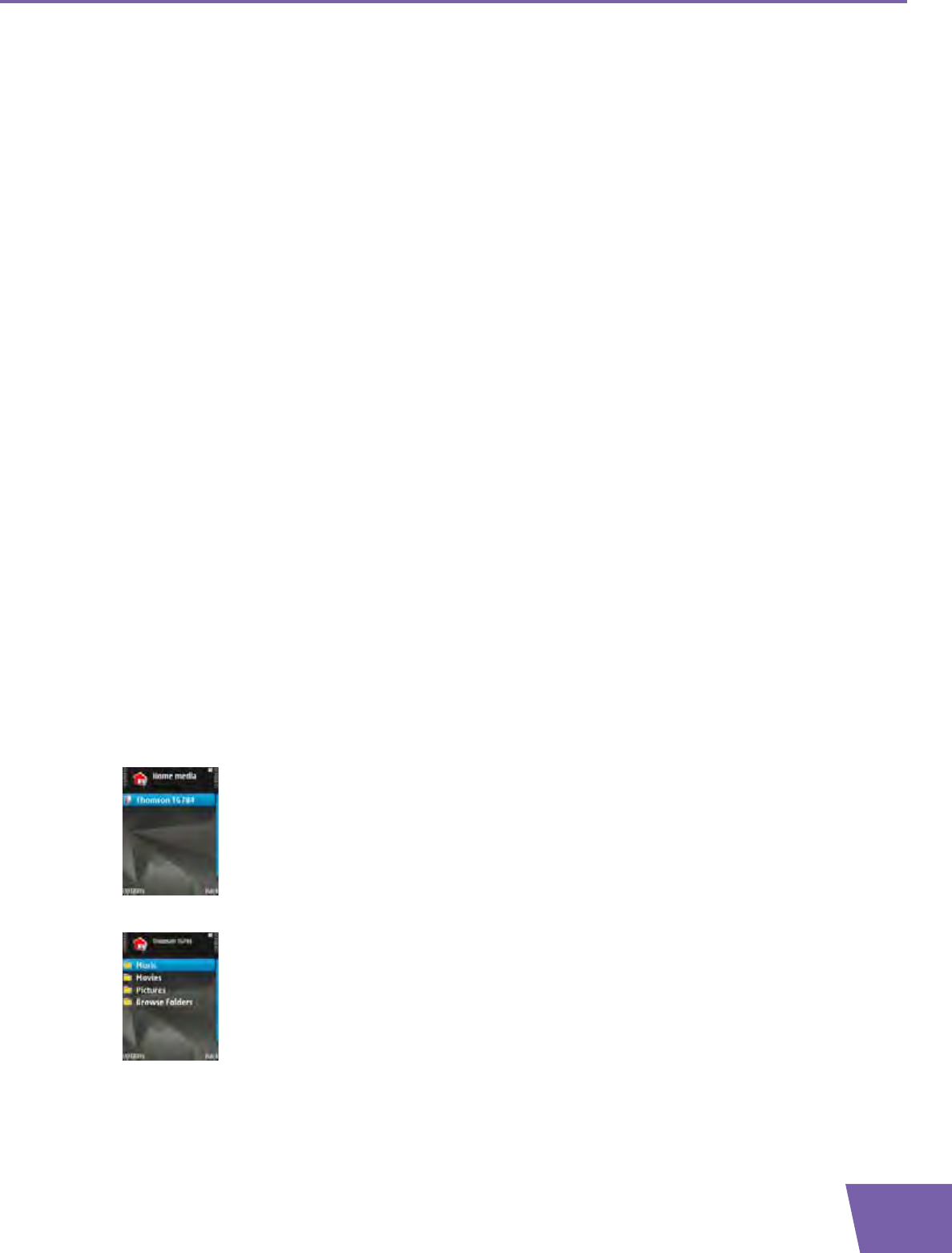
E-DOC-CTC-20080527-0012 v1.0 55
6 Sharing Content on your Thomson Gateway
6.2 Using the UPnP AV Media Server
UPnP AV protocol
UPnP AV (AV stands for Audio and Video) is a protocol especially designed to share media files on your local
network.
UPnP AV network components
A UPnP AV network consists of the following components:
The UPnP Server is directly connected to your media files and makes them available on the network. In
your network the Thomson Gateway will fulfil this role.
The UPnP client is a software application or hardware device that allows you to play or view the media
files provided by your UPnP AV media server.
Setting up the UPnP AV server
Proceed as follows:
1Browse to the Thomson Gateway GUI.
2On the Tools menu, click Content Sharing.
3In the Navigation bar, click Configure.
4Under UPnP AV Media Server, click Server Enabled.
5Click Apply.
Result
The Thomson Gateway lists all audio, video and picture files located on the connected USB storage device.
All UPnP AV clients that are connected to your network are now able to view this list and play or view items
from this list.
On your UPnP AV client, the Thomson Gateway’s UPnP AV media server will be listed as THOMSON TGXXX
or Thomson MediaGateway. Below you can find a screenshot taken on a smartphone with a UPnP AV client.
Via this entry, you can browse to your media files.

E-DOC-CTC-20080527-0012 v1.0
56
6 Sharing Content on your Thomson Gateway
6.3 Using the FTP Server
Introduction
The Thomson Gateway allows you to access your shared content by FTP. This can be useful if you want to be
able to access your shared content from the Internet.
Via FTP you can download or upload all types of files both from your local network and the Internet.
Setting up the FTP server
Proceed as follows:
1Protect your account with a password.
2Enable the FTP Server and select the managed partition.
Protect your account with a password
If you did not yet configure your login to the Thomson Gateway GUI with a password:
1Browse to the Thomson Gateway GUI.
2On the Toolbox menu, click User Management.
3In the Pick a task list, click Change my password.
4Leave the Old Password box empty.
5Type your new password both in the New Password box and Confirm New Password box.
Enable the FTP Server and select the managed partition
Proceed as follows:
1Browse to the Thomson Gateway GUI.
2On the Tools menu, click Content Sharing.
3In the Navigation bar, click Configure.
4Under FTP Server, click Server Enabled.
5Under List of connected disks, click the radio button next to the partition that you want to access using
FTP.
6The Thomson Gateway now creates a Media and Shared folder on the selected partition. The Shared
folder will be used as root location for FTP sessions.
7Click Apply.
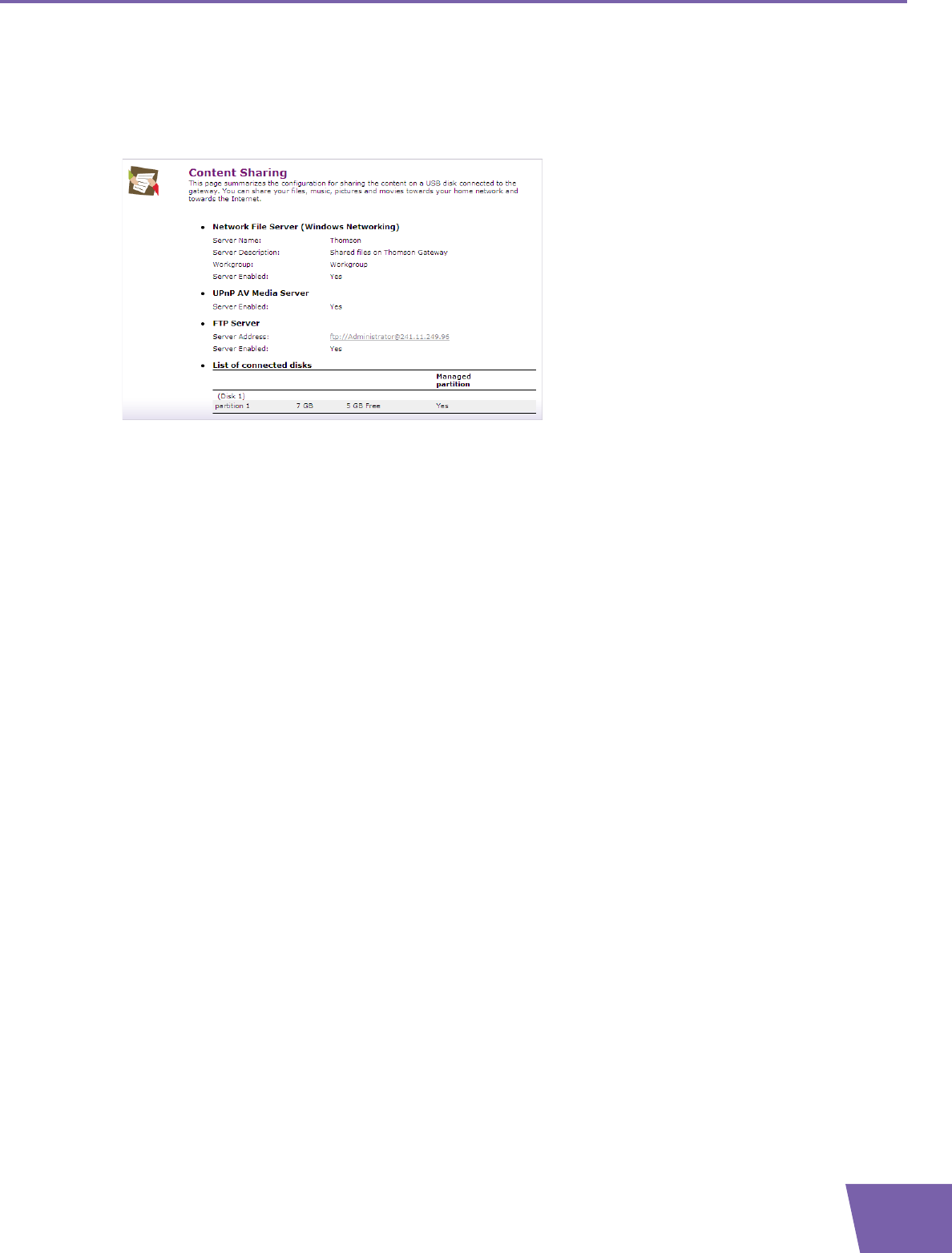
E-DOC-CTC-20080527-0012 v1.0 57
6 Sharing Content on your Thomson Gateway
Result
The Shared folder and its subfolders are now accessible using FTP. The other folders are not accessible via
FTP.
If you are connected to the Internet, the link to the FTP server is displayed under FTP Server:
On the Thomson Gateway network, you can also access the FTP server using its local address (192.168.1.253).
Additional configuration
Because most service providers use dynamic IP addresses, the IP address of your Internet connection may
change frequently. This implies that the link to the FTP server will also change every time the public IP
changes. With Dynamic DNS, you can assign a host name to the IP address (for example
mygateway.dyndns.org). For more information, see “7.3 Dynamic DNS” on page 70.
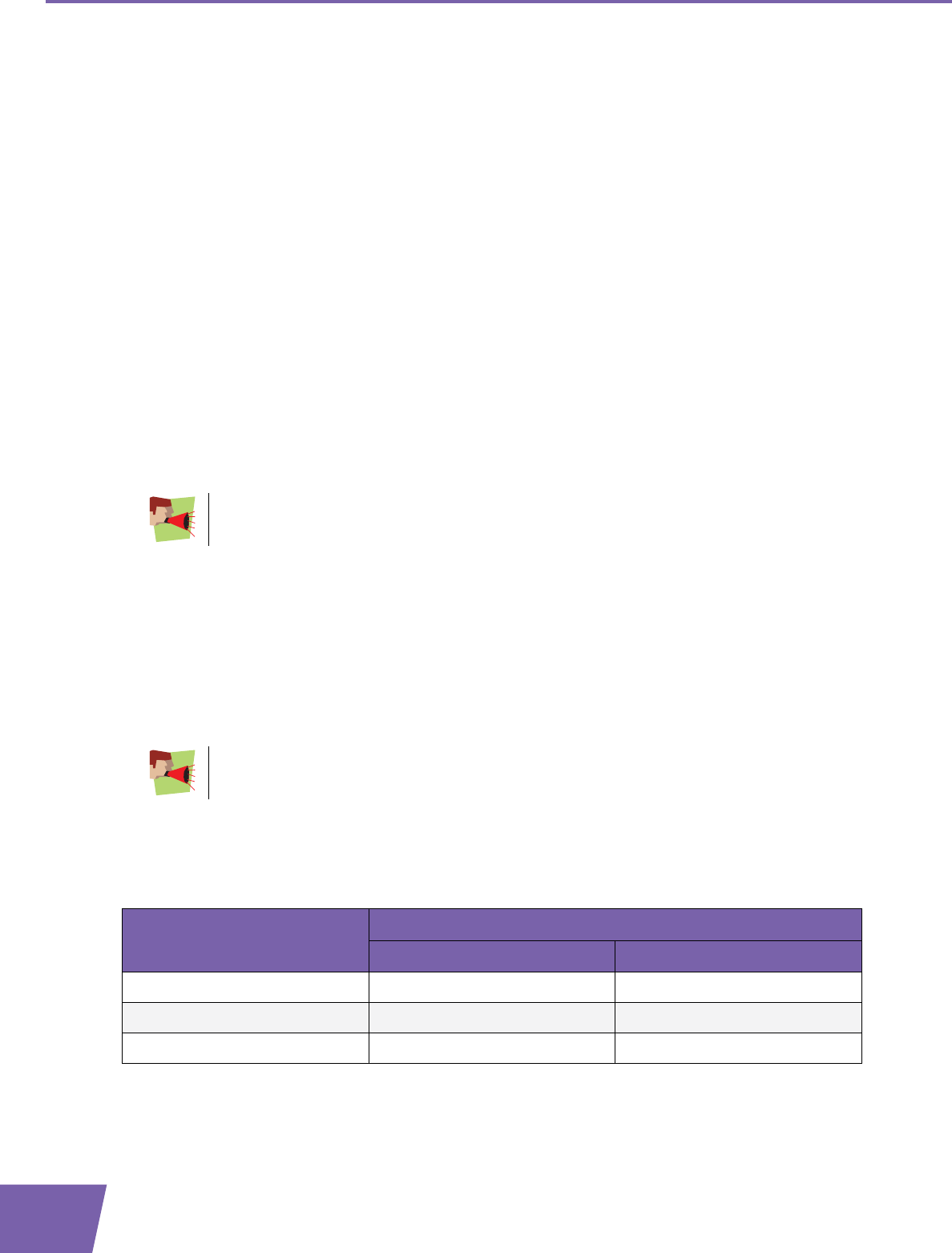
E-DOC-CTC-20080527-0012 v1.0
58
6 Sharing Content on your Thomson Gateway
6.4 Managing your Shared Content
Managed Partition
If you select your drive or partition as managed partition, users only have access to the following folders:
Media
Shared
All other folders will be hidden from the user. These hidden folders are still on the USB storage device, but
you can not access them. If you connected more than one USB storage device, those devices will also be
hidden.
Media folder
Use the Media folder to share your audio, video and picture files. This folder can only be accessed via the
following servers:
The Network File Server
For more information, see “6.1 Using the Network File Server”.
UPnP AV Media Server.
For more information, see “6.2 Using the UPnP AV Media Server”.
Shared folder
The Shared folder is a folder to share files both on the local network and the Internet. This folder can only be
accessed via the following server:
The Network File Server
For more information, see “6.1 Using the Network File Server”.
FTP Server
For more information, see “6.3 Using the FTP Server”.
Ummanaged vs managed
The following table compares the two modes:
If your partition is managed, the UPnP AV server will only use the media files that are located in
the Media folder.
The FTP Server can only be used with a managed partition.
Access via Accessible folders
Unmanaged Managed
Network File Server All Media and Shared folder.
UPnP AV Media Server All Media folder.
FTP Server Not available in this mode. Shared folder.

E-DOC-CTC-20080527-0012 v1.0 59
6 Sharing Content on your Thomson Gateway
Setting up the managed partition
Proceed as follows:
1Browse to the Thomson Gateway GUI.
2On the Tools menu, click Content Sharing.
3In the Navigation bar, click Configure.
4Under List of connected disks, click the radio button next to the partition you want to configure as
Managed Partition.
5Click Apply.
Result
The Thomson Gateway creates following folders:
Media:
Use this folder to share your media files with others users on your network. You can store your media
files in following subfolders:
Movies
Music
Pictures
Shared:
Use this folder to share your other data with other users on your network. Optionally, users can also
access this folder using FTP. For more information, see “6.3 Using the FTP Server” on page 56.
If the above folders already exist, the existing folders are used.

E-DOC-CTC-20080527-0012 v1.0
60
6 Sharing Content on your Thomson Gateway
6.5 Safely Removing your USB Storage Device
Introduction
If you just unplug your USB storage device from the Thomson Gateway you may loose your data. To avoid
this you must first unmount your USB storage device.
Unmounting your USB storage device
Proceed as follows
1Browse to the Thomson Gateway GUI.
2On the Toolbox menu, click Content Sharing.
3In the Navigation bar, click Configure.
4Click Unmount.
5Unplug your USB storage device from the Thomson Gateway.
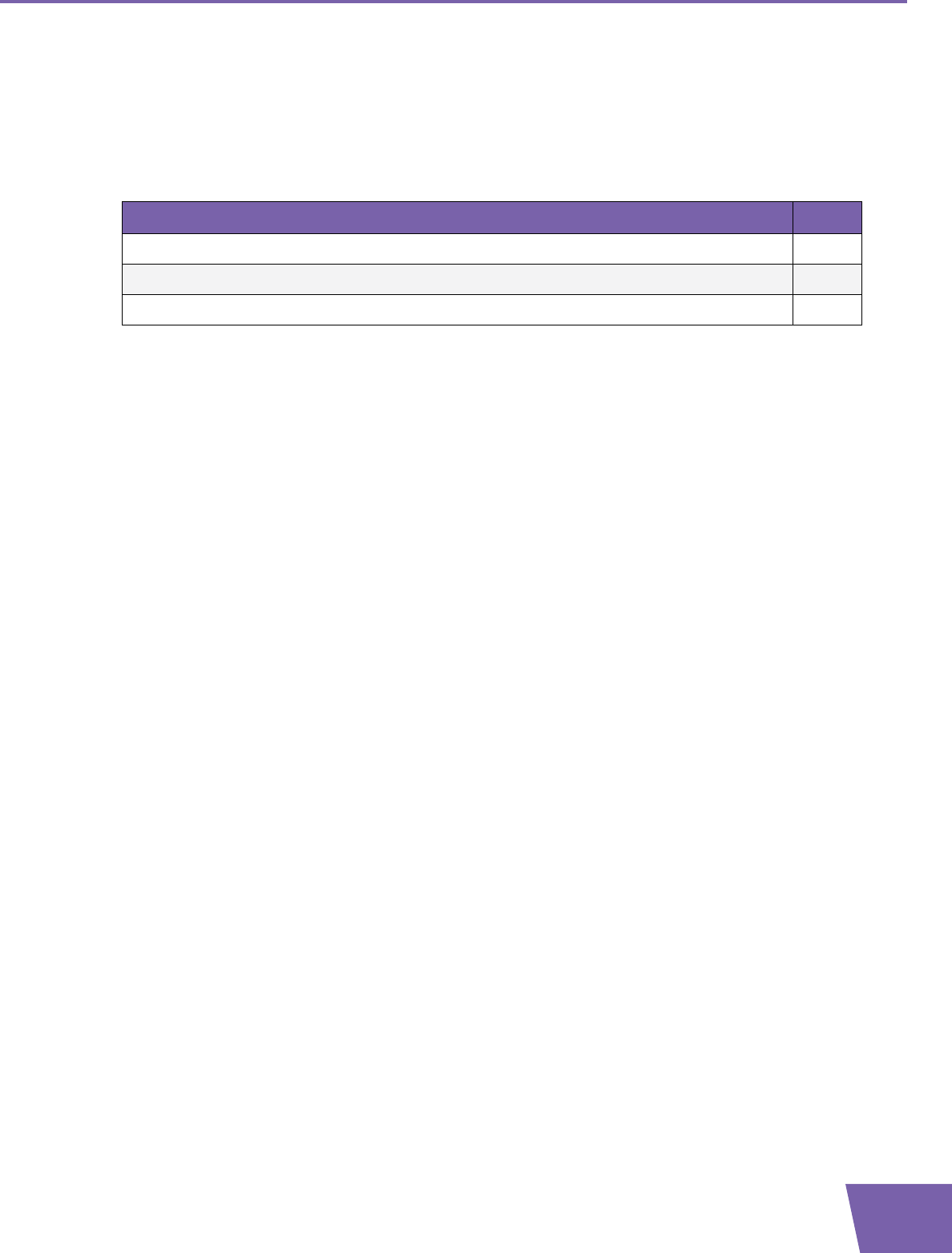
E-DOC-CTC-20080527-0012 v1.0 61
7 Thomson Gateway Tools
7 Thomson Gateway Tools
In this chapter
In this chapter we will take a closer look at following features:
Feature availability
Depending on the configuration offered by your service provider, some features may not be available on your
Thomson Gateway. For more information, contact your service provider.
Topic Page
UPnP 62
Assigning a service (HTTP, FTP,...) to a Computer 68
Dynamic DNS 70
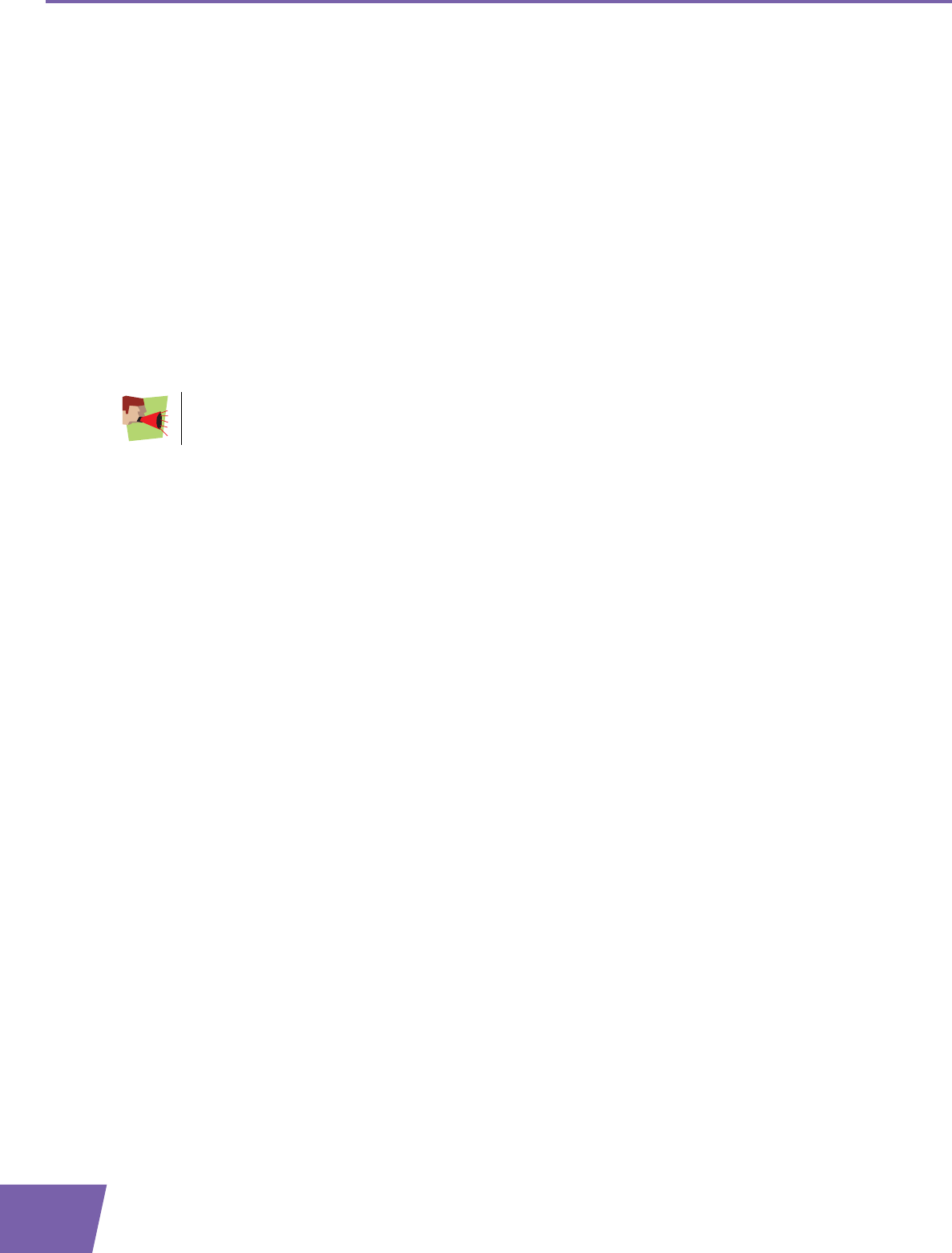
E-DOC-CTC-20080527-0012 v1.0
62
7 Thomson Gateway Tools
7.1 UPnP
Introduction
UPnP is designed to automate the installation and configuration of a (small) network as much as possible.
This means that UPnP-capable devices can join and leave a network without any effort of a network
administrator.
Supported Operating Systems
The following operating systems support UPnP:
Windows 7
Windows Vista
Windows XP
UPnP and the Thomson Gateway
With UPnP:
You can access the Thomson Gateway GUI without having to remember the address of the Thomson
Gateway. For more information, see “7.1.1 Accessing Your Thomson Gateway with UPnP” on page 63.
You can connect/disconnect without having to open the Thomson Gateway GUI.
For more information, see “7.1.2 Managing your Internet connection with UPnP” on page 64.
You do not have to manually create port mappings to run services on a computer. The automatic port
configuration mechanism for UPnP-enabled games and applications will do this for you. If the application
is UPnP-enabled, UPnP will create these entries automatically. For more information, see “7.2 Assigning
a service (HTTP, FTP,...) to a Computer” on page 68.
If your computer is running Windows XP, you first have to install the UPnP component. For more
information, see “7.1.4 Installing UPnP on Windows XP” on page 66.
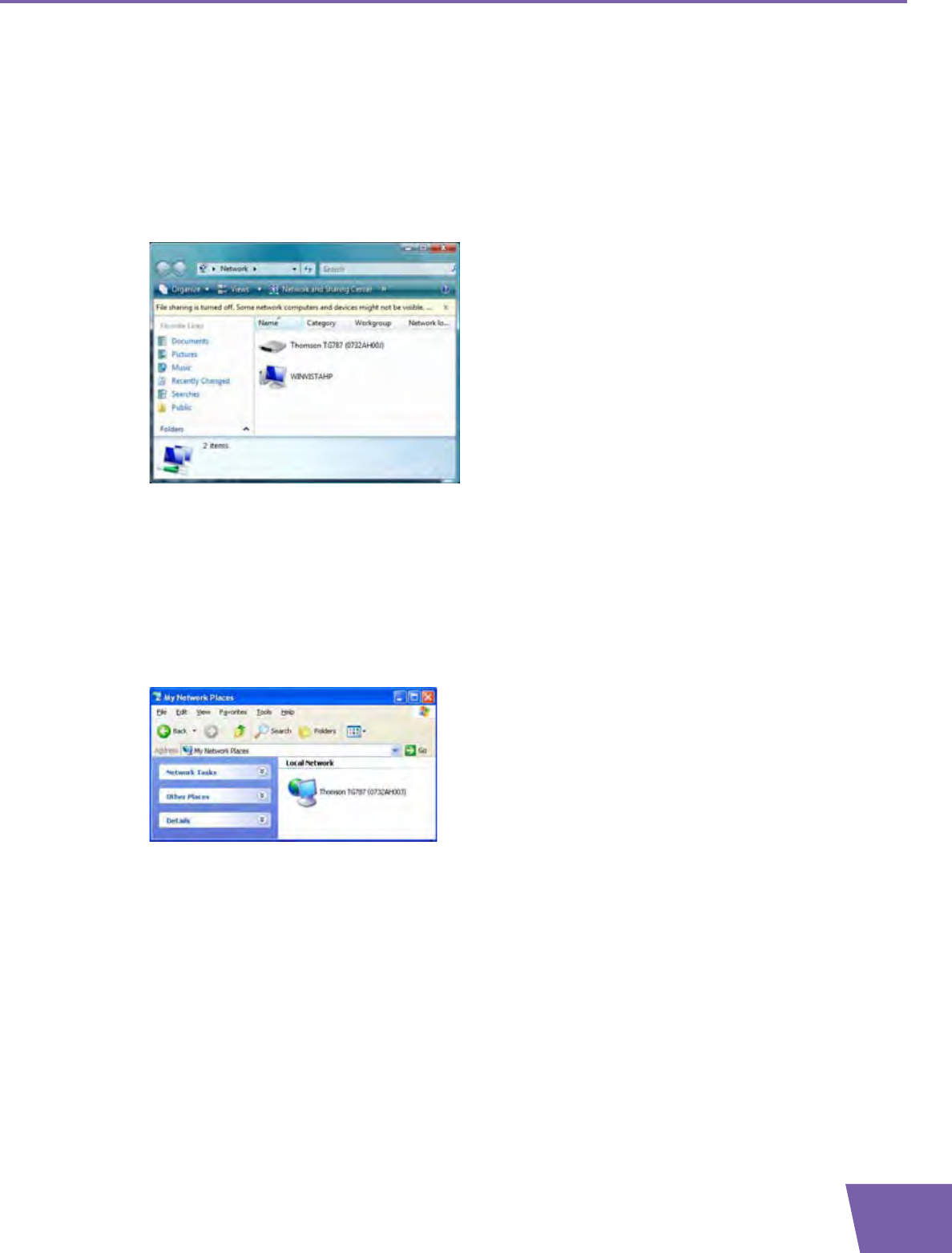
E-DOC-CTC-20080527-0012 v1.0 63
7 Thomson Gateway Tools
7.1.1 Accessing Your Thomson Gateway with UPnP
Windows 7/Vista
If you computer runs Windows 7/Vista:
1On the Windows Start menu, click Network.
2The Network window appears:
3Right-click your Thomson Gateway (displayed as THOMSON TGXXX) and click View device web page.
4The Thomson Gateway GUI appears.
Windows XP
If you computer runs Windows XP:
1Go to My Network Places.
2The My Network Places window appears:
3Double-click your Thomson Gateway (displayed as THOMSON TGXXX).
4The Thomson Gateway GUI appears.
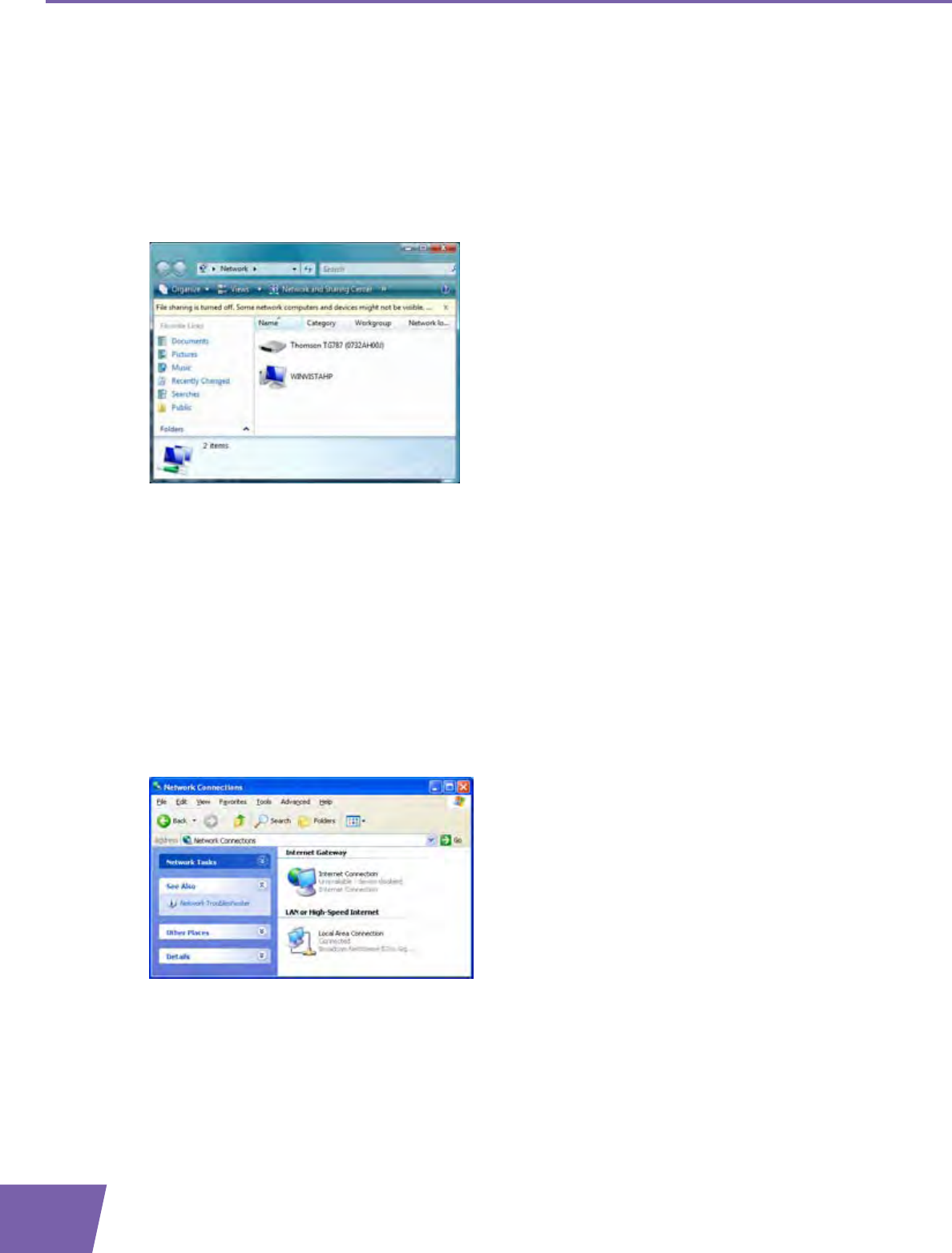
E-DOC-CTC-20080527-0012 v1.0
64
7 Thomson Gateway Tools
7.1.2 Managing your Internet connection with UPnP
Windows 7/Vista
If you computer runs Windows 7/Vista:
1On the Windows Start menu, click Network.
2The Network window appears:
3Right-click your Thomson Gateway (displayed as THOMSON TGXXX).
4If you are currently:
Connected to the Internet, click Disable to disconnect from the Internet.
Not connected to the Internet, click Enable to connect to the Internet.
Windows XP
Proceed as follows:
1On the Windows Start menu, click (Settings >) Control Panel.
2The Control Panel window appears.
Click (Network and Internet Connections) > Internet Connections.
3The Network Connections window appears;
4If you right-click the Internet Connection icon, you can connect/disconnect your connection to the
Internet.
Disabling this feature
To prevent that users can connect/disconnect you can enable Extended Security. For more information, see
“7.1.3 Configuring UPnP on the Thomson Gateway” on page 65.

E-DOC-CTC-20080527-0012 v1.0 65
7 Thomson Gateway Tools
7.1.3 Configuring UPnP on the Thomson Gateway
Introduction
On the Thomson Gateway GUI you can:
Enable/Disable UPnP.
Enable/Disable Extended Security.
Enable/Disable UPnP
Proceed as follows:
1Browse to the Thomson Gateway GUI.
2On the Toolbox menu, click Game & Application Sharing.
3Under Universal Plug and Play:
Select the Use UPnP check box, to enable UPnP.
Clear the Use UPnP check box, to disable UPnP.
4Click Apply.
Extended Security
If Extended Security is enabled only limited UPnP operation between the host and the Thomson Gateway is
allowed:
A local host is not allowed to connect/disconnect the Thomson Gateway Internet connection. You can
then only connect/disconnect the Internet connection via the Thomson Gateway GUI
Address translation mappings can only be added or changed via UPnP for the host on which the UPnP
application is running.
Enable/Disable Extended Security
Proceed as follows:
1Browse to the Thomson Gateway GUI.
2On the Toolbox menu, click Game & Application Sharing.
3Under Universal Plug and Play, select Use Extended Security.
4Click Apply.
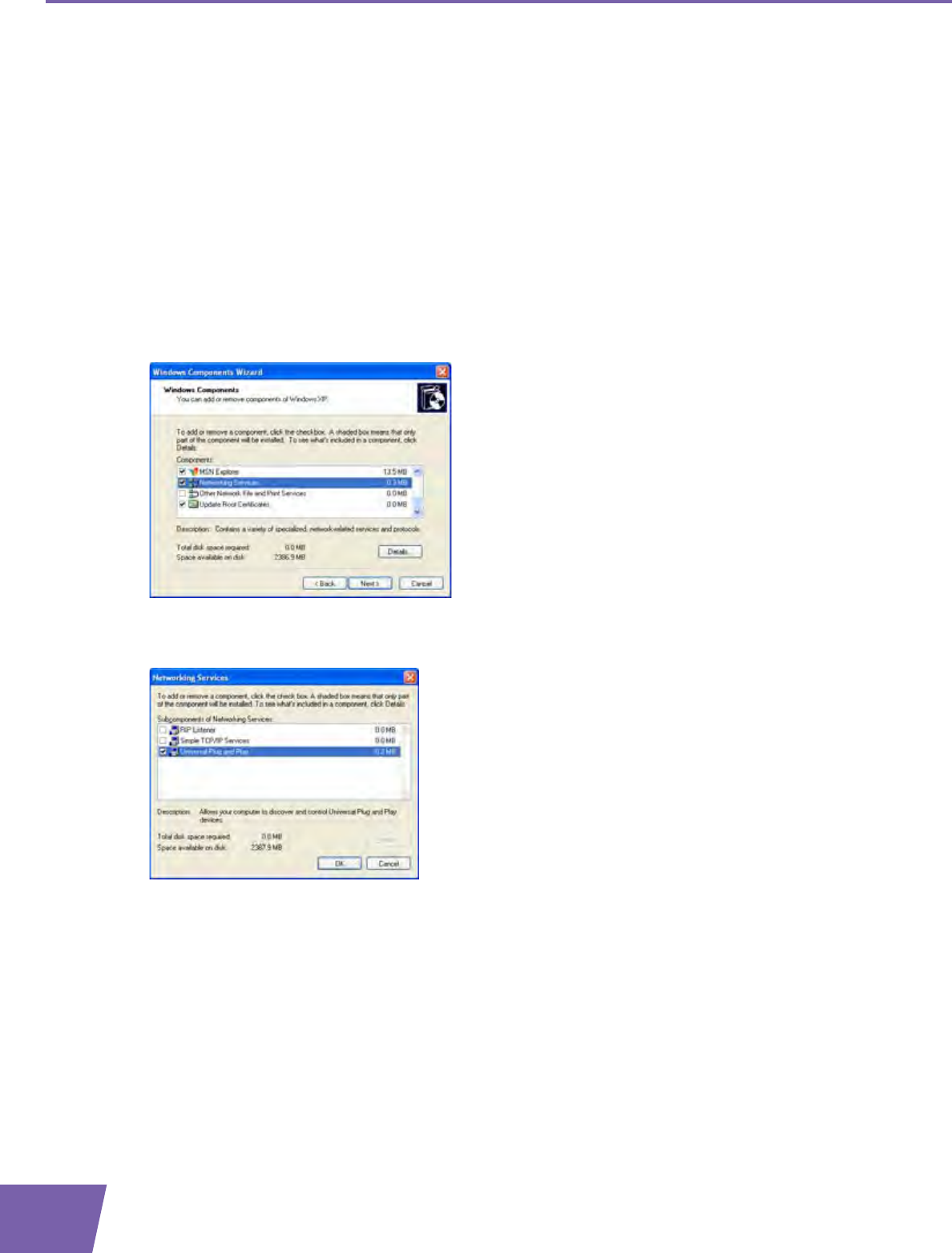
E-DOC-CTC-20080527-0012 v1.0
66
7 Thomson Gateway Tools
7.1.4 Installing UPnP on Windows XP
Adding UPnP
If you are running Microsoft Windows XP, it is recommended to add the UPnP component to your system.
Proceed as follows:
1In the Start menu, click (Settings >) Control Panel.
2The Control Panel window appears.
Click Add or Remove Programs.
3The Add or Remove Programs window appears.
Click Add/Remove Windows Components.
4The Windows Components Wizard appears:
In the Components list, select Networking Services and click Details
5The Networking Services window appears:
Select Universal Plug and Play or UPnP User Interface and click OK.
6Click Next to start the installation and follow the instructions in the Windows Components Wizard.
7At the end of the procedure the wizard informs you that the installation was successful. Click Finish to
quit.
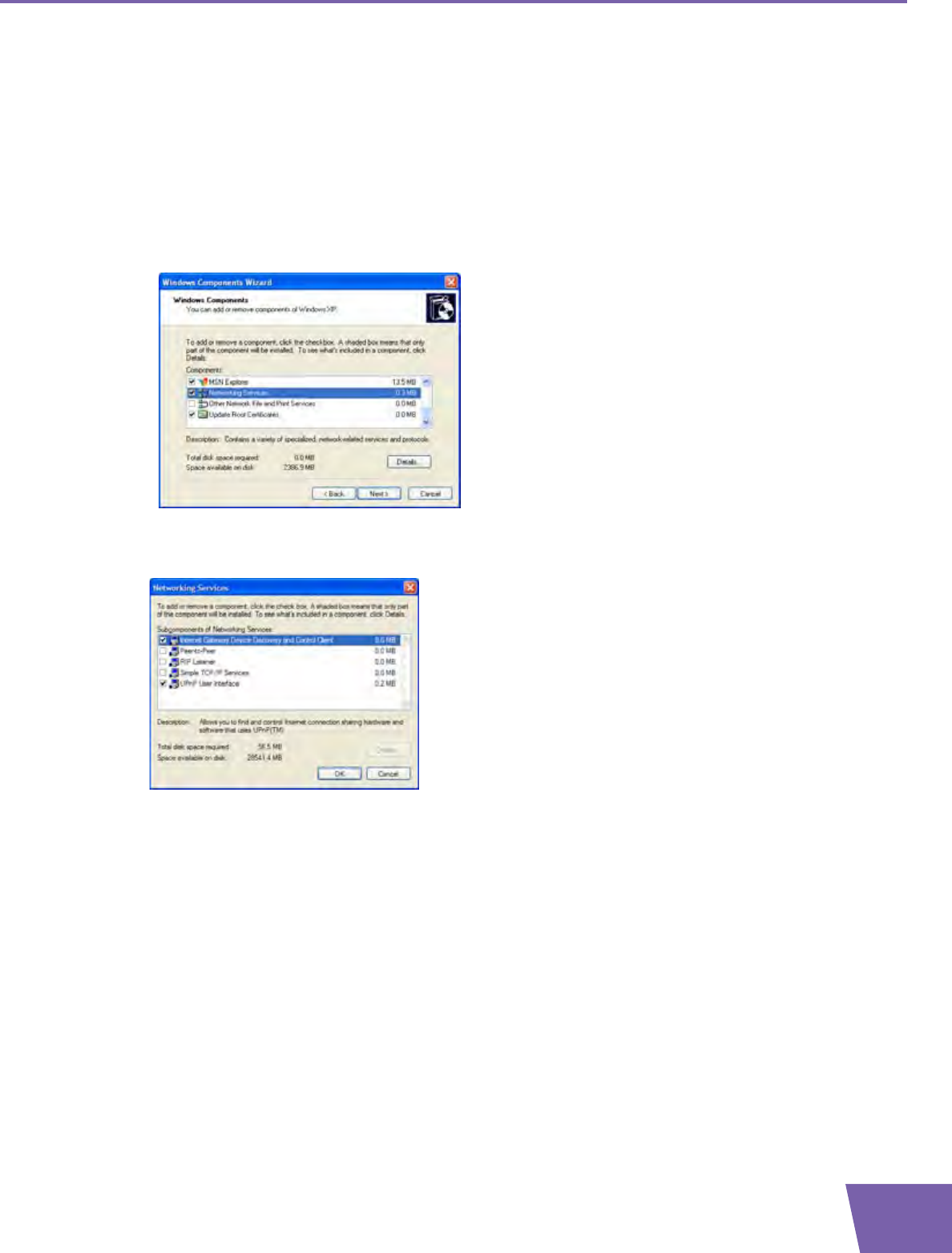
E-DOC-CTC-20080527-0012 v1.0 67
7 Thomson Gateway Tools
Adding IGD Discovery and Control
Your Windows XP system is able to discover and control Internet Gateway Devices (IGD), like the Thomson
Gateway on your local network. Therefore, it is recommended to add the IGD Discovery and Control client to
your system.
Proceed as follows:
1On the Windows taskbar, click Start.
2Select (Settings >) Control Panel > Add or Remove Programs.
3In the Add or Remove Programs window, click Add/Remove Windows Components.
4The Windows Components Wizard appears:
Select Networking Services in the Components list and click Details.
5The Networking Services window appears:
Select Internet Gateway Device Discovery and Control Client and click OK.
6Click Next to start the installation and follow the instructions in the Windows Components Wizard.
7At the end of the procedure, the wizard informs you that the installation was successful. Click Finish to
quit.
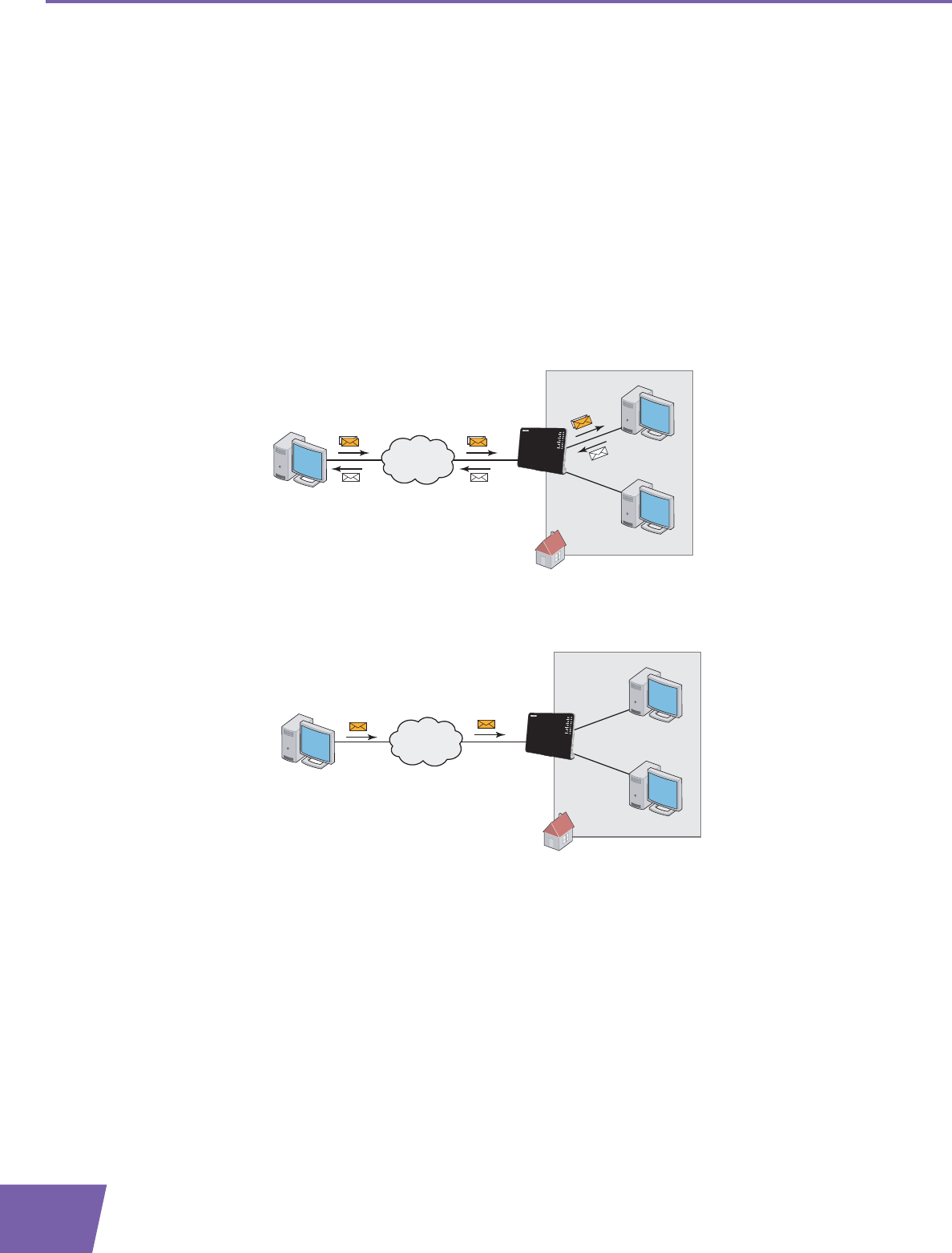
E-DOC-CTC-20080527-0012 v1.0
68
7 Thomson Gateway Tools
7.2 Assigning a service (HTTP, FTP,...) to a Computer
Introduction
The Thomson Gateway allows you to use one internet connection for multiple computers. This means that all
your computers share one public IP address, as if only one computer were connected to the outside world.
Issue
When the Thomson Gateway receives an incoming message, the Thomson Gateway has to decide to which
computer he has to send this message.
If the incoming message is a response to an outgoing message originating from one of your computers, the
Thomson Gateway sends the incoming message to this computer.
If your are running a server or an application that acts as a server (for example a HTTP server, internet game),
the initial message will come from the internet and the Thomson Gateway has to decide to which computer
he should forward the incoming message.
Solution
To avoid this problem you must:
Enable UPnP.
Assign a game or application to a local networking device.
Internet
Internet
?

E-DOC-CTC-20080527-0012 v1.0 69
7 Thomson Gateway Tools
UPnP
UPnP is a technology that enables seamless operation of a wide range of games and messaging applications.
Your computer will use UPnP to communicate to the Thomson Gateway which services are running on the
computer.
For example, when you start a UPnP-enabled application on your computer, it will automatically create the
necessary port mappings to this computer.
For more information on UPnP, see “7.1 UPnP” on page 62.
Assign a game or application to a local networking device
If you assign a game or application to a local networking device, you will basically tell the Thomson Gateway
that if it receives requests for a specific game or application, it has to forward these messages to a specific
computer.
Proceed as follows to do so:
1Browse to the Thomson Gateway GUI.
2On the Toolbox menu, click Game & Application Sharing.
3In the Pick a task list, click Assign a game or application to a local network device.
4In the Game or application list, click the service you want to run on the computer. For example, HTTP
Server (World Wide Web).
5In the Device list, select the computer to which you want to assign the service. Your computer will be
listed with it’s computer name.
6All incoming request for the selected service will now be directed to the selected device. The Thomson
Gateway will also configure the its firewall to allow this service.
If the service is not available in the list, click Create a new game or application in the Pick a task
list. For more information, click Help on the Thomson Gateway GUI.

E-DOC-CTC-20080527-0012 v1.0
70
7 Thomson Gateway Tools
7.3 Dynamic DNS
Introduction
The Dynamic DNS service allows you to assign a dynamic DNS host name (for example
mywebpage.dyndns.org) to a broadband connection even if it is using a dynamic IP address. As soon as the
device gets a new IP address, the dynamic DNS server updates its entry to the new IP address.
What you need
Before you can configure Dynamic DNS, you first have to create an account at a Dynamic DNS service
provider. For example:
www.dyndns.org
www.no-ip.com
www.dtdns.com
Procedure
Proceed as follows:
1Browse to the Thomson Gateway GUI.
2On the Toolbox menu, click Dynamic DNS.
3On the Navigation bar, click Configure.
4Select the Enabled check box.
5If necessary, select the broadband connection to which you want to assign the Dynamic DNS host name
in the Interface list.
6Type the user name and password of your Dynamic DNS service account in the corresponding fields.
7In the Service list, click the name of your Dynamic DNS service provider.
8In the Host box, type the host name that you got from the Dynamic DNS service provider (for example
mywebpage.dyndns.org).
9Click Apply.
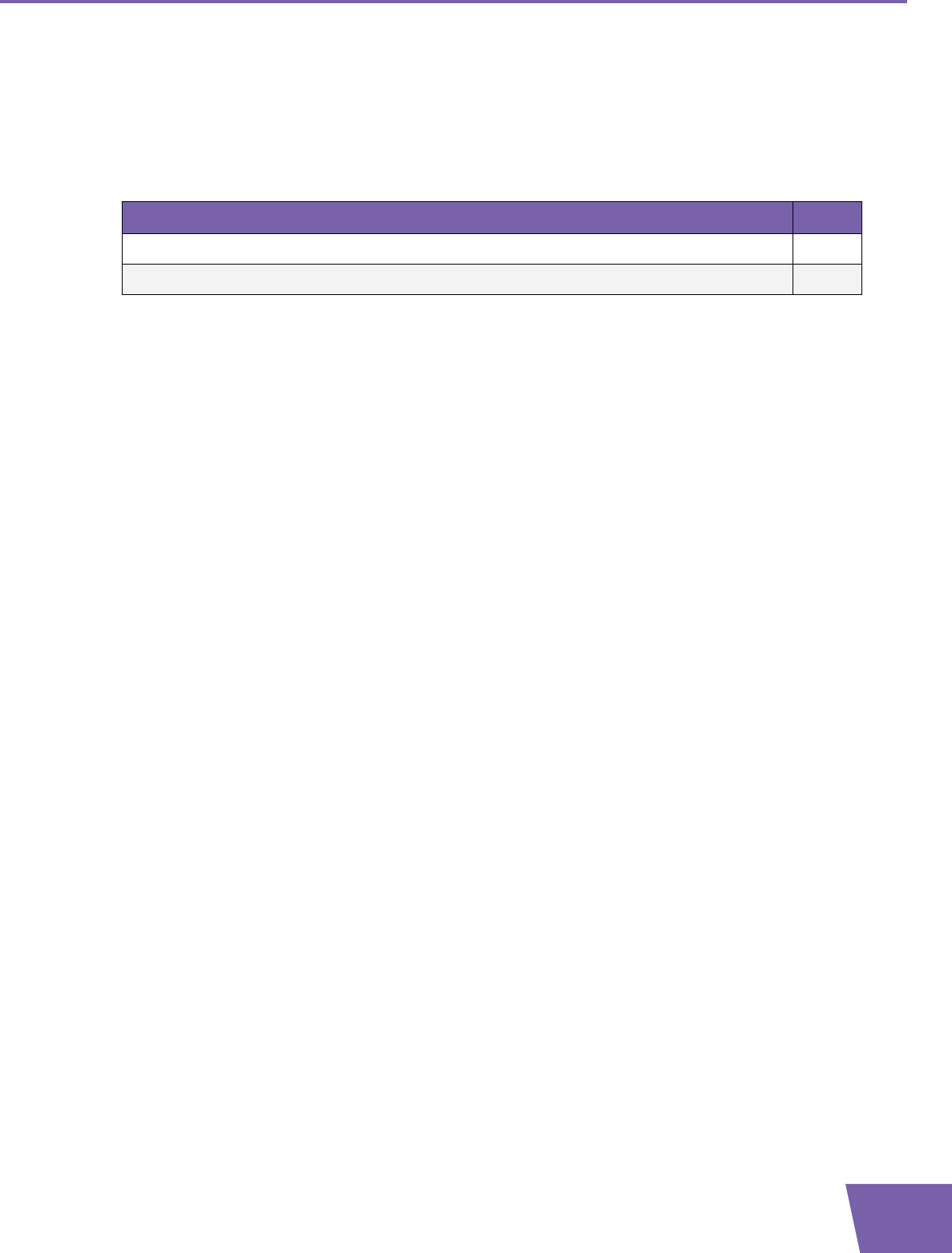
E-DOC-CTC-20080527-0012 v1.0 71
8 Internet Security
8 Internet Security
Overview
The Thomson Gateway offers you various options to secure your network:
Topic Page
Firewall 72
Parental Control 73

E-DOC-CTC-20080527-0012 v1.0
72
8 Internet Security
8.1 Firewall
Introduction
The Thomson Gateway comes with an integrated firewall. This firewall has a number of predefined levels to
allow you to adjusted the firewall to your needs.
The Firewall is disabled by default.
Changing the security level
Proceed as follows:
1Browse to the Thomson Gateway GUI.
2On the Toolbox menu, click Firewall.
3The Firewall page appears. In the upper-right corner, click Configure.
4A list with security settings with a brief description is displayed.
5Select the security level of your choice and click Apply.
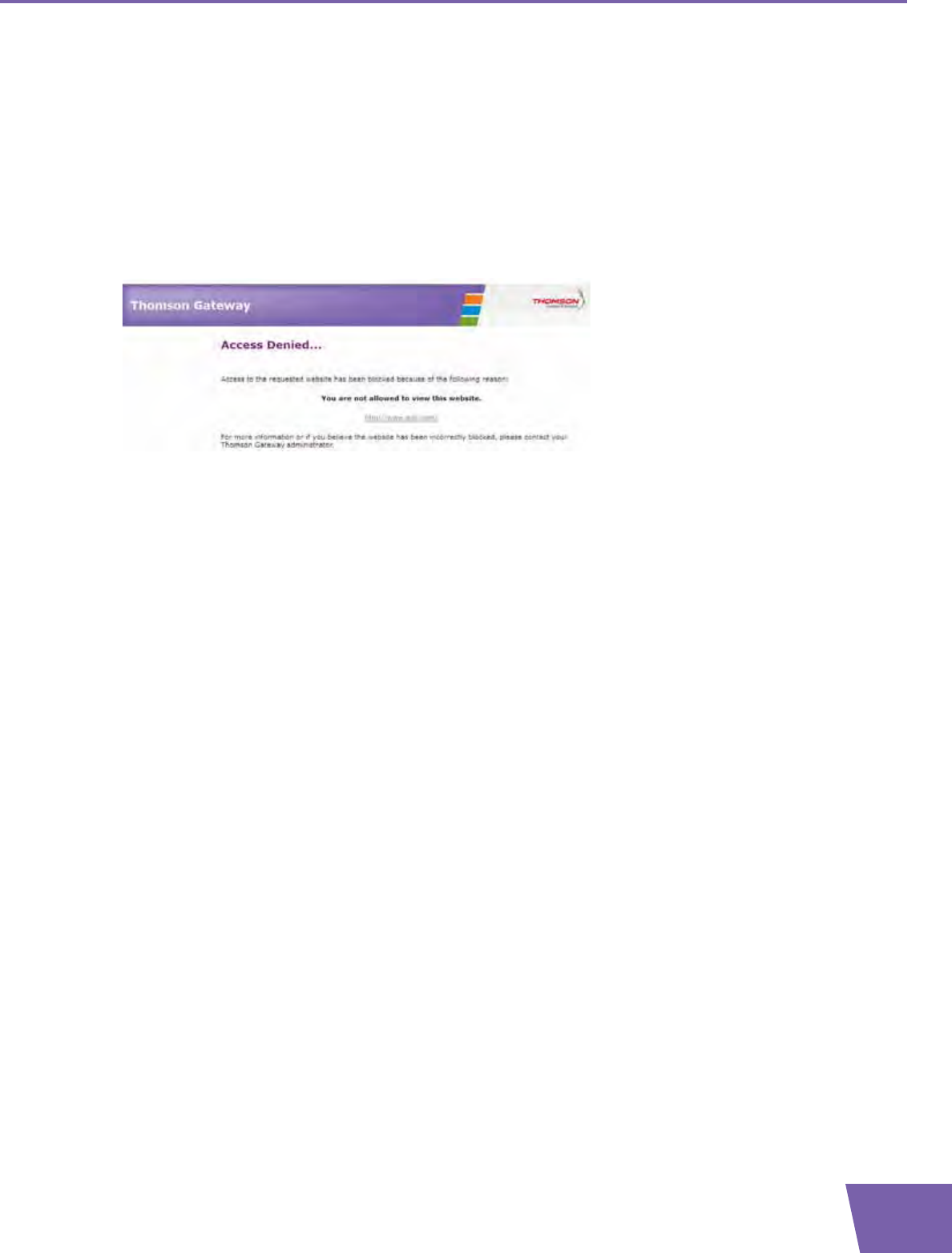
E-DOC-CTC-20080527-0012 v1.0 73
8 Internet Security
8.2 Parental Control
Introduction
The Thomson Gateway allows you to deny access to specific web sites.
Access Denied page
When a user tries to access a page that is being blocked, the following page is displayed:
Address-based filtering
With address-based filtering (or URL-filtering) you can block web sites based on their address (for example
www.porn.com).
Content-based filtering
As you know, the Internet consists of a large number of web sites, and that number still increases every day.
This makes it almost impossible to keep the list of addresses up-to-date.
To solve this problem Thomson Gateway introduced content-based filtering.
With content-based filtering you can block web sites based on their content category (for example
pornography) instead of their URL. This way, you only need to select the appropriate categories and the
content category server takes care of the rest. This content category server is updated at regular intervals.
Combining the two filters
Address-based filtering has priority over content-based filtering. This means that when you are blocking a
specific category, you can still access a specific address provided you create a rule to allow access to that
URL.
For example, if you are blocking content from the Finance / Investment category, you can create a rule to
make an exception for netbanking.mybank.com.
Activating content-based filtering
Before you can use content-based filtering you must first activate it by purchasing a license key at your
service provider or by activating the 30-day trial.
Proceed as follows:
1Browse to the Thomson Gateway GUI.
2On the Toolbox menu, click Parental Control.

E-DOC-CTC-20080527-0012 v1.0
74
8 Internet Security
3In the Pick a task list, click Activate Web Filtering License.
4The Web Filtering Activation page appears. Under License Type, select:
30-days evaluation if you first want evaluate this feature.
Standard if you have already purchased a license key. The License key box appears as soon as you
select this option. Type the license key that you received from your service provider in this box.
5Click Apply.
Option 1: content-based filter (combined with the address-based filter)
If you want to use the content-based filtering:
1Browse to the Thomson Gateway GUI.
2On the Toolbox menu, click Parental Control.
3On the Navigation bar, click Configure.
4Make sure that the Use Content-Based Filter check box is selected.
5Configure the content-based filter. For more information, see “8.2.1 Configuring The Content-based
Filter” on page 75.
6If you want to make exceptions for specific web sites, add the necessary rules in the address-based filter.
For more information, see “8.2.2 Adding Rules for the Address-Based Filter” on page 76.
Option 2: address-based filter only
Take this option if content filtering is not available on your Thomson Gateway or you don’t want to use it.
To configure address-based filtering:
1Browse to the Thomson Gateway GUI.
2On the Toolbox menu, click Parental Control.
3On the Navigation bar, click Configure.
4Make sure that the Use Address-Based Filter check box is selected.
5In the Action for Unknown Sites, select:
Allow as the default rule if you want to allow access to all web sites and manually specify which web
sites may not be accessed.
Block as the default rule if you want to deny access to all web sites and manually specify a number of
web sites that may be accessed.
6Click Apply.
7If you want to make exceptions for specific web sites, add the necessary rules in the address-based filter.
For more information, see “8.2.2 Adding Rules for the Address-Based Filter” on page 76.

E-DOC-CTC-20080527-0012 v1.0 75
8 Internet Security
8.2.1 Configuring The Content-based Filter
Accessing the configuration page
Proceed as follows:
1Browse to the Thomson Gateway GUI.
2On the Toolbox menu, click Parental Control.
3On the Navigation bar, click Configure.
4Under Content-Based Filtering you can change the settings of the content-based filter.
Configuring the content-based filter
Under Content-Based Filtering:
1Select Use Content-Based Filter check box (if needed).
2In the Action for uncategorised sites list, select a default action for sites that have not yet been
categorised.
3Under Content Level, select the content level you want to use.
If you want a more detailed view of the content that will be blocked for this level, click the Edit link next to
the content level.
If needed, you can change the Name,Description and Configuration of the content level.
4Click Apply after you have made your changes.
Creating your own content level
Proceed as follows:
1In the Pick a task list, click Create a new content level.
2Enter a Name and Description for your content level and click Next.
3Under Configuration, select:
Clone Existing Level if you want to start from an existing level. You can now select the level that you
want to clone.
White list if you want to block everything and select which content should be allowed.
Black list if you want to allow everything and select which content should be blocked.
Click Next.
4Under Configuration:
Select the check boxes of the categories/groups you want to allow.
Clear the check boxes of the categories/groups you want to block.
5Click Apply.
6Configure the content-based filter with the new level. For more information, see “Configuring the
content-based filter” on page 75.

E-DOC-CTC-20080527-0012 v1.0
76
8 Internet Security
8.2.2 Adding Rules for the Address-Based Filter
Introduction
Address-based filtering has a higher priority than content-based filtering. This means that when you are
blocking a specific category, you can still access a specific site if you allow it in the address-based filter.
Example
If you block content from the Finance / Investment category and allow access to netbanking.mybank.com,
netbanking.mybank.com will still be accessible.
Options
With the address-based filter you can:
Deny access to a specific web site.
Allow access to a specific web site.
Redirect a web site.
Redirect all web sites.
Deny access to a specific web site
Proceed as follows:
1Browse to the Thomson Gateway GUI.
2On the Toolbox menu, click Parental Control.
3Make sure the Use Address-Based Filter check box is selected.
4Type the URL of the Web site you want to block (for example “mail.provider.com”) in the Web Site box.
5In the Action list, click Block.
6Click Add.
Allow access to a specific web site
Proceed as follows:
1Browse to the Thomson Gateway GUI.
2On the Toolbox menu, click Parental Control.
3Make sure the Use Address-Based Filter check box is selected.
4Type the URL of the Web site you want to allow (for example “netbanking.bank.com”) in the Web Site
box.
5Click Allow in the Action list.
6Click Add.
Redirect a web site
Proceed as follows:
1Browse to the Thomson Gateway GUI.
2On the Toolbox menu, click Parental Control.
3Make sure the Use Address-Based Filter check box is selected.

E-DOC-CTC-20080527-0012 v1.0 77
8 Internet Security
4Type the URL of the Web site you want to redirect (for example “cracks.am”) in the Web Site box.
5Click Redirect in the Action list.
6Type the URL of the Web site you want to redirect to (for example “mycompany.com/internetpolicy.htm”)
in the Redirect box.
7Click Add.
Redirect all web sites
Proceed as follows:
1Browse to the Thomson Gateway GUI.
2On the Toolbox menu, click Parental Control.
3Make sure the Use Address-Based Filter check box is selected.
4Type “*” in the Web Site box.
5Click Redirect in the Action list.
6Type the URL of the Web site you want to redirect to (for example “mycompany.com/internetpolicy.htm”)
in the Redirect box.
7Click Add.

E-DOC-CTC-20080527-0012 v1.0
78
8 Internet Security
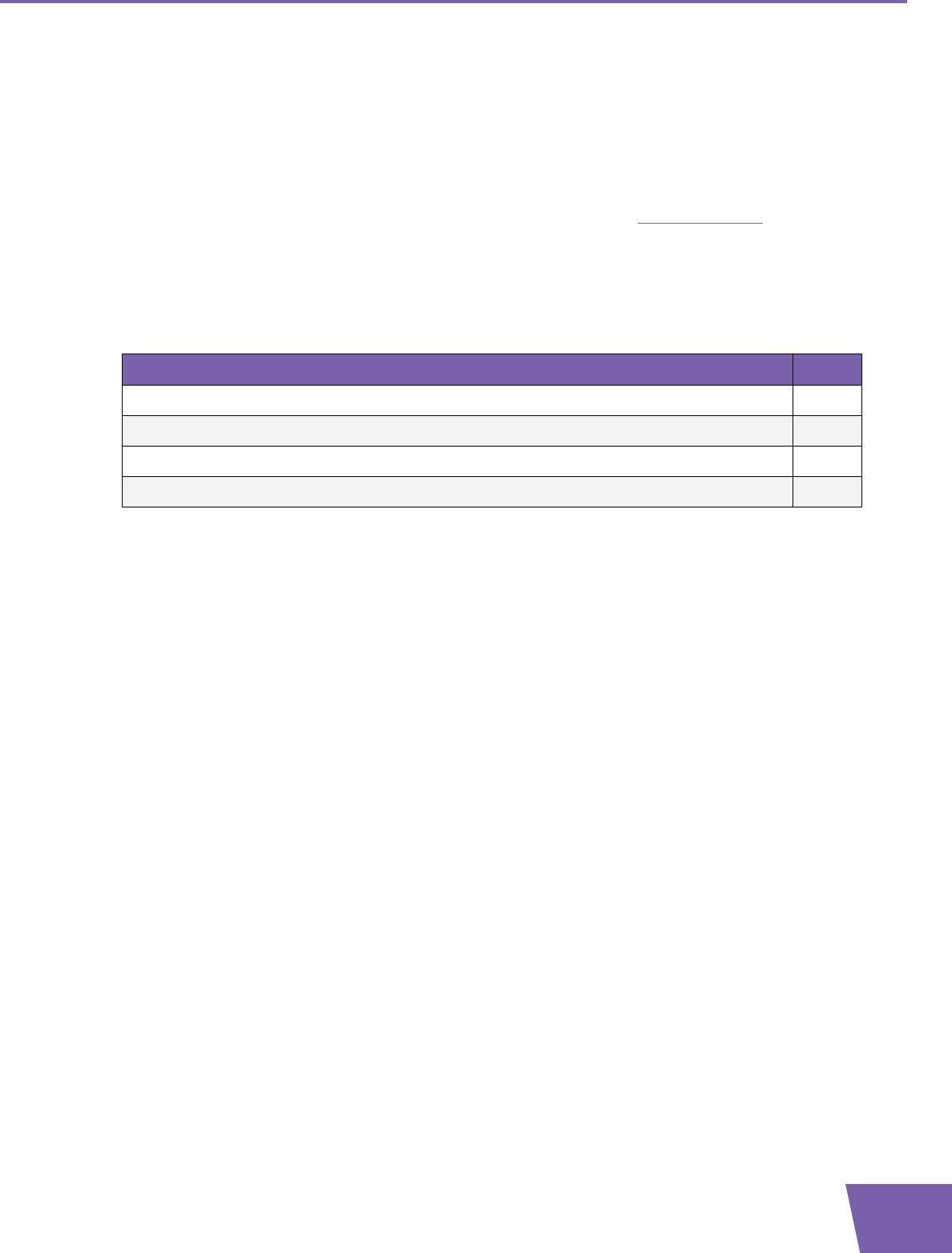
E-DOC-CTC-20080527-0012 v1.0 79
9 Troubleshooting
9 Troubleshooting
Introduction
This chapter suggests solutions for problems you may encounter while installing, configuring or using your
Thomson Gateway.
If the suggestions do not resolve the problem, look at the support pages on www.thomson.net or contact
your service provider.
Topics
This chapter describes the following topics:
Topic Page
Setup Troubleshooting 80
General Thomson Gateway Troubleshooting 81
Voice over IP Troubleshooting 84
Reset to Factory Defaults 85

E-DOC-CTC-20080527-0012 v1.0
80
9 Troubleshooting
9.1 Setup Troubleshooting
The Setup CD does not start automatically
If your computer runs:
Microsoft Windows:
1Click the Windows Start button.
2Click Run.
3In the Open field, type the following path: D:\Setup.exe, where D stands for the drive letter of your
CD- or DVD-ROM drive.
Mac OS X:
1On your desktop, double-click the CD icon.
2Double-click Menu.
Your Thomson Gateway has not been found
If you see this error during setup, make sure that:
The Thomson Gateway is turned on and fully initialized.
Your computer has a valid IP address, that is any address but 0.0.0.0. For more information, consult the
help of your operating system.
No dedicated firewall device or router is placed between your computer and the Thomson Gateway.
No personal network security software (for example firewall software) is running on your computer.
Your computer is correctly connected to the Thomson Gateway.

E-DOC-CTC-20080527-0012 v1.0 81
9 Troubleshooting
9.2 General Thomson Gateway Troubleshooting
None of the lights light up (Thomson Gateway does not work)
Make sure that:
The Thomson Gateway is plugged into a power socket outlet.
You are using the correct power supply for your Thomson Gateway device.
The Thomson Gateway is turned on via the push button or rocker switch on the back panel.
The Broadband LED does not light up
Make sure that:
The DSL cable is correctly connected. For more information, see “1.2 Installing your Thomson Gateway”.
The DSL service is enabled on your telephone line. For more information, contact your Internet Service
Provider.
The Internet LED does not light up
Make sure that your user name and password are correct.
Proceed as follows:
1Browse to the Thomson Gateway GUI.
2On the Broadband menu, click Internet Services.
3Under Internet, click View More.
4Check your user name
5Re-enter your password.
6Click Connect.
Thomson Gateway unreachable
If your Thomson Gateway cannot be reached, you might consider a hardware reset as described in “9.6 Reset
to Factory Defaults” on page 85.
Poor Thomson Gateway performance
Make sure that the Thomson Gateway is installed and configured as instructed in “1 Installation” on page 3
or as instructed by the Service Provider.
The power requirements for your Thomson Gateway are clearly indicated on the identification
label of the Thomson Gateway. Only use the power adaptor supplied with your Thomson
Gateway.

E-DOC-CTC-20080527-0012 v1.0
82
9 Troubleshooting
9.3 Wired Connection Troubleshooting
Ethernet LED does not light up
Make sure that:
The Ethernet cable is securely connected to the Ethernet port on your Thomson Gateway and your
computer.
You are using the correct cable type for your Ethernet equipment, that is UTP CAT5 with RJ-45
connectors.
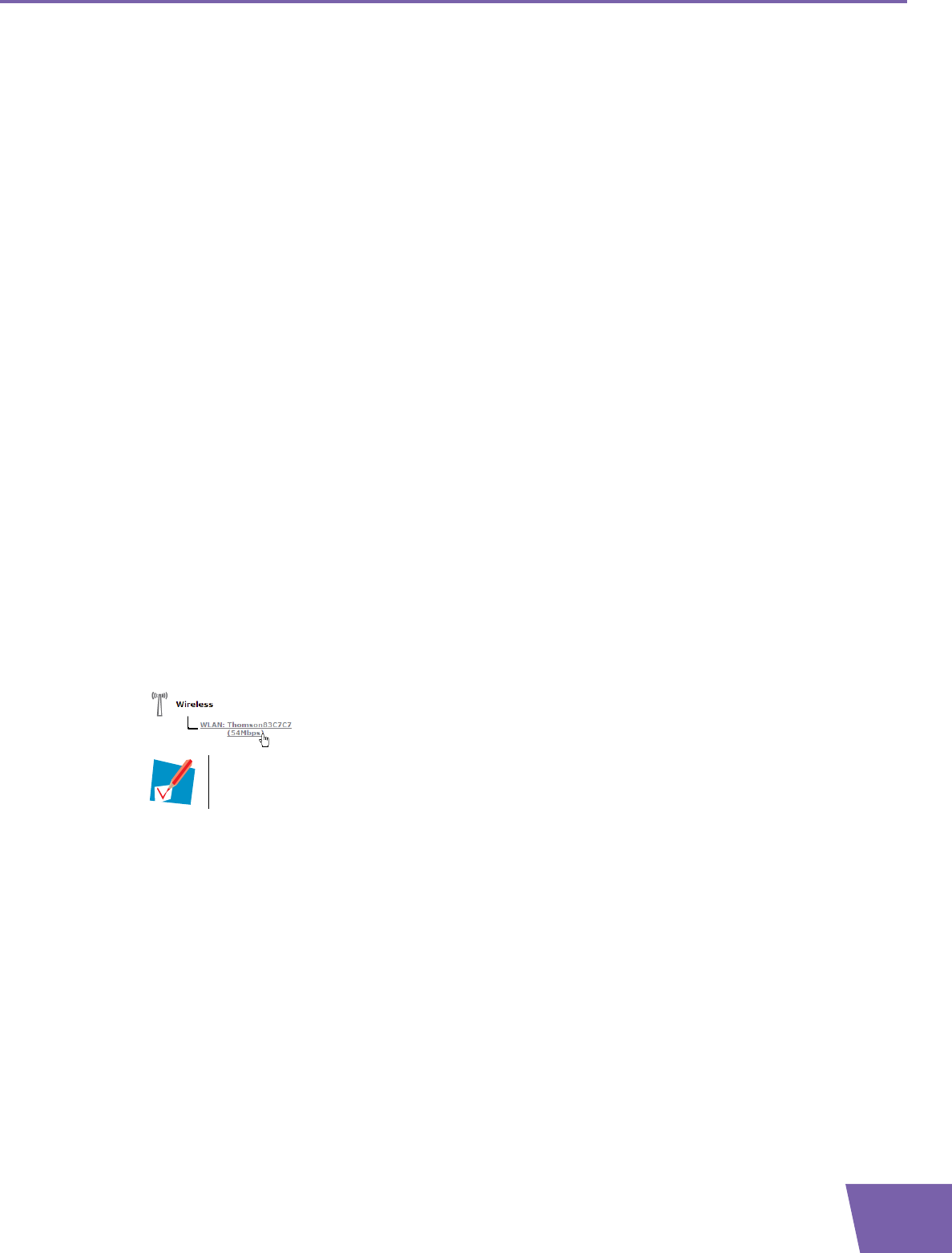
E-DOC-CTC-20080527-0012 v1.0 83
9 Troubleshooting
9.4 Wireless Connection Troubleshooting
No Wireless Connectivity
Try the following:
Change the wireless channel.
Make sure that the wireless client is configured for the correct wireless settings (Network Name, security
settings).
Check the signal strength, indicated by the wireless client manager. If the signal is low, try repositioning
the Thomson Gateway or directing the Thomson Gateway’s antenna(s) for optimal performance.
Make sure that the wireless client adapter is enabled (message like “radio on”).
Poor Wireless Connectivity or Range
Try the following:
Change the wireless channel.
Check the signal strength, indicated by the wireless client manager. If the signal is low, try to place the
Thomson Gateway or to direct the Thomson Gateway’s antenna(s) for optimal performance.
Use WPA(2)-PSK as encryption.
For more information, see “3.3 Securing Your Wireless Connection” on page 31.
Change the wireless channel
Proceed as follows:
1Browse to the Thomson Gateway GUI.
2On the left menu, click Home Network.
3Under Wireless, click your access point.
4The Wireless Access Point page appears.
5In the Navigation bar, click Configure.
6Under Configuration, select the channel of your choice in the Channel Selection list.
7Click Apply.
Can not connect via WPS
If you are having trouble connecting your wireless client via WPS, try to configure it manually. For more
information, see “3.2 Connecting Your Wireless Client without WPS” on page 30.
Your access point will be listed in the following format: “WLAN:<Network Name> (<Actual
Speed>)”. For example, WLAN: Thomson83C7C7 (54Mbps).

E-DOC-CTC-20080527-0012 v1.0
84
9 Troubleshooting
9.5 Voice over IP Troubleshooting
Introduction
If you cannot make or receive any phone calls via your Thomson Gateway, try the suggestions in the
following sections.
Calling over VoIP
If you have problems calling via VoIP, check whether:
Your phone is correctly connected to the Thomson Gateway.
Your phone is working on the traditional telephone network (PSTN):
Connect your phone directly to the telephone wall outlet.
Try to make a phone call.
Your phone number, user name, and password are configured correctly.
The registrar’s and proxy server’s IP address and port number are configured correctly.
The Power,Broadband/DSL and Voice LEDs are on.
Calling over the traditional telephone network (PSTN)
If you have problems calling via the traditional telephone network, check whether:
Your phone is correctly connected to the Thomson Gateway.
Your phone is working on the PSTN network:
Connect your phone directly to PSTN.
Try to make a phone call.
The Forced FXO service is activated, this means that your service provider may request you to dial an
extra prefix for making calls via PSTN.
Problems with Telephony Services
If you have a problem with a service, check whether the service is activated. For more information, see
“4.3.2 Activating a Telephony Service on your Thomson Gateway” on page 44.
If the Thomson Gateway is turned off, phone calls are always routed over PSTN.

E-DOC-CTC-20080527-0012 v1.0 85
9 Troubleshooting
9.6 Reset to Factory Defaults
Resetting your Thomson Gateway
If at some point you can no longer connect to the Thomson Gateway or you want to make a fresh install, it
may be useful to perform a reset to factory defaults.
Warning
A reset to factory default settings deletes all configuration changes you made. Therefore, after the reset, a
reconfiguration of your Thomson Gateway will be needed.
Also your wireless clients will have to be re-associated, as described in “3 Wireless Access” on page 27.
Methods
You can choose between:
Resetting the Thomson Gateway via the Thomson Gateway GUI
Reset the Thomson Gateway via the Reset button
Resetting the Thomson Gateway via the Thomson Gateway GUI
Proceed as follows:
1Browse to the Thomson Gateway GUI.
2On the Thomson Gateway menu, click Configuration.
3In the Pick a task list, click Reset my Thomson Gateway.
4The Thomson Gateway restores the initial configuration and restarts.
5The Thomson Gateway returns to the Thomson Gateway home page (unless the IP address of your
computer is not in the same subnet as the default IP address of the Thomson Gateway, being
192.168.1.254).
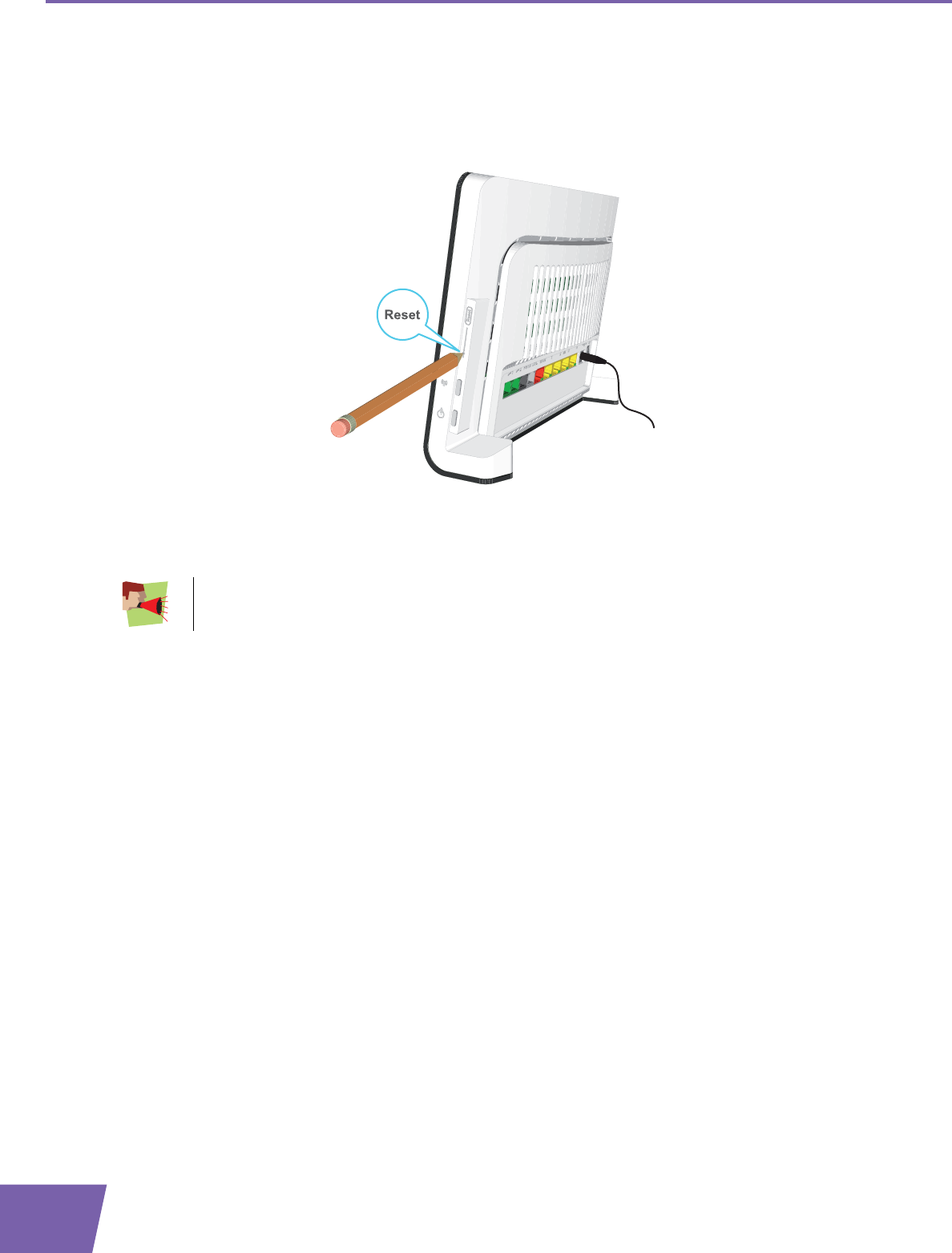
E-DOC-CTC-20080527-0012 v1.0
86
9 Troubleshooting
Reset the Thomson Gateway via the Reset button
Proceed as follows:
1Make sure the Thomson Gateway is turned on.
2Push the Reset button until the Power LED lights red - this will take about 7 seconds.
3Release the Reset button.
4The Thomson Gateway restarts.
Your system administrator may have disabled the physical reset button of the Thomson
Gateway. In this case, a hardware reset to defaults is not possible.

THOMSON Telecom Belgium
Prins Boudewijnlaan 47
2650 Edegem
Belgium
www.thomson.net
© THOMSON 2010. All rights reserved.
E-DOC-CTC-20080527-0012 v1.0.
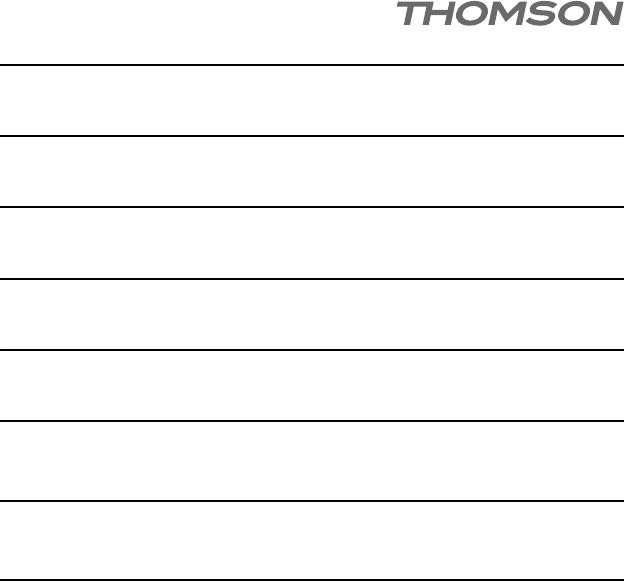
Safety Instructions and Regulatory Notices 3
Read this document prior to installation!
Consignes de Sécurité et Informations Réglementaires 9
Lisez ce document avant d’effectuer l’installation!
Sicherheitshinweise und Zulassungsbestimmungen 14
Liest dieses Dokument vor Installation!
Instrucciones de Seguridad e Información Sobre Regulaciones 19
Lea este documento antes de proceder a la instalación!
Instruções de Segurança e Informações Sobre Normas 24
Leia este documento antes de iniciar a instalaçio!
Precauzioni di Sicurezza e Informazioni Sulla Normativa 29
Legger questo documento prima di eseguire l’ instalaçao!
Säkerhetsföreskrifter och -Information 34
Läs säkerhetsföreskrifterna noggrat!
Veiligheidsvoorschriften en Regelgevingsinformatie 39
Gelieve dit document te lezen alvorens te starten met installatie!
EN
FR
DE
E
S
PT
IT
S
V
NL

3
SAFETY INSTRUCTIONS AND REGULATORY NOTICES
BEFORE YOU START INSTALLATION OR USE OF THIS PRODUCT, CAREFULLY READ THESE INSTRUCTIONS
Wireless
In case this product is equipped with a wireless transceiver, it uses Direct Sequence Spread Spectrum (DSSS) /
Orthogonal Frequency Division Modulation (OFDM) radio technology. As such it is designed to be inter-operable with
any other wireless DSSS/OFDM type product that:
>Complies with the IEEE802.11b/IEEE802.11g/IEEE802.11n Standard on Wireless LANs, as defined and approved
by the Institute of Electrical and Electronics Engineers.
>Is Wi-Fi® CERTIFIED™ as defined by the Wi-Fi® Alliance.
Directive
Unless express and prior approval by THOMSON in writing, you may not:
>Disassemble, de-compile, reverse engineer, trace or otherwise analyse the equipment, its content, operation, or
functionality,
or otherwise attempt to derive source code (or the underlying ideas, algorithms, structure or organization) from
the equipment,
or from any other information provided by THOMSON, except to the extent that this restriction is expressly
prohibited by local law;
>Copy, rent, loan, re-sell, sub-license, or otherwise transfer or distribute the equipment to others;
>Modify, adapt or create a derivative work of the equipment;
>Remove from any copies of the equipment any product identification, copyright or other notices;
>Disseminate performance information or analysis (including, without limitation, benchmarks) from any source
relating to the equipment.
Such acts not expressly approved by THOMSON will result in the loss of product warranty and may invalidate the
user's authority to operate this equipment in accordance with FCC Rules.
THOMSON disclaims all responsibility in the event of use that does not comply with the present instructions.
!
When using this product, always follow the basic safety precautions to reduce the risk of fire, electric
shock and injury to persons, including the following:
>Always install the product as described in the documentation that is included with your product.
>Avoid using this product during an electrical storm. There may be a remote risk of electric shock from
lightning.
>Do not use this product to report a gas leak in the vicinity of the leak.

4
Environmental information - WEEE directive
Please help us protect the environment in which we live!
Safety Instructions
Climatic conditions
This product:
>Is intended for in-house stationary desktop use; the maximum ambient temperature may not exceed 40°C
(104°F).
>Must not be mounted in a location exposed to direct or excessive solar and/or heat radiation.
>Must not be exposed to heat trap conditions and must not be subjected to water or condensation.
>Must be installed in a Pollution Degree 2 environment (Environment where there is no pollution or only dry,
nonconductive pollution).
Cleaning
Unplug this product from the wall socket and computer before cleaning. Do not use liquid cleaners or aerosol
cleaners. Use a damp cloth for cleaning.
Water and moisture
Do not use this product near water, for example, near a bathtub, washbowl, kitchen sink, laundry tub, in a wet
basement or near a swimming pool. Transition of the product from a cold environment to a hot one, may cause
condensation on some of its internal parts. Allow it to dry by itself before re-starting the product.
Interface classifications
The external interfaces on the rear panel of the product are classified as follows:
>DSL, ADSL, SHDSL, VDSL, Line: TNV circuit, subjected to over voltages (TNV-3)
>ISDN: SELV circuit
>PSTN, FXO: TNV circuit, subjected to over voltages (TNV-3)
This symbol means that your inoperative electronic appliance must be collected separately and not mixed
with the household waste.The European Union has implemented a specific collection and recycling system
for which producers are responsible.
This appliance has been designed and manufactured with high quality materials and components that can be
recycled and reused.
Electrical and electronic appliances are liable to contain parts that are necessary in order for the system to
work properly but which can become a health and environmental hazard if they are not handled or disposed
of in the proper way. Consequently, please do not throw out your inoperative appliance with the household
waste.
If you are the owner of the appliance, you must deposit it at the appropriate local collection point or leave it
with the vendor when buying a new appliance.
>If you are a professional user, please follow your supplier's instructions.
>If the appliance is rented to you or left in your care, please contact your service provider.

5
>Phone, VoIP, FXS: TNV circuit, not subjected to over voltages (TNV-2)
>All other interface ports (e.g. Ethernet, 10/100Base-T/MDI(-X), USB, Console, Craft, etc.), including the low
voltage power input from the AC mains power supply: SELV circuits.
Electrical powering
The powering of the product must adhere to the power specifications indicated on the marking labels.
The power supply must be Class II and a Limited Power Source in accordance with the requirements of IEC60950-1/
EN60950-1, Clause 2.5 and rated as indicated on the label on your product. It must be tested and approved to national
or local standards.
For US and Canada: This product is intended to be supplied by a Listed Direct Plug-in, or Desktop Power Unit
marked "Class 2" and rated as indicated on the label on your product.
The use of other types of supplies is prohibited. If you are not sure of the type of power supply needed, consult the
product's user documentation or contact your local product dealer.
ISDN
USB
The device is to be connected to an identified USB port complying with the requirements of a Limited Power Source.
Telephone cable
Connect the telecommunication line cord only in the PSTN, FXO, DSL, ADSL, SHDSL, VDSL or Line port of the
product. Never plug the telecommunication line cord in another receptacle of the product.
Follow the installation instructions in the sequence as outlined in the installation guide.
Central splitter / distributed filter(s) (if applicable)
If telephone service is required on the same line, a central splitter or distributed filter(s) must be installed for optimal
DSL performance.
Depending on your DSL configuration and type of splitter / filters, installation must be carried out by qualified service
personnel. Consult your telephone service company or DSL service provider for instructions.
!
WARNING
>The Phone, VoIP, FXS port will be classified as a TNV-3 circuit when connected internally to the PSTN,
FXO port, for example, when the device is powered off.
>If the product is equipped with a USB interface (slave and/or master) or any type of connector with
metallic shielding, then it is not allowed to connect the Phone, VoIP, FXS port with the PSTN, FXO or the
DSL, ADSL, SHDSL, VDSL, Line port by any means, for example with an external telephone cable.
!
WARNING
For US and Canada: Do not use the ISDN port; do not attempt to connect this port to the network at
anytime.
!
CAUTION
To reduce the risk of fire, use only No 26 AWG wire size or larger telecommunication line cord.
6
Accessibility
The Direct Plug-in power supply, or the plug on the power supply cord serves as disconnect device. Be sure that the
power socket outlet you plug the power supply into is easily accessible and located as close to the equipment as
possible.
Overloading
Do not overload mains supply socket outlets and extension cords as this increases the risk of fire or electric shock.
Servicing
To reduce the risk of electric shock, do not disassemble this product. None of its internal parts are user-replaceable;
therefore, there is no reason to access the interior. Opening or removing covers may expose you to dangerous
voltages. Incorrect reassembly could cause electric shock if the appliance is subsequently used.
If service or repair work is required, take it to a qualified service dealer.
Damage requiring service
Unplug this product from the wall outlet and refer servicing to qualified service personnel under the following
conditions:
>When the power supply or its plug are damaged.
>When the attached cords are damaged or frayed.
>If liquid has been spilled into the product.
>If the product has been exposed to rain or water.
>If the product does not operate normally.
>If the product has been dropped or damaged in any way.
>There are noticeable signs of overheating.
>If the product exhibits a distinct change in performance.
Immediately disconnect the product if you notice it giving off a smell of burning or smoke. Under no circumstances
must you open the equipment yourself; you run the risk of electrocution.
Regulatory Information
You must install and use this device in strict accordance with the manufacturer's instructions as described in the user
documentation that is included with your product.
Before you start installation or use of this product, carefully read the contents of this document for device specific
constraints or rules that may apply in the country where you want to use this product.
In some situations or environments, the use of wireless devices may be restricted by the proprietor of the building or
responsible representatives of the organization.
If you are uncertain of the policy that applies on the use of wireless equipment in a specific organization or
environment (e.g. airports), you are encouraged to ask for authorization to use this device prior to turning on the
equipment.
THOMSON is not responsible for any radio or television interference caused by unauthorized modification of the
device, or the substitution or attachment of connecting cables and equipment other than specified by THOMSON.
The correction of interference caused by such unauthorized modification, substitution or attachment will be the
responsibility of the user.
THOMSON and its authorized resellers or distributors are not liable for any damage or violation of government
regulations that may arise from failing to comply with these guidelines.
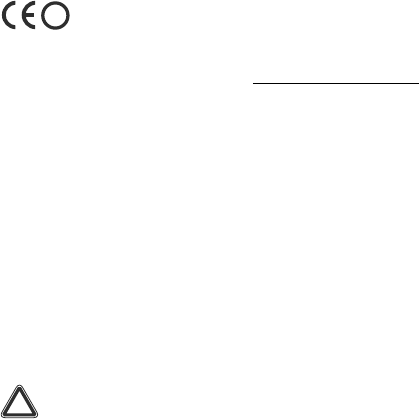
7
Europe - European Union
European Community Declaration of Conformity
This equipment can be used in all countries that are member of the European Union and that are member of the
European Free Trade Association.
The Declaration of Conformity can be found on www.thomson-broadband.com.
In case this product is equipped with a wireless transceiver:
>it is restricted to indoor use only.
>it complies with the basic restrictions and limits as defined in the European Council Recommendation (1999/519/
EC) on the limitation of exposure of the general public to Electromagnetic fields.
North-America - Canada
Notification of Canadian Radio Frequency Interference Statement
This Class B digital apparatus complies with Canadian ICES-003.
NOTICE: This product meets the applicable Industry Canada technical specifications.
NOTICE: The ringer Equivalence Number (REN) for this terminal equipment is 0.1. The REN is an indication of the
maximum number of devices allowed to be connected to a telephone interface. The termination on an interface may
consist of any combination of devices subject only to the requirement that the sum of the RENs of all the devices
does not exceed five.
Canada - Industry Canada (IC)
In case this product is equipped with an IEEE802.11b/IEEE802.11g/IEEE802.11n wireless transceiver, complying with
RSS 210 and/or RSS 213 of Industry Canada, operation is subject to the following two conditions:
1This device may not cause harmful interference.
2This device must accept any interference received, including interference that may cause undesired
operation of the device.
Restricted Frequency Band
In case this product is equipped with an IEEE802.11b/IEEE802.11g/IEEE802.11n wireless transceiver, it only uses
channels 1 to 11 (2412 to 2462 MHz) on Canada territory.
!
Hereby, THOMSON, declares that this product is in compliance with the essential requirements and
other relevant provisions of Directive 1999/5/EC of the European Parliament and of the Council.
!
IMPORTANT NOTE: Radiation Exposure Statement
This equipment complies with IC radiation exposure limits set forth for an uncontrolled environment. This
equipment should be installed and operated with minimum distance 20cm between the radiator and your
body.
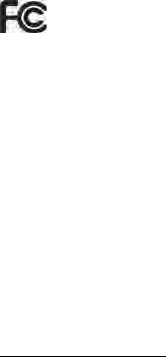
8
North-America - United States of America
Federal Communications Commission (FCC) Radio Frequency Interference Statement
If not installed and used in accordance with the instructions, it may cause harmful interference to radio
communications. However, there is no guarantee that interference will not occur in a particular installation. If this
equipment does cause harmful interference to radio or television reception, which can be determined by turning the
equipment ON and OFF, the user is encouraged to try to correct the interference by one or more of the following
measures:
>Reorient or relocate the receiving antenna.
>Increase the separation between the equipment and receiver.
>Connect the equipment into an outlet on a circuit different from that to which the receiver is connected.
>Consult the dealer or an experienced radio/television technician for help.
The FCC requires the user to be notified that any changes or modifications to this device that are not expressly
approved by THOMSON may void the user's authority to operate the equipment.
Responsible Party: THOMSON Inc., 10330 North Meridian Street, Indianapolis, IN 46290 USA, (580) 634-0151.
This equipment complies with Part 68 of the FCC Rules.
The customer information required for Telephone Terminal Equipment ("TTE") approved for connection to the Public
Switched Telephone Network ("PSTN"), pursuant to 47 CFR §68.218(b)(1) can be found at
www.thomson-broadband.com.
RF-Exposure Statement
When the product is equipped with a wireless interface, then it becomes a mobile or fixed mounted modular
transmitter and must have a separation distance of at least 20cm between the antenna and the body of the user or
nearby persons. In practice, this means that the user or nearby persons must have a distance of at least 20cm from
the modem and must not lean on the modem in case it is wall-mounted.
With a separation distance of 20cm or more, the M(aximum) P(ermissible) E(xposure) limits are well above the
potential this module is capable to produce.
The transmitter shall not be collocated with other transmitters or antennas.
Restricted Frequency Band
In case this product is equipped with an IEEE802.11b/IEEE802.11g/IEEE802.11n wireless transceiver, it may only use
channels 1 to 11 (2412 to 2462 MHz) on U.S.A. territory.
This device has been tested and found to comply with the limits for a Class B digital device, pursuant to
Part 15 of the FCC Rules. These limits are designed to provide reasonable protection against such
interference in a residential installation.
This equipment generates, uses and can radiate radio frequency energy. Operation is subject to the
following two conditions:
1This device may not cause harmful interference, and
2This device must accept any interference received, including interference that may cause
undesired operation.

9
CONSIGNES DE SÉCURITÉ ET INFORMATIONS RÉGLEMENTAIRES
AVANT D’INSTALLER OU D’UTILISER LE PRODUIT, LISEZ ATTENTIVEMENT CES INSTRUCTIONS
Réseau sans fil
Si le produit est équipé d'un émetteur-récepteur sans fil IEEE802.11b/IEEE802.11g/IEEE802.11n, il utilise la
technologie radio DSSS (Modulation du spectre à séquence directe) / OFDM (Multiplexage par répartition orthogonale
de la fréquence). En tant que tel, il est étudié pour fonctionner sans problèmes avec n’importe quel autre produit sans
fils supportant la norme DSSS/OFDM qui:
>est conforme à la norme IEEE 802.11b/IEEE802.11g/IEEE802.11n relative aux réseaux locaux sans fil, telle que
définie et approuvée par l’IEEE (Institute of Electrical and Electronics Engineers).
>est certifié Wi-Fi® CERTIFIED™ par l’Alliance Wi-Fi®.
Consignes à respecter
Sauf accord écrit explicite et préalable de THOMSON, vous ne pouvez pas:
>démonter, décompiler, décomposer, examiner ou analyser de quelque manière que ce soit l'appareil, son
contenu, son fonctionnement ou ses fonctionnalités,
ni tenter de copier le code source (ou les concepts sous-jacents, les algorithmes, la structure ou l'organisation) de
l'appareil,
ou de toute autre information fournie par THOMSON, sauf si cette restriction est expressément interdite par la
législation locale;
>copier, louer, prêter, revendre, mettre sous licence, ni transférer ou distribuer l'appareil à des tiers;
>modifier, adapter ou créer un dérivé de l'appareil;
>retirer de l'appareil l'identification du produit, les droits d'auteur ou toute autre notification;
>diffuser des informations ou analyses relatives aux performances de l'appareil (y compris et sans restriction, les
tests de performance) quelle que soit la source d'information.
Ces actes, réalisés sans l'accord explicite de THOMSON, entraînent la perte de la garantie du produit et enlèvent à
l'utilisateur le droit d'employer l'équipement.
THOMSON rejette toute responsabilité en cas d'utilisation de l'équipement non conforme aux présentes instructions.
!
Afin d’éviter tout risque d’incendie, de choc électrique et de blessure corporelle, il convient d’utiliser le
produit conformément aux mesures de sécurité de base, parmi lesquelles les suivantes:
>Respectez toujours les instructions d’installation détaillées dans la documentation accompagnant le
produit.
>Évitez de connecter ou d'utiliser ce produit en cas d'orage.La foudre peut provoquer un faible risque de
choc électrique.
>N’utilisez pas le produit pour signaler une fuite de gaz à proximité de cette fuite.

10
Environnement - Directive DEEE (WEEE)
Aidez-nous à préserver l'environnement dans lequel nous vivons !
Consignes de sécurité
Conditions climatiques
Ce produit:
>est conçu pour une utilisation fixe dans un bureau à une température ambiante maximale de 40°C (104°F).
>ne doit pas être installé dans un endroit exposé au rayonnement direct et excessif du soleil et/ou à des radiations
de chaleur.
>ne doit pas être mis dans des conditions d'accumulation de chaleur et ne doit pas être soumis à l'humidité ou la
condensation.
>doit être installé dans un environnement présentant un degré de pollution 2 (environnement exempt de pollution
ou avec une pollution sèche, non conductrice).
Nettoyage
Débranchez l'appareil de la prise murale et de l'ordinateur avant de le nettoyer. N'utilisez pas de détergents liquides
ou d'aérosols. Nettoyez-le avec un chiffon humide.
Eau et humidité
N'utilisez pas ce produit à proximité d'une arrivée d'eau, par exemple près d'une baignoire, d'un lavabo, d'un évier,
d'une machine à laver, dans un sous-sol humide ou près d'une piscine. Le transfert de ce produit d'un environnement
froid vers un environnement chaud peut entraîner l'apparition de condensation sur certaines parties internes. Laissez
l'appareil sécher avant de le remettre en marche.
Classification des interfaces
Les interfaces externes situées sur le panneau arrière du produit sont spécifiées comme suit:
>DSL, ADSL, SHDSL, VDSL, Line: circuit TRT, sujet à des surtensions (TRT-3)
>ISDN: circuit TBTS
>PSTN, FXO: circuit TRT, sujet à des surtensions (TRT-3)
Ce symbole signifie que votre appareil électronique hors d'usage doit être collecté séparément et non jeté
avec les déchets ménagers. Dans ce but, l'Union Européenne a institué un système de collecte et de
recyclage spécifique dont les producteurs ont la responsabilité.
Cet appareil a été conçu et fabriqué avec des matériaux et des composants de haute qualité pouvant être
recyclés et réutilisés.
Les appareils électriques et électroniques sont susceptibles de contenir des éléments qui, bien
qu'indispensables au bon fonctionnement du système, peuvent s'avérer dangereux pour la santé et
l'environnement s'ils sont manipulés ou éliminés de manière incorrecte. Par conséquent, veuillez ne pas
jeter votre appareil usagé avec les ordures ménagères.
Si vous êtes propriétaire de l'appareil, vous devez le déposer au point de collecte local approprié ou le
remettre à votre vendeur contre l'achat d'un produit neuf.
>Si vous êtes un utilisateur professionnel, référez vous aux instructions de votre fournisseur.
>Si l'appareil vous est loué ou remis en dépôt, contactez votre fournisseur de service.

11
>Phone, VoIP, FXS: circuit TRT, non sujet à des surtensions (TRT-2)
>Tous les autres ports d'interface (par example, Ethernet, 10/100Base-T/MDI(-X), USB, Console, Craft, etc.), y
compris l'entrée d'alimentation basse tension depuis l'alimentation du réseau: circuits TBTS.
Alimentation électrique
L'alimentation du produit doit respecter les spécifications en matière d'alimentation figurant sur les étiquettes.
L'alimentation doit être de classe II, être une source à puissance limitée conformément aux exigences de la norme
CEI60950-1/ EN60950-1, clause 2.5, aux caractéristiques nominales comme indiquées sur l’étiquette fixée sur le
produit. Elle doit être testée et répondre aux normes nationales ou locales.
Pour le Canada : Ce produit est destiné à être utilisé avec une alimentation directement enfichable, ou module de
bureau et cataloguée de classe 2 aux caractéristiques nominales comme indiquées sur l’étiquette fixée sur le produit.
L'utilisation d'autres types de sources d'énergie est interdite. Si vous n'êtes pas certain du type d'alimentation
nécessaire, veuillez consulter la documentation fournie avec le produit ou contacter votre revendeur local.
ISDN
USB
L'appareil doit être connecté à un port USB identifié qui réponde aux besoins d'une source à puissance limitée.
Câble téléphonique
Connectez uniquement le câble téléphonique dans la prise PSTN, FXO, DSL, ADSL, SHDSL, VDSL ou Line du produit.
Ne le branchez jamais dans une autre prise du produit.
Suivez la procédure pour connecter les câbles au produit en suivant la séquence décrite dans le guide d'installation.
Répartiteur central / filtre(s) distribués (le cas échéant)
Si les signaux téléphoniques doivent arriver sur la même ligne, un répartiteur central ou un (des) filtre(s) distribué(s)
doivent être installés pour garantir une performance DSL optimale.
Selon votre configuration DSL et le type de répartiteur/filtres, l'installation doit être effectuée par un membre du
personnel d'entretien qualifié. Consultez votre opérateur de télécommunications ou votre fournisseur de service DSL
pour obtenir des instructions.
!
AVERTISSEMENT
>Le port Phone, VoIP, FXS sera classifié comme un circuit TRT-3 lorsqu’il est raccordé en interne au port
PSTN, FXO, par exemple, lorsque le périphérique est mis hors tension.
>Si le produit est équipé d’une interface USB (esclave et/ou maître) ou d’un autre type de connecteur avec
un blindage métallique, il est interdit de relier le port Phone, VoIP, FXS au port PSTN, FXO ou au port DSL,
ADSL, SHDSL, VDSL, Line par un moyen quelconque, par exemple, à l’aide d’un câble téléphonique
externe.
!
Avertissement !
Pour le Canada : N'utilisez pas le port ISDN et n'essayez jamais de connecter ce port au réseau.
!
ATTENTION
Pour réduire les risques d'incendie, utilisez uniquement des conducteurs de télécommunications 26 AWG ou
de section supérieure.
12
Accessibilité
L'alimentation enfichable directement ou la fiche de prise de courant du câble d'alimentation aussi de système de
déconnection. Assurez-vous donc que le socle de la prise dans laquelle vous branchez le cordon d'alimentation est
facilement accessible, et est située le plus près possible de l'équipement.
Surcharge
Ne surchargez pas les socles des prises du réseau d'alimentation ni les rallonges car ceci augmente les risques
d'incendie et de choc électrique.
Entretien
Pour réduire les risques de choc électrique, ne démontez pas ce produit. Aucune de ses pièces internes ne peut être
remplacée par un non-professionnel; il n'y a dès lors pas de raison de l'ouvrir. L'ouverture ou le retrait des couvercles
peut vous exposer à des tensions dangereuses. Un remontage incorrect peut entraîner un choc électrique lors de
l’utilisation suivante.
Si votre appareil doit être réparé ou révisé, confiez-le à un distributeur agréé.
Détérioration nécessitant une intervention
Débranchez ce produit de la prise murale et faites effectuer la réparation par un service après-vente qualifié dans les
cas suivants:
>Si l'alimentation ou sa fiche sont endommagées.
>Si un des câbles fournis est endommagé ou effiloché.
>Si vous avez renversé du liquide dans le produit.
>Si le produit a été exposé à la pluie ou à de l'eau.
>Si le produit ne fonctionne pas normalement.
>Si le produit est tombé ou a été endommagé d'une façon quelconque.
>S’il y a un signe perceptible de surchauffe.
>Si le produit présente des variations importantes au niveau des performances.
Débranchez immédiatement le produit si vous remarquez qu'il s'en dégage une odeur de brûlé ou de la fumée. Vous
ne devez en aucun cas ouvrir l'appareil vous-même car vous risquez d'être électrocuté.
Avis réglementaire
L’appareil doit être installé et utilisé en stricte conformité avec les instructions du fabricant, énoncées dans la
documentation accompagnant le produit.
Avant d’installer ou d’utiliser le produit, lisez attentivement ce document afin de prendre connaissance des
restrictions spécifiques à l’appareil ou des règles en vigueur dans le pays où vous comptez l’utiliser.
Dans certains environnements ou circonstances, l’emploi de dispositifs sans fil peut être prohibé par le propriétaire du
bâtiment ou les représentants responsables de l’organisation concernée.
En cas de doute quant à la politique s’appliquant à l’utilisation d’équipements sans fil dans une organisation ou un
environnement spécifique (par exemple dans les aéroports), il est recommandé de demander la permission d’utiliser
l’appareil avant de l’allumer.
THOMSON n’est pas responsable des interférences avec les postes de radio ou de télévision susceptibles de
survenir à la suite d’une modification non autorisée de l’appareil ou du remplacement ou de la connexion de câbles et
d’équipements non agréés par THOMSON. C’est par conséquent à l’utilisateur qu’il incombe de remédier aux
interférences causées par de telles manipulations.
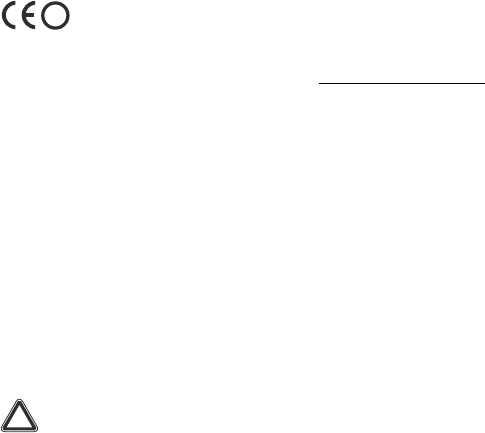
13
THOMSON et ses revendeurs et distributeurs agréés déclinent toute responsabilité quant aux dommages ou violation
des réglementations nationales découlant du non-respect de ces instructions.
Europe – l’Union Européenne
Déclaration de conformité pour la Communauté Européenne
Ce produit peut être utilisé dans les pays membres de l’Union Européenne et de l'Association Européenne de Libre
Échange.
Vous pouvez trouver la déclaration de conformité sur le site www.thomson-broadband.com.
Dans le cas où ce produit est équipé d'un récepteur sans fil IEEE802.11b/IEEE802.11g/IEEE802.11n:
>son usage est limité à l'intérieur d’un bâtiment.
>il est conforme aux restrictions et limites telles que définies par la recommandation (1999/519/CE) du conseil
Européen relative à la limitation de l'exposition du public aux champs électromagnétiques.
Amérique du Nord – Canada
Déclaration Canadienne d’interférence de Fréquence Radio.
Cet appareil numérique de Classe B est conforme à la norme canadienne NMB-003.
NOTE: Le présent matériel est conforme aux spécifications techniques applicables d’Industrie Canada.
NOTE: L'indice d'équivalence de la sonnerie (IES) sert à indiquer le nombre maximal de terminaux qui peuvent être
raccordés à une interface téléphonique. La terminaison d'une interface peut consister en une combinaison
quelconque de dispositifs, à la seule condition que la somme d'indices d'équivalence de la sonnerie de tous les
dispositifs n'excède pas 5.
Canada - Industrie Canada (IC)
Si le produit est équipé d'un émetteur-récepteur sans fil IEEE802.11b/IEEE802.11g/IEEE802.11n, il est conforme à la
norme RSS-210 et/ou RSS-213 de Industrie Canada. L’utilization de ce dispositive est autorisée seulement aux deux
conditions suivant:
1il ne doit pas produire de brouillage, et
2l’utilisateur du dispositivf doit être prêt à accepter tout brouillage radioélectrique reçu, même si ce brouillage
est susceptible de compromettre le fonctionnement du dispositif
Bande de fréquence restreinte
Si le produit est équipé d'un émetteur-récepteur sans fil IEEE802.11b/IEEE802.11g/IEEE802.11n, il utilise uniquement
les canaux 1 à 11 (2 412 à 2 462 MHz) sur le territoire canadien.
!
Par la présente THOMSON déclare que l'appareil est conforme aux exigences essentielles et aux autres
dispositions pertinentes de la Directive 1999/5/CE du Parlement européen et du Conseil.
!
Notice Importante: Avis radiation énoncées
Cet équipement se conforme avec les limites d’exposition aux radiations énoncées pour un environnement
incontrôlé. Il doit être installé et opéré avec une distance minimale de 20 cm entre la source de radiation et
votre corps.

14
SICHERHEITSHINWEISE UND ZULASSUNGSBESTIMMUNGEN
LESEN SIE VOR BEGINN DER INSTALLATION ODER DES GEBRAUCHS DIESES PRODUKTES AUFMERKSAM
DIESE ANWEISUNGEN
Drahtloses LAN
Wenn dieses Produkt mit einem kabellosen Transceiver ausgestattet ist, wird die Funktechnik DSSS (Direct Sequence
Spread Spectrum)/OFDM (Orthogonal Frequency Division Modulation) eingesetzt. Demzufolge ist es für eine
Interoperabilität mit anderen drahtlosen DSSS/OFDM-Produkten konstruiert, die:
>dem vom Institute of Electrical and Electronics Engineers festgelegten und genehmigten IEEE802.11b/
IEEE802.11g/IEEE802.11n-Standard für drahtlose LANs entsprechen.
>gemäß den Vorschriften von Wi-Fi®-Alliance Wi-Fi® CERTIFIED™ (zertifiziert) wurden.
Richtlinien
Sofern nicht ausdrücklich und eindeutig in schriftlicher Form von THOMSON erlaubt, ist es nicht gestattet:
>das Gerät zu demontieren, seinen Inhalt auseinanderzunehmen, die Betriebsweise oder Funktionalität
nachzubauen, nachzuempfinden oder auf eine andere Weise zu analysieren,
oder zu versuchen, den Quellcode (oder die zu Grunde liegenden Ideen, Algorithmen, Strukturen oder
Organisationen) vom Gerät,
oder von jeglichen anderen von THOMSON gelieferten Informationen abzuleiten, es sei denn, das es das
anwendbare Recht ungeachtet dieser Einschränkung ausdrücklich gestattet;
>eine Kopie des Geräts zu erstellen, das Gerät an Dritte zu vermieten, zu verleihen, wiederzuverkaufen, zu
lizenzieren oder auf andere Weise weiterzuvermitteln oder zu vertreiben;
>das Gerät zu modifizieren, anzupassen oder einen Nachbau davon anzufertigen;
>die Produktkennung, Copyright-Informationen oder andere Hinweise von Exemplaren dieses Geräts zu entfernen;
>aus jedwelchen Quellen zum Gerät stammende Leistungsdaten oder -analysen zu verbreiten (einschließlich
Benchmarks, ohne jede Einschränkung).
Bei Zuwiderhandlung ist mit dem Verlust des Gewährleistungsschutzes und der Betriebserlaubnis zu rechnen.
THOMSON übernimmt keinerlei Haftung, wenn das Gerät nicht gemäß der vorliegenden Betriebsanleitung
verwendet wird.
!
Befolgen Sie beim Gebrauch dieses Produktes stets die grundlegenden Sicherheitsmaßnahmen, um
das Risiko von Feuer, elektrischem Schlag und Verletzung von Personen zu reduzieren, einschließlich
folgendem:
>Installieren Sie das Produkt stets wie in der Ihrem Produkt beiliegenden Dokumentation beschrieben.
>Vermeiden Sie den Gebrauch dieses Produktes während eines Gewitters. Es besteht das entfernte
Risiko eines Stromschlags durch Blitzeinschlag.
>Gebrauchen Sie dieses Produkt nicht zur Meldung von ausströmendem Gas in der Nähe der
Ausströmungsstelle.

15
Umweltschutzinformationen (WEEE-Richtlinie)
Helfen Sie uns unsere Umwelt zu schützen!
Anweisungen zur Sicherheit
Klimatische Bedingungen
Dieses Produkt:
>Wurde entwickelt für stationärer Einsatz auf dem Schreibtisch in Innenräumen; die maximale Raumtemperatur
darf 40°C (104°F) nicht überschreiten.
>Darf keiner direkten oder übermäßigen Sonneneinstrahlung und/oder Hitze ausgesetzt werden.
>Darf keinen Hitzestaus ausgesetzt werden und nicht mit Wasser oder Kondenswasser in Berührung kommen.
>Muß einer Umgebung die den Verschmutzungsgrad 2 nicht überschreitet ausgesetzt werden (Die Umgebung
muß frei von Verschmutzungen sein oder darf höchstens trockene, nicht leitende Verschmutzungseigenschaften
aufweisen).
Reinigung
Trennen Sie das Gerät vor der Reinigung von der Steckdose und vom Computer. Verwenden Sie keine flüssigen
Reinigungsmittel oder Sprühreiniger. Reinigen Sie das Gerät mit einem feuchten Tuch.
Wasser und Feuchtigkeit
Verwenden Sie das Gerät nicht in der Nähe von Wasser, wie beispielsweise einer Badewanne, Wasserschüssel,
Spüle, einer Waschmaschine, in einem feuchten Keller oder in der Nähe eines Schwimmbeckens. Beim Transport von
einer kalten in eine sehr warme Umgebung kann sich im Inneren des Geräts Kondenswasser bilden. Lassen Sie das
Gerät von selbst trocknen, ehe Sie es einschalten.
Schnittstellenklassifizierungen
Die externen Schnittstellen an der Rückseite des Geräts werden wie folgt klassifiziert:
>DSL, ADSL, SHDSL, VDSL, Line: TNV-Schaltkreis, unterliegt Überspannungen (TNV-3)
>ISDN: SELV-Schaltkreis
>PSTN, FXO: TNV-Schaltkreis, unterliegt Überspannungen (TNV-3)
Dieses Symbol bedeutet, dass Ihr nicht mehr betriebsfähiges Elektrogerät separat gesammelt wird und
nicht mit dem Hausmüll entsorgt werden darf. Die Europäische Union hat diesbezüglich ein Sammel- und
Recyclingsystem entworfen, in dem die Hersteller auch zu Entsorgern werden.
Dieses Gerät wurde mit hochwertigen Materialen und Komponenten gebaut, die recycelt und
wiederverwertet werden können.
Elektrische und elektronische Geräte beinhalten Komponenten, die wohl für den ordnungsgemäßen Betrieb
erforderlich sind, sich jedoch als gesundheits- und umweltschädlich zeigen, wenn sie unsachgemäß
gehandhabt oder entsorgt werden. Bitte aus diesem Grund Ihr Altgerät nicht im Hausmüll entsorgen.
Wenn Sie Besitzer des Gerätes sind, dann dieses bitte an die spezifische Sondermüllsammelstelle bringen
oder das Gerät bei Neukauf Ihrem Fachhändler übergeben.
>Falls Sie das Gerät gewerblich nutzen, bitte die Herstelleranweisungen befolgen.
>Falls Sie das Gerät in Leasing oder als Depotware hatten, bitte Ihren Vertragshändler kontaktieren.

16
>Phone, VoIP, FXS: TNV-Schaltkreis, unterliegt keinen Überspannungen (TNV-2)
>Alle anderen Schnittstellenports (z. B. Ethernet, 10/100Base-T/MDI(-X), USB, Console, Craft usw.), einschließlich
der Niedrigspannungszufuhr durch das Netzteil (AC): SELV-Schaltkreise.
Stromversorgung
Die auf dem Typenschild des Geräts angegebene Netzspannung muß mit der Ihres Stromnetzes übereinstimmen.
Das Gerät ist mit der Versorgungsspannung wie angegeben auf dem Etikett auf das Produkt zu betreiben. Die
Stromversorgung muß gemäß IEC60950-1/ EN60950-1, Abschnitt 2.5, der Klasse II entsprechen, aus einer
begrenzten Stromquelle stammen und den nationalen bzw. lokalen Standards entsprechen.
Die Verwendung anderer Energieversorgungsarten ist nicht gestattet. Falls Sie sich nicht sicher sind, ob Sie über die
geeignete Stromversorgung verfügen, beziehen Sie sich bitte auf die mit dem Gerät gelieferten Unterlagen, oder
wenden Sie sich an Ihren örtlichen Händler.
USB
Das Gerät muß an ein identifiziertes USB-Port angeschlossen werden, das die Anforderungen für eine begrenzten
Stromquelle erfüllt.
Telefonkabel
Schließen Sie das Telefonkabel nur an die Steckbuchsen PSTN, FXO, DSL, ADSL, SHDSL, VDSL, oder Line, des
Geräts an. Stecken Sie das Telefonkabel niemals in andere Anschlüsse am Gerät ein.
Befolgen Sie die Anweisungen zum anschließen des Produktes in der gleichen Reihenfolge wie angegeben im
Installationshandbuch.
Zentraler Verteiler/verteilte Filter (falls vorhanden)
Wenn auf derselben Leitung auch das Telefon verwendet werden soll, müssen ein zentraler Verteiler oder ein bzw.
mehrere verteilte Filter installiert werden, um die optimale DSL-Leistung zu erzielen.
Je nach DSL-Konfiguration und verwendetem Verteiler- bzw. Filtertyp muß die Installation von qualifizierten
Fachkräften durchgeführt werden. Wenden Sie sich an Ihre Telefongesellschaft oder Ihren DSL-Anbieter, um
genauere Anweisungen zu erhalten.
Zugang
Das Direct Plug-In-Netzteil dient als Verbindungstrenner. Achten Sie darauf, das die Netzsteckdose, an die Sie das
Netzteil anschließen, leicht zugänglich ist und sich möglichst nah beim Gerät befindet.
!
WARNUNG
>Der Phone-/VoIP-/FXS-Anschluss, wird als TNV-3-Schaltkreis klassifiziert, wenn er intern mit dem PSTN-/
FXO-Anschluss verbunden ist, zum Beispiel, wenn das Gerät abgeschaltet ist.
>Ist das Produkt mit einer USB-Schnittstelle (Slave und/oder Master) oder einem Anschlusstyp mit
metallischer Abschirmung ausgestattet, darf der Phone-/VoIP-/FXS-Anschluss auf keine Weise, auch
nicht mit einem externen Telefonkabel, mit dem PSTN-/FXO-, oder DSL-, ADSL-, SHDSL-, VDSL-, Line-
Anschluss verbunden werden.
!
ACHTUNG: Um das Brandrisiko zu minimieren, sollten Sie nur Kabel des Typs 26 AWG oder noch
leistungsfähigere Telefonkabel verwenden.
17
Überlastung
Vermeiden Sie eine Überlastung der Hauptsteckdosen mit Mehrfachsteckern und Verlängerungskabeln. Dies erhöht
die Brandgefahr und das Risiko von Stromschlägen.
Kundendienst
Um das Risiko von Stromschlägen zu verringern, sollten Sie dieses Gerät nicht auseinandernehmen. Keines der
inneren Teile kann vom Benutzer ausgetauscht werden, daher besteht keine Veranlassung, das Gerät zu öffnen. Beim
Öffnen des Geräts oder Entfernen der Abdeckungen können Sie sich gefährlichen Spannungen aussetzen. Wird das
Gerät fehlerhaft zusammengebaut, besteht beim anschließenden Einschalten des Geräts die Gefahr von
Stromschlägen.
Wenn Wartungs- oder Reparaturarbeiten erforderlich sind, bringen Sie das Gerät zu einem qualifizierten
Servicehändler.
Fehlerbehebung
Trennen Sie das Gerät von der Steckdose, und überlassen Sie die Arbeiten qualifiziertem Kundendienstpersonal,
wenn eines der folgenden Probleme auftritt:
>Das Netzteil oder der Netzstecker sind beschädigt.
>Die angeschlossenen Netzkabel sind beschädigt oder abgenutzt.
>In das Gerät ist Flüssigkeit eingedrungen.
>Das Gerät war Regen oder Wasser ausgesetzt.
>Das Gerät funktioniert nicht ordnungsgemäß.
>Das Gerät wurde fallengelassen oder in anderer Weise beschädigt.
>Das Gerät weist Zeichen von Überhitzung auf.
>Das Gerät weist eine erheblich veränderte Leistung auf.
Trennen Sie das Gerät unverzüglich vom Netz, wenn Sie Brand- oder Rauchgeruch feststellen. Öffnen Sie das Gerät
auf keinen Fall selbst, Sie könnten einen Stromschlag erhalten.
Ausführungshinweis
Dieses Gerät muß unter strenger Befolgung der Anweisungen des Herstellers installiert und gebraucht werden, wie
in der Ihrem Produkt beiliegenden Benutzerdokumentation beschrieben.
Lesen Sie vor Beginn der Installation oder des Gebrauchs dieses Produktes den Inhalt dieses Dokuments hinsichtlich
spezifischer Einschränkungen oder Vorschriften, die in dem Land gelten, in dem Sie dieses Produkt gebrauchen
möchten, sorgfältig durch.
In manchen Situationen oder Umgebungen kann der Gebrauch drahtloser Geräte durch den Eigentümer des
Gebäudes oder verantwortliche Repräsentanten der Organisation eingeschränkt werden.
Falls Sie sich hinsichtlich der für den Gebrauch drahtloser Systeme in einer spezifischen Organisation oder Umgebung
(zum Beispiel, in Flughäfen) geltenden Vorschriften nicht sicher sind, sollten Sie für den Gebrauch dieses Gerätes um
Genehmigung bitten, bevor Sie das System einschalten.
THOMSON ist nicht verantwortlich für Radio- oder Fernsehinterferenzen aufgrund nicht autorisierter Veränderung des
Gerätes oder des Austauschs oder Anbringens von Anschlusskabeln und Zubehör, die nicht von THOMSON
spezifiziert wurden. Die Korrektur einer durch eine solche nicht autorisierte Veränderung, Austausch oder Anbringung
ausgelöste Interferenz unterliegt der Verantwortung des Benutzers.

18
THOMSON und seine autorisierten Wiederverkäufer oder Händler sind nicht haftbar für Schäden oder die Übertretung
von Regierungsbestimmungen, die sich aus einer Nichteinhaltung dieser Richtlinien ergeben.
Konformitätserklärung der Europäischen Gemeinschaft
Dieses Gerät darf in den Ländern der EUROPÄISCHEN UNION sowie in allen Mitgliedsländer der Europäischen
Freihandelsorganisation verwendet werden.
Die Konformitätserklärung finden Sie unter www.thomson-broadband.com.
Falls das Produkt mit einem IEEE802.11b/IEEE802.11g/IEEE802.11n drahtlosen Sender/Empfänger ausgerüstet ist:
>sollte es nur im inneren Hausbereich benützt werden.
>stimmt es überein mit den grundlegenden Einschränkungen gemäß die Europäische Empfehlung (1999/519/EG)
zur Begrenzung der Exposition der Bevölkerung gegenüber elektromagnetischen Feldern.
!
Hiermit erklärt THOMSON, das sich dieses Produkt in Übereinstimmung mit den grundlegenden
Anforderungen und den anderen relevanten Vorschriften der Richtlinie 1999/5/EG des Europäischen
Parlaments und des Rates befindet.

19
INSTRUCCIONES DE SEGURIDAD E INFORMACIÓN SOBRE REGULACIONES
ANTES DE QUE COMIENCE CON LA INSTALACIÓN DE ESTE PRODUCTO, LEA ATENTAMENTE ESTAS
INSTRUCCIONES
La LAN inalámbrica
Si este producto está equipado con un transmisor-receptor inalámbrico, utilizará tecnología de radio DSSS (Direct
Sequence Spread Spectrum, espectro amplio de secuencia directa)/OFDM (Orthogonal Frequency Division
Modulation, modulación por división de frecuencias de carácter orthogonal), por lo que es interoperable con otros
productos inalámbricos DSSS/OFDM que:
>Cumplan la normativa IEEE 802.11b/IEEE802.11g/IEEE802.11n sobre LAN inalámbricas, según ha definido y
aprobado el Instituto de Ingeniería Eléctrica y Electrónica (IEEE, por sus siglas en inglés).
>Posean la certificación Wi-Fi® CERTIFIED™ tal como define la Wi-Fi® Alliance.
Directiva
A menos que disponga de la previa aprobación expresa por escrito de THOMSON, no podrá:
>desensamblar, descompilar, realizar ingeniería inversa, examinar ni analizar de ninguna otra manera el equipo, su
contenido, funciones,
ni intentar por otros medios extraer el código fuente (ni las ideas, algoritmos, estructura u organización
subyacentes) del equipo,
o de alguna otra información proporcionada por THOMSON, excepto en los términos en que esta restricción sea
aplicada por las leyes competentes;
>copiar, alquilar, ceder, revender, traspasar la licencia, ni transferir o distribuir de otra manera el equipo a terceros;
>modificar, adaptar ni crear trabajos derivados del equipo;
>retirar de ninguna de las copias del equipo la identificación del producto, el copyright u otros avisos;
>difundir información o análisis de rendimiento (incluidas, sin limitación, pruebas de referencia) de ninguna fuente
relacionada con el equipo.
Aquellas actuaciones que no sean aprobadas expresamente por THOMSON acarrearán la pérdida de la garantía del
producto y pueden invalidar la autoridad del usuario para trabajar con este equipo.
THOMSON renuncia a todo tipo de responsabilidad en caso de utilización que no se ajuste a lo expuesto en estas
instrucciones.
!
Al utilizar este producto, siga siempre las precauciones de seguridad básicas para reducir el riesgo de
incendios, choque eléctrico y lesiones a personas, lo que incluye lo siguiente:
>Instale siempre el producto como se describe en la documentación que acompaña al producto.
>Evite la utilización de este producto durante una tormenta eléctrica. Aunque es poco probable, existe el
riesgo de que se produzca una descarga eléctrica a causa de los rayos.
>No utilice este producto para informar de un escape de gas en las proximidades de dicho escape.

20
Información medioambiental – directiva RAEE (WEEE)
¡Ayúdenos a conservar el medioambiente en el que vivimos!
Instrucciones de seguridad
Condiciones climáticas
Este producto:
>Ha sido diseñado para su uso en equipos de un edificio; la temperatura ambiente máxima no puede exceder de
40°C (104°F).
>No deberá montarse en una ubicación expuesta a radiación solar o térmica directa o excesiva.
>No deberá exponerse a condiciones de acumulación de calor ni deberá exponerse a agua o condensación.
>Debe instalarse en un entorno con grado de contaminación 2 (un entorno libre de contaminación o bien ésta sólo
es seca, no conductora).
Limpieza
Desconecte éste producto del ordenador antes de limpiar. No emplee limpiadores líquidos o en aerosol. Utilice un
paño húmedo para la limpieza.
Agua y humedad
No utilice este producto cerca del agua, por ejemplo, cerca de una bañera, lavabo, fregadero de cocina, lavadero, en
un suelo húmedo o cerca de una piscina. El traslado del producto de un entorno frío a otro caliente puede provocar
condensación en algunas de sus partes internas. Deje que se seque antes de reiniciar el producto.
Clasificaciones de interfaz
Las interfaces externas del panel posterior del producto se clasifican de la siguiente manera:
>DSL, ADSL, SHDSL, VDSL, Line: circuito TNV, sujeto a excesos de voltaje (TNV-3)
>ISDN: circuito SELV
>PSTN, FXO: circuito TNV, sujeto a excesos de voltaje (TNV-3)
Este símbolo indica que el aparato eléctrico fuera de uso se debe desechar de forma independiente y nunca
junto a los residuos domésticos. Con este propósito, la Unión Europea ha establecido un sistema de
recolección y reciclaje específico en el que la responsabilidad recae sobre los productores.
Este aparato está diseñado y fabricado con materiales y componentes de alta calidad que se pueden reciclar
y reutilizar.
Es muy probable que los aparatos eléctricos y electrónicos contengan elementos que, si bien son
indispensables para el correcto funcionamiento del sistema, pueden resultar peligrosos para la salud y el
medioambiente si su manipulación o eliminación se realiza de forma incorrecta. Por lo tanto, le rogamos que
no deseche su aparato usado junto con los residuos domésticos.
Si usted es el propietario del aparato, debe depositarlo en el punto de recogida local correspondiente o
entregarlo al vendedor a cambio de la adquisición de un aparato nuevo.
>Si usted es un usuario profesional, consulte las instrucciones de su proveedor.
>Si tiene el aparato en régimen de alquiler o en depósito, póngase en contacto con su proveedor de
servicios.

21
>Phone, VoIP, FXS: circuito TNV, no sujeto a excesos de voltaje (TNV-2)
>Todos los demás puertos de interfaz (p. ej., Ethernet, 10/100Base-T/MDI(-X), USB, Console, Craft, etc.), incluida la
potencia utilizada de baja tensión de la fuente de alimentación de corriente alterna: circuitos SELV.
Alimentación eléctrica
La alimentación eléctrica del producto debe ajustarse a las especificaciones indicadas en las etiquetas de marcado.
La fuente de alimentación debe ser de Clase II y una Fuente de alimentación limitada de acuerdo con los requisitos de
IEC60950-1/ EN60950-1, cláusula 2.5 y estar clasificada como se indica en la etiqueta del producto. Debe ser probada
y aprobada para los estándares nacionales o locales.
Queda prohibida la utilización de otros tipos de fuente de alimentación. Si no conoce con seguridad el tipo de fuente
de alimentación necesaria, consulte la documentación del usuario del producto o bien póngase en contacto con su
distribuidor local del producto.
USB
El producto debe conectarse a un puerto USB identificado que cumple los requisitos de fuente de alimentación
limitada.
Cable del teléfono
Conecte el cable de línea de comunicaciones únicamente en el receptáculo PSTN, FXO, DSL, ADSL, SHDSL, VDSL, o
Líne del producto. No enchufe nunca el cable de línea de comunicaciones en otro receptáculo del producto.
Para conectar los cables al producto siga el procedimiento tal y como se indica en la guía de instalación.
Separador central/filtro(s) de distribución (si procede)
Si se necesita servicios de telefonía en la misma línea, deberá instalar un separador central o filtros de distribución
para obtener un rendimiento óptimo de DSL.
Dependiendo de la configuración de DSL y del tipo de separador o filtros que necesite, la instalación deberá llevarla a
cabo personal de servicio técnico cualificado. Consulte a la compañía de servicios telefónicos o al proveedor de
servicios DSL si desea obtener instrucciones.
Accesibilidad
La fuente de alimentación de conexión directa sirve como dispositivo de desconexión. Asegúrese de que el enchufe
de alimentación en el que conecta la fuente de alimentación es de fácil acceso y que se encuentra lo más cercano
posible al equipo.
Sobrecarga
No sobrecargue los enchufes de alimentación eléctrica ni los cables alargadores ya que aumenta el riesgo de incendio
o de descarga eléctrica.
!
>El puerto de Phone, VoIP, FXS se clasificará como un circuito TNV-3 cuando se conecta internamente al
puerto PSTN, FXO, por ejemplo, cuando el dispositivo está apagado.
>Si el producto está equipado con una interfaz USB (esclavo y/o maestro) o cualquier tipo de conector con
recubrimiento metálico, no será posible conectar el puerto de Phone, VoIP, FXS al puerto PSTN, FXO o
DSL, ADSL, SHDSL, VDSL, Line de ningún modo, por ejemplo, con un cable telefónico externo.
!
PRECAUCIÓN: Para reducir el riesgo de incendio, utilice únicamente un cable de línea de comunicaciones de
tamaño nº 26 AWG o mayor.
22
Servicio técnico
Para reducir el riesgo de descarga eléctrica, no desmonte este producto. Ninguno de los componentes internos
puede ser sustituido por el usuario, por tanto no existe razón alguna para acceder al interior. La apertura o extracción
de las cubiertas puede exponerle a tensiones peligrosas. Un reensamblaje incorrecto podría ocasionar una descarga
eléctrico si utiliza el equipo posteriormente.
Si se requieren trabajos de servicio técnico o de reparación, lleve el producto a un representante de servicio técnico
cualificado.
Daños que requieren servicio técnico
Desenchufe este producto de la toma de pared y solicite servicio técnico a personal cualificado ante estas
condiciones:
>Cuando la fuente de alimentación o su enchufe estén dañados.
>Cuando los cables conectados estén dañados o deshilachados.
>Si se ha derramado líquido en el producto.
>Si el producto ha estado expuesto a la lluvia o al agua.
>Si el producto no funciona correctamente.
>Si el producto se ha caído o dañado de algún modo.
>Existen signos evidentes de sobrecalentamiento.
>Si el producto presenta un cambio notable en el rendimiento.
Desconecte inmediatamente el producto si observa que desprende un olor a quemado o humo. En ninguna
circunstancia debe abrir el equipo usted mismo; corre el riesgo de electrocutarse.
Notificación sobre normativa
Debe instalar y utilizar este dispositivo cumpliendo estrictamente las instrucciones del fabricante, tal como se
describen en la documentación para el usuario que acompaña al producto.
Antes de que comience con la instalación de este producto, lea atentamente el contenido de este documento sobre
limitaciones y la normativa específica sobre este dispositivo que pueden aplicarse en el país en el que desea utilizarlo.
En algunas situaciones o en algunos entornos, la utilización de dispositivos inalámbricos puede estar restringida por el
propietario del edificio o representantes responsables de la organización.
Si no está seguro de la política que corresponde al uso de equipo inalámbrico en una organización o un entorno
concretos (por ejemplo, aeropuertos), le instamos a que pida autorización para utilizar este dispositivo antes de activar
el equipo.
THOMSON no se responsabiliza de ninguna interferencia de radio o televisión ocasionada por la modificación no
autorizada del dispositivo, ni por la sustitución o conexión de cables de conexión o equipo distintos de los
especificados por THOMSON. La corrección de las interferencias ocasionadas por dichas modificaciones,
sustituciones o conexiones no autorizadas será responsabilidad del usuario.
THOMSON y sus distribuidores autorizados quedan exentos de toda responsabilidad por los daños o el
incumplimiento de las normativas gubernamentales que pudieran derivarse de la infracción de dichas pautas.

23
Declaración de conformidad de la Comunidad Europea
Este equipo puede utilizarse en todos los países miembros de la UNIÓN EUROPEA y de la países miembros de la
Asociación Europea de Libre Comercio.
Puede consultar la Declaración de Conformidad en www.thomson-broadband.com.
En caso que este producto sea equipado con un accesorio inalámbrico IEEE802.11b/IEEE802.11g/IEEE802.11n:
>Su uso está restringido sólo a espacios interiores.
>Cumple con las restricciones básicas y límites definidos en la Recomendación del Consejo (1999/519/EC) sobre
limitación a la exposición de las personas en general, a campos electromagnéticos.
!
Por medio de la presente THOMSON declara que el producto cumple con los requisitos esenciales y
cualesquiera otras disposiciones aplicables o exigibles de la Directiva 1999/5/CE del Parlamento
Europeo y del Consejo.

24
INSTRUÇÕES DE SEGURANÇA E INFORMAÇÕES SOBRE NORMAS
ANTES DE INICIAR A INSTALAÇÃO OU A UTILIZAÇÃO DESTE PRODUTO, LEIA ATENTAMENTE ESTAS
INSTRUÇÕES
Wireless LAN
No caso deste produto estar equipado com um transceptor sem fio, ele usará a tecnologia de rádio Direct Sequence
Spread Spectrum (DSSS) /Orthogonal Frequency Division Modulation (OFDM), portanto esse produto funciona com
qualguer outro produto sem fio de tipo DSSS/OFDM que:
>seja compatível com a Norma IEEE 802.11b/IEEE802.11g/IEEE802.11n sobre LANs sem fio, conforme definida e
aprovada pelo Instituto de Engenheiros Eletricistas e Eletrônicos (IEEE).
>seja Wi-Fi® CERTIFIED™, conforme definido pela Wi-Fi® Alliance.
Diretiva
Exceto se aprovado de forma expressa e antecipada pela THOMSON, por escrito, você não poderá:
>desmontar, decompilar, reverter a engenharia, rastrear ou analisar de outra forma o equipamento, seu conteúdo,
funcionamento ou funcionalidade,
ou, então, tentar derivar um código-fonte (ou idéias básicas, algoritmos, estrutura ou organização) do
equipamento,
ou com base em qualquer outra informação fornecida pela THOMSON, exceto até onde essa restrição seja
expressamente proibida pela legislação local;
>copiar, alugar, emprestar, revender, sublicenciar ou, de outra forma, transferir ou distribuir o equipamento a
terceiros;
>modificar, adaptar ou criar um trabalho oriundo do equipamento;
>remover de qualquer cópia do equipamento qualquer identificação do produto, notas de direitos autorais ou
outras informações;
>divulgar informações ou análise do desempenho (incluindo, mas não se limitando a, padrões de desempenho) de
qualquer fonte relacionada ao equipamento.
Tais atos não autorizados expressamente pela THOMSON resultarão na perda da garantia do produto e na proibição
do uso deste equipamento por parte do usuário.
A THOMSON estará isenta de toda responsabilidade, no caso de uso incompatível com as instruções atuais.
!
Ao utilizar este produto, adote sempre as precauções básicas de segurança para reduzir o risco de
incêndio, choque elétrico e acidentes para as pessoas, incluindo o seguinte:
>Instale sempre o produto conforme descrito na documentação que acompanha o produto.
>Evite utilizar este produto durante uma tempestade de raios. Pode haver um remoto risco de choque
elétrico por causa dos raios.
>Não utilize este produto para informar um vazamento de gás nas proximidades do vazamento.

25
Informações ambientais - directriz REEE (WEEE)
Ajude-nos a proteger o meio ambiente em que vivemos!
Instruções de segurança
Condições climáticas
Este produto:
>É elaborado para uso em uma área de trabalho fixa interna; a uma temperatura ambiente máxima de 40ºC (104°F).
>Não deve ser montado em um local exposto à radiação solar direta ou excessiva e/ou ao calor.
>Não deve ser exposto a condições de retenção de calor, nem deve entrar em contato com água ou ficar sujeito à
condensação.
>Deve ser instalado em um ambiente de Grau 2 de Poluição (ambiente em que não há poluição ou apenas uma
poluição seca, não alastrável).
Limpeza
Desconecte este produto do computador antes da limpeza. Não utilize produtos de limpeza líquidos ou em aerossol.
Use um pano úmido para a limpeza.
Água e umidade
Não use este produto perto de água, por exemplo, perto de uma banheira, pias, tanque, em uma área molhada ou
perto de uma piscina. A transição do produto de um ambiente frio para um ambiente quente pode gerar condensação
em algumas de suas partes internas. Deixe secar por conta própria, antes de reiniciar o produto.
Classificações da interface
As interfaces externas painel posterior do produto são classificadas como descrito a seguir:
>DSL, ADSL, SHDSL, VDSL, Line: Circuito TNV, sujeito a sobretensões (TNV-3)
>ISDN: Circuito SELV
>PSTN, FXO: Circuito TNV, sujeito a sobretensões (TNV-3)
Este símbolo significa que, em caso do seu equipamento ficar inutilizado, deverá ser colectado em separado
do lixo doméstico. A união Europeia implementou um sistema específico de colecta e reciclagem, pelo o
qual os fabricantes são responsáveis.
Este equipamento foi desenhado e manufacturado com materiais e componentes de alta qualidade que
poderão ser reciclados e usados.
Os equipamentos eléctricos e electrónicos poderão conter componentes essenciais ao seu bom
funcionamento mas, que poderão ser perigosos à saúde e ao ambiente se, não forem manuseados e
usados da forma correcta. Assim, por favor, não coloque o seu equipamento inutilizado no lixo doméstico.
Se é o proprietário deste equipamento, deverá depositá-lo num local de colecta apropriado ou, devolvê-lo ao
vendedor a quem o comprou.
>Se é um profissional, por favor, siga as instruções do seu fornecedor.
>Se este equipamento é alugado ou está a seu cargo, por favor contacte o seu provedor de serviços.

26
>Phone, VoIP, FXS: Circuito TNV, não sujeito a sobretensões (TNV-2)
>Todas as outras portas de interface (como a Ethernet, 10/100Base-T/MDI(-X), USB, Console, Craft, etc…),
incluindo a entrada de alimentação de baixa tensão a partir de alimentação principal de corrente alternada:
Circuitos SELV.
Alimentação elétrica
O sistema de alimentação de energia do produto deve estar de acordo com as especificações indicadas nas etiquetas
de marcação.
A fonte de alimentação deve ser de Classe II e uma Fonte de Alimentação Limitada, em conformidade com as
exigências do IEC60950-1/ EN60950-1, Cláusula 2.5 e com capacidade como e indicado na etiqueta do produto. Deve
ser testado e aprovado em relação aos padrões nacionais ou locais.
É proibido usar outros tipos de fontes de alimentação. Se você não tiver certeza do tipo de fonte de alimentação
necessária, consulte a documentação do usuário do produto ou entre em contato com o representante local do
produto.
USB
O dispositivo deverá ser ligado a uma porta USB que cumpra o requisito de fonte de alimentação limitada.
Cabo telefônico
Ligue o cabo da linha de telecomunicação somente no receptáculo PSTN, FXO, DSL, ADSL, SHDSL, VDSL, ou Line do
produto. Nunca ligue esse cabo a qualquer outra entrada do produto.
Seguir o procedimento para conexão dos cabos ao produto, na mesma seqüência instruída e apresentada no guia de
instalação.
Divisor central / filtro(s) distribuído(s) (se aplicável)
Se um serviço telefônico for necessário na mesma linha, um divisor central ou filtro(s) distribuído(s) deverão ser
instalados para se obter o máximo desempenho do DSL.
Dependendo da configuração do DSL e do tipo de divisores/filtros, a instalação deve ser feita por pessoal técnico
qualificado. Consulte a empresa de serviços telefônicos ou provedor de serviços de DSL para obter instruções.
Acessibilidade
A fonte de alimentação de plugue direto funciona como um dispositivo de desconexão. Certifique-se de que a tomada
do soquete de energia, que recebe a fonte de alimentação, esteja bastante acessível e localizada o mais perto
possível do equipamento.
!
AVISO
>O porta Phone, VoIP, FXS, será classificado como um circuito TNV-3 quando conectado internamente à
porta PSTN, FXO por exemplo, quando o dispositivo estiver desligado.
>Se o produto estiver equipado com uma interface USB (escrava e/ou mestre) ou com qualquer tipo de
conector com blindagem metálica, não será permitido conectar ao porta Phone, VoIP, FXS com as portas
PSTN, FXO ou DSL, ADSL, SHDSL, VDSL, Line mesmo que seja com um cabo de telefone externo.
!
CUIDADO
Para reduzir o risco de incêndio, use somente o tamanho de fio Nº 26 AWG ou cabo maior de linha de
telecomunicação.
27
Sobrecarga
Não sobrecarregue as saídas principais e os fios de extensão porque isso aumenta o risco de incêndio ou choque
elétrico.
Assistência
Para reduzir o risco de choque elétrico, não desmonte este produto. Nenhuma de suas partes internas devem ser
substituídas pelo usuário; sendo assim, não há motivo para acessar o interior do equipamento. A abertura ou remoção
das tampas pode expor o usuário a tensões perigosas. A remontagem incorreta pode causar choque elétrico se o
dispositivo for usado em seguida.
Se for necessária a assistência ou reparo, leve o equipamento a um prestador de serviços qualificado.
Danos que exigem assistência
Se verificar a existência de alguma das seguintes condições, desligue este produto da tomada de energia e solicite
assistência a um técnico qualificado:
>Quando a fonte de alimentação ou o plugue estiver danificada(o).
>Quando os cabos acoplados estiverem danificados ou esfiapados.
>Se qualquer líquido tiver sido derramado sobre o produto.
>Se o produto tiver sido exposto à chuva ou água.
>Se o produto não funcionar normalmente.
>Se o produto tiver caído ou estiver danificado de alguma forma.
>Se o produto apresentar uma mudança perceptível no desempenho.
>Não há sinais perceptíveis de superaquecimento.
Desligue imediatamente o produto, se ele exalar cheiro de queimado ou fumaça. Em hipótese alguma você deverá
abrir o equipamento; há risco de eletrocussão.
Notificação sobre a regulamentação
Instale e utilize este dispositivo observando rigorosamente as instruções do fabricante, conforme escrito na
documentação do usuário que acompanha o produto.
Antes de iniciar a instalação ou a utilização deste produto, leia atentamente o conteúdo deste documento e localize as
regras ou restrições específica para o dispositivo, que possam se aplicar ao país onde você deseja usar este produto.
Em algumas situações ou ambientes, o uso dos dispositivos sem fio pode ser restringido pelo proprietário do prédio
ou pelos representantes responsáveis pela organização.
Caso não tenha certeza sobre a política aplicável quanto ao uso de equipamentos sem fio em uma organização ou
ambiente específico (em aeroportos, por exemplo), procure pedir autorização de uso deste dispositivo para ligar o
equipamento.
THOMSON não se responsabiliza por qualquer interferência de rádio ou televisão causada por modificações não
autorizadas feitas ao dispositivo, nem pela substituição ou pela inserção dos cabos do equipamento de maneira
diferente da especificada pelo THOMSON. A correção da interferência causada por essa modificação não autorizada,
substituição ou ligação errada será de responsabilidade do usuário.
THOMSON e seus revendedores ou distribuidores autorizados não se responsabilizam por qualquer dano ou violação
das regulamentações do governo que sejam oriundas da não observância destas diretrizes.

28
Declaração de Conformidade da Comunidade Européia
Este equipamento pode ser usado em todos países membros da União Européia e em todos os países membros da
Associação Européia de Livre Comércio.
A Declaração de Conformidade pode ser encontrada em www.thomson-broadband.com.
Em caso que esse Produto é equipado com um transmissor/receptor sem fio IEEE802.11b/IEEE802.11g/
IEEE802.11n:
>O uso é limitado ao interior só
>É compatível com as restrições básicas e limites básicos como definidos em Council Recommendation (1999/
519/EC) sobre a limitação de exposição do grande público aos radiações.
!
A THOMSON declara neste documento que este produto está em conformidade com os requisitos
básicos e com outras provisões relevantes da Directiva 1999/5/CE del Parlamento Europeo y del
Consejo.

29
PRECAUZIONI DI SICUREZZA E INFORMAZIONI SULLA NORMATIVA
PRIMA DI INSTALLARE O UTILIZZARE IL PRODOTTO, LEGGERE ATTENTAMENTE LE PRESENTI ISTRUZIONI
Wireless LAN
Se questo prodotto è dotato di un ricetrasmettitore wireless, verrà utilizzata la tecnologia radio DSSS (Direct
Sequence Spread Spectrum)/OFDM (Orthogonal Frequency Division Modulation). Di conseguenza il prodotto e’ stato
progettato per lavorare in cooperazione con qualsiasi altro prodotto wireless che usi questa tecnologia. ,e che:
>sia conforme allo standard IEEE 802.11b/IEEE802.11g/IEEE802.11n per le LAN wireless, definito ed approvato
dall'Institute of Electrical and Electronics Engineers (Istituto Tecnici Elettronici ed Elettrici);
>disponga della certificazione "Wi-Fi® CERTIFIED™", definita dalla Wi-Fi® Alliance.
Direttiva
Salvo espressamente e precedentemente approvato da THOMSON per iscritto e nei limiti previsti dalle locali
normative vigenti in materia, è vietato:
>disassemblare, decompilare, decodificare, analizzare o altrimenti esaminare l'apparecchiatura, il suo contenuto,
funzionamento o funzionalità,
o altrimenti tentare di individuare il codice sorgente (o le idee, gli algoritmi, la struttura
o l'organizzazione di base) dall'apparecchiatura, o da ogni altra informazione fornita da THOMSON;
>copiare, noleggiare, prestare, rivendere, concedere in sublicenza o altrimenti trasferire o distribuire
l'apparecchiatura a terzi;
>modificare, adattare o creare un prodotto derivato dell'apparecchiatura;
>rimuovere da eventuali copie dell'apparecchiatura l'identificazione del prodotto, il copyright o altre informazioni;
>divulgare informazioni o analisi sulle prestazioni (comprese, tra le altre, le analisi comparative) provenienti da
qualsiasi fonte, relative all'apparecchiatura.
Tali atti, se non approvati espressamente da THOMSON, invalideranno la garanzia sul prodotto e l'autorizzazione
all'uso dell'apparecchiatura accordata all'utente.
THOMSON declina qualsiasi responsabilità in caso di utilizzo non conforme alle presenti istruzioni.
!
Quando si utilizza questo prodotto è necessario rispettare sempre le precauzioni di sicurezza
fondamentali per ridurre il rischio di incendio, scosse elettriche o lesioni personali operando nel modo
seguente:
>Installare sempre il prodotto come illustrato nella documentazione allegata al prodotto.
>Evitare di utilizzare questo prodotto durante un temporale. Si potrebbe presentare un rischio remoto di
scossa elettrica causata da un fulmine.
>Non utilizzare questo prodotto per segnalare una perdita di gas nelle vicinanze della perdita stessa.

30
Informazioni sulla protezione ambientale - Direttiva RAEE (WEEE)
Aiutateci a proteggere l'ambiente nel quale viviamo !
Precauzioni di sicurezza
Condizioni ambientali
Il prodotto:
>Utilizzo in ambienti chiusi con temperatura non superiore a 40° C (104°F).
>Non va montato in una posizione esposta a radiazioni solari e/o fonti di calore dirette o eccessive.
>Non deve essere esposto a condizioni di calore eccessive né entrare in contatto con acqua o condensa.
>Deve essere installato in un ambiente con grado di inquinamento 2 (un ambiente esente da agenti inquinanti o in
cui sono presenti solo agenti inquinanti secchi non conduttori).
Pulizia
Disconnetti questo prodotto dal computer prima di pulirlo. Non utilizzare detergenti liquidi o da vaporizzare. Utilizzare
un panno umido per la pulizia.
Acqua e umidità
Non utilizzare il prodotto in prossimità di acqua, ad esempio vicino a una vasca, un lavandino, un lavello, in uno
scantinato umido o vicino a una piscina. Il passaggio del prodotto da un ambiente freddo a uno caldo potrebbe causare
la formazione di condensa su alcuni componenti interni. Lasciare asciugare il prodotto prima di riavviarlo.
Classificazioni dell'interfaccia
Le interfacce esterne del pannello posteriore del prodotto sono classificate come segue:
>DSL, ADSL, SHDSL, VDSL, Line: circuito TNV, soggetto a sovraccarichi di tensione (TNV-3)
>ISDN: circuito SELV
>PSTN, FXO: circuito TNV, soggetto a sovraccarichi di tensione (TNV-3)
Questo simbolo significa che il vostro apparecchio elettronico fuori uso non deve essere gettato con i
normali rifiuti casalinghi, ma smaltito separatamente. A questo scopo, l'Unione Europea ha istituito un
sistema di raccolta e riciclaggio specifici la cui responsabilità è affidata ai produttori.
Questo apparecchio è stato progettato e fabbricato con materiali e componenti di alta qualità che possono
essere riciclati e riutilizzati.
Gli apparecchi elettrici e elettronici possono contenere elementi che, benché indispensabili al corretto
funzionamento del sistema, possono risultare pericolosi per la salute e l'ambiente se sono manipolati o
eliminati in modo inadeguato. Siete per questo pregati di non gettare il vostro vecchio apparecchio insieme
ai normali rifiuti.
Se siete proprietari dell'apparecchio, dovete depositarlo presso l'apposito punto di raccolta o consegnarlo al
vostro rivenditore in cambio dell'acquisto di un apparecchio nuovo.
>Se lo utilizzate in ambito professionale, riferitevi alle istruzioni del vostro fornitore.
>Se l'apparecchio è in affitto o in deposito, contattate il vostro fornitore di servizi.
!
Lo smaltimento abusivo del prodotto da parte dell’utente comporta l’applicazione delle sanzioni
amministrative previste dalle leggi vigenti in materia ambientale.

31
>Phone, VoIP, FXS: circuito TNV, non soggetto a sovraccarichi di tensione (TNV-2)
>tutte le altre porte di interfaccia (ad es. Ethernet, 10/100Base-T/MDI(-X), USB, Console, Craft, ecc.), compresa la
potenza assorbita a bassa tensione per l'alimentatore CA: circuiti SELV.
Alimentazione
L'alimentazione di prodotto deve rispettare le specifiche di alimentazione indicate sulle etichette di marcatura.
L'alimentazione elettrica deve essere di classe II ed essere una fonte limitata di energia in conformità ai requisiti della
normativa IEC60950-1/ EN60950-1, clausola 2.5 con potenza o indicati sull'etichetta di prodotto. L'alimentazione deve
essere stata collaudata e approvata in conformità agli standard nazionali o locali.
È vietato l'utilizzo di altri tipi di alimentazione elettrica. Se non si è sicuri del giusto tipo di alimentazione elettrica,
consultare la documentazione per l'utente del prodotto oppure contattare il rivenditore locale.
USB
L’apparecchio deve essere connesso a una specifica port USB che sia compatibile con i requisiti di una fonte limitata
di energia.
Cavo telefonico
Collegare il cavo per linea di telecomunicazione solamente alla porta PSTN, FXO, DSL, ADSL, SHDSL, VDSL, o Line
del prodotto. Non collegare in nessun caso il cavo ad altre porte del prodotto.
Seguire la procedura relativa alla connessione dei cavi al prodotto nella stessa sequenza indicata dal guida
d'installazione.
Ripartitore centrale / filtri distribuiti (se disponibili)
Se sulla stessa linea è richiesto il servizio telefonico, per garantire prestazioni DSL ottimali è necessario installare un
ripartitore centrale oppure uno o più filtri distribuiti.
A seconda della configurazione DSL e del tipo di ripartitore/filtri, l'installazione deve essere eseguita da personale
tecnico qualificato. Per le istruzioni, consultare la società telefonica o il provider del servizio DSL.
Accessibilità
L'alimentatore a presa diretta funziona da dispositivo di scollegamento. Assicurarsi che la presa di alimentazione sia
facilmente accessibile e posizionata il più vicino possibile all'attrezzatura.
Sovraccarico
Non sovraccaricare le prese a muro e le prolunghe per non aumentare il rischio di incendio o di scossa elettrica.
!
AVVISO
>La porta Phone, VoIP, FXS verrà classificata come circuito TNV-3 se collegata internamente alla porta
PSTN, FXO, ad esempio quando il dispositivo è spento.
>Se il prodotto è dotato di interfaccia USB (slave e/o master) o di un altro tipo di connettore con
schermatura metallica, non è possibile collegare la porta Phone, VoIP, FXS alla porta PSTN, FXO o DSL,
ADSL, SHDSL, VDSL, Line con alcun altro mezzo, ad esempio mediante un cavo telefonico esterno.
!
ATTENZIONE
Per ridurre il rischio di incendio, usare solo un cavo per linea di telecomunicazione AWG 26 o di diametro
maggiore.

32
Manutenzione
Per ridurre il rischio di scosse elettriche, non smontare il prodotto. Nessuna delle parti interne è sostituibile
dall'utente, pertanto non vi è motivo di accedere al suo interno. L'apertura o la rimozione dei coperchi può esporre
l'utente a tensioni pericolose. Un rimontaggio errato potrebbe provocare scosse elettriche durante il successivo
utilizzo dell'apparecchio.
Se è necessario un intervento di manutenzione o riparazione, portare l'apparecchio in un centro di assistenza
qualificato.
Danni che richiedono assistenza
Scollegare il prodotto dalla presa murale e affidare la manutenzione a personale qualificato nei casi riportati di seguito:
>l'alimentazione o la spina sono danneggiati.
>i cavi collegati sono danneggiati o usurati.
>il prodotto è venuto accidentalmente a contatto con sostanze liquide.
>il prodotto è stato esposto a pioggia o acqua.
>il prodotto non funziona correttamente.
>il prodotto è stato danneggiato (ad esempio cadendo).
>si riscontra un evidente surriscaldamento.
>il prodotto presenta un'evidente variazione delle prestazioni.
Se si avverte odore di bruciato o si nota del fumo fuoriuscire dal dispositivo, scollegarlo immediatamente. Per evitare
il rischio di scosse elettriche, non è consentito in alcun caso aprire l'apparecchiatura.
Avvertenza legale
Questo dispositivo deve essere installato e utilizzato nel pieno rispetto delle istruzioni fornite dal produttore riportate
nella documentazione in dotazione al prodotto.
Prima di installare o utilizzare il prodotto, leggere attentamente il contenuto del presente documento sulle restrizioni o
le normative specifiche del dispositivo che poterebbero essere applicate nel Paese di utilizzo del prodotto.
In alcune situazioni o in determinati ambienti, l'utilizzo di dispositivi wireless potrebbe essere limitato dal proprietario
dell'edificio o dai rappresentanti responsabili dell'azienda.
In caso di dubbi sulle norme relative all'utilizzo di apparecchiature wireless in un'azienda o in un ambiente specifici (ad
es. aeroporti), si consiglia di richiedere l'autorizzazione all'utilizzo del dispositivo prima di accendere l'apparecchiatura.
THOMSON non potrà essere ritenuto responsabile per interferenze radio o TV causate da modifiche non autorizzate
apportate al dispositivo oppure dalla sostituzione o dal collegamento di cavi o apparecchiature diversi da quelli
prescritti dal THOMSON. L'eliminazione delle interferenze causate da tali modifiche, sostituzioni o collegamenti non
autorizzati sarà di responsabilità dell'utente.
THOMSON e i relativi rivenditori o distributori autorizzati non potranno essere ritenuti responsabili per danni o
violazioni di norme di legge causati dalla mancata osservanza di queste indicazioni.
Dichiarazione di conformità della Comunità Europea
La presente apparecchiatura può essere utilizzata i paesi membri dell'Unione Europea e i paesi membri
dell'Associazione Europea di Libero Scambio.
!
Con la presente THOMSON dichiara che il prodotto è conforme ai requisiti essenziali ed alle altre
disposizioni pertinenti stabilite dalla Direttiva 1999/5/CE del Parlamento europeo e del Consiglio.

33
La Dichiarazione di conformità è reperibile all'indirizzo www.thomson-broadband.com.
Se il prodotto e’ comprensivo di ricetrasmettitore wireless IEEE 802.11b/IEEE802.11g/IEEE802.11n:
>L’utilizzo e’ limitato ad ambienti chiusi.
>E’ conforme ai limiti e alle restrizioni imposte dal Council Recommendation (1999/519/EC) in merito
all’esposizione al pubblico a campi elettromagnetici.

34
SÄKERHETSFÖRESKRIFTER OCH -INFORMATION
INNAN DU BÖRJAR INSTALLERA ELLER ANVÄNDA DENNA PRODUKT, SKA DU NOGGRANT LÄSA DESSA
FÖRESKRIFTER
Trådlös LAN
Om produkten har en trådlös transceiver används radiotekniken Direct Sequence Spread Spectrum (DSSS) /
Orthogonal Frequency Division Modulation (OFDM). Och är designad att ha interopabilitet med motsvarande trådlösa
produkter av DSSS/OFDM typ:
>Uppfyller standarden IEEE 802.11b/IEEE802.11g/IEEE802.11n för trådlösa LAN-produkter, som definierats och
godkänts av Institute of Electrical and Electronics Engineers (IEEE).
>är Wi-Fi® CERTIFIED™ enligt Wi-Fi® Alliances definition.
Direktiv
Du får inte utan uttryckligt och skriftligt tillstånd från THOMSON:
>Demontera, dekompilera, efterforska, spåra eller på annat sätt analysera utrustningen, dess innehåll,
förfaringssätt eller funktion,
eller på annat sätt försöka härleda källkod (eller bakomliggande idéer, algoritmer, struktur eller organisation) från
utrustningen,
eller någon annan information som tillhandahållits av THOMSON, under förutsättning att denna begränsning inte
uttryckligen är förbjuden enligt tvingande lagstiftning;
>Kopiera, uthyra, återförsälja, upplåta i andra hand eller på annat sätt överföra eller distribuera utrustningen till
tredje part;
>Ändra, anpassa eller skapa derivat av utrustningen;
>Avlägsna identifiering av produkten, immaterialrättsliga eller andra markeringar från utrustningen;
>Förändra information om prestanda eller analys (inklusive men ej begränsat till referenser) från någon källa som är
förknippad med utrustningen.
Dylika åtgärder, som inte uttryckligen godkänts av THOMSON, kommer att innebära förverkande av produktgaranti
samt användarens rätt att använda utrustningen.
THOMSON frånskriver sig allt ansvar i händelse av användning på ett sätt som inte överensstämmer med aktuella
föreskrifter.
!
Följ alltid de grundläggande säkerhetsåtgärderna när du använder den här produkten för att förebygga
risken för brand, elstöt och personskador, inklusive följande:
>Installera alltid produkten enligt beskrivningen i dokumentationen som medföljer produkten.
>Undvik att använda den här produkten under åskoväder. Det kan finnas en liten risk för elstötar från
blixtar.
>Använd inte den här produkten för att rapportera en gasläcka i närheten av själva gasläckan.

35
Miljöinformation (WEEE-direktiv)
Hjälp till att bevara vår miljö!
Säkerhetsföreskrifter
Klimatförhållanden
Denna produkt:
>Är avsedd för stationär användning inomhus, på en plats där temperaturen aldrig överstiger 40ºC (104°F).
>Den får inte monteras på en plats som är utsatt för direkt solljus eller annan hög värmeutstrålning.
>Den får inte utsättas för reflekterande värme, eller fukt eller kondens.
>Den måste installeras i en miljö som är huvudsakligen fri från föroreningar (en miljö där det inte finns några
föroreningar eller endast torra, icke-ledande föroreningar).
Rengöring
Se till att produkten inte är ansluten till vägguttaget eller datorn innan rengöringen påbörjas. Använd inte flytande
rengöringsmedel eller spray. Använd en fuktig trasa vid rengöring.
Vatten och fukt
Använd inte produkten i närheten av vatten, såsom vid badkar, handfat, diskbänk, tvättho, fuktig källare eller
simbassäng. Förflyttning av produkten från en kall miljö till en varm kan orsaka kondens på vissa invändiga delar. Låt
produkten självtorka innan den startas igen.
Gränssnittsklassificering
De externa gränssnitten på produkts bakpanel är klassificerade så här:
>DSL, ADSL, SHDSL, VDSL, Line: TNV-krets, utsatt för överspänningar (TNV-3)
>ISDN: SELV-krets
>PSTN, FXO: TNV-krets, utsatt för överspänningar (TNV-3)
Denna symbol anger att din obrukbara elektroniska apparat ska kasseras separat och inte kastas i
hushållsavfallet. Därför har Europeiska unionen inrättat ett särskilt i uppsamlingssystem för vilket tillverkarna
är ansvariga.
Denna apparat har utformats och tillverkats av material och komponenter av hög kvalitet som kan återvinnas
och komma till användning på nytt.
De elektriska och elektroniska apparaterna kan naturligtvis innehålla element som, även om de är oumbärliga
för systemets funktion, kan visa sig vara farliga för hälsa och miljö om de hanteras eller kasseras på felaktigt
sätt . Därför ska du inte avfallshantera din uttjänta apparat tillsammans med hushållsavfallet.
Om du själv äger apparaten ska du lämna in den på lämplig lokal uppsamlingscentral eller skicka tillbaka den
till försäljaren mot att du köper en ny.
>Om du använder apparaten yrkesmässigt hänvisas till anvisningarna från din leverantör.
>Om du hyr den eller förvarar den ska du kontakta din tjänsteleverantör.

36
>Phone, VoIP, FXS: TNV-krets, inte utsatt för överspänningar (TNV-2)
>Alla andra gränssnittsportar (t.ex. Ethernet, 10/100Base-T/MDI(-X), USB, Console, Craft, m.fl.), inklusive
lågspänningsingången från växelströmsadaptern: SELV-kretsar.
Strömförsörjning
Strömförsörjningen till produkten måste följa de angivelser om strömkälla som framgår av märkningen.
Elförsörjningen måste vara av klass II och en begränsad strömkälla i enlighet med kraven i IEC60950-1/ EN60950-1,
paragraf 2.5 och märkt som etiketten av produkten. Den måste vara testad och godkänd enligt nationell eller lokal
standard.
Användning av någon annan sorts strömtillförsel är förbjuden. Om du är osäker på vilken elförsörjning som behövs
läser du användarhandboken eller kontaktar din lokala återförsäljare.
USB
Apparaten måste vara ansluten till en känd USB port som möter alla krav på begränsad strömkälla.
Telefonsladd
Anslut telekommunikationssladden till någon av kontakterna PSTN, FXO, DSL, ADSL, SHDSL, VDSL eller Line på
produkt. Sätt inte telekommunikationssladden i någon annan ingång på produkt.
Följ installations anvisningarna steg för steg enligt bifogad installations guide.
Central linjedelare/fördelningsfilter (om sådant behövs)
Om telefonen ska användas på samma linje, krävs installation av en centraldelare eller ett distributionsfilter för
maximala DSL-prestanda.
Installationen måste utföras av kvalificerad servicepersonal, beroende på vilken typ av DSL-konfigurering och delare/
filter som används. Kontakta ditt telebolag eller din DSL-leverantör för vidare instruktioner.
Åtkomst
Strömadaptern fungerar som frånkopplingsenhet. Se till att det eluttag utrustningen ansluts till är lätt att komma åt
och placerat så nära utrustningen som möjligt.
Överbelastning
Överbelasta inte elnätet eller förlängningssladdar, eftersom detta ökar risken för brand eller elektriska stötar.
!
VARNING
>Phone-/VoIP-/FXS-porten klassificeras som TNV-3-krets när den ansluts internt till PSTN-/FXO-porten, till
exempel när enheten är avstängd.
>Om produkten är försedd med ett USB-gränssnitt (slav och/eller master) eller en typ av anslutning med
metallhölje, är det inte tillåtet att ansluta Phone-/VoIP-/FXS-porten med PSTN-/FXO- eller DSL-/ADSL-/
SHDSL-/VDSL-/Line-porten på något sätt, till exempel via en extern telefonkabel.
!
FÖRSIKTIG
För att minska brandrisken ska endast trådstorlek No 26 AWG eller grövre användas för
telekommunikationssladden.

37
Underhåll
Undvik risk för elektriska stötar genom att inte plocka isär produkten. Ingen av de interna komponenterna kan bytas ut
av användaren; därmed finns ingen anledning till att exponera innandömet. Öppnande eller avlägsnande av lock kan
utsätta personer för skadlig elektrisk spänning. Felaktig återmontering kan orsaka elektriska stötar vid påföljande
användning.
Om service eller reparation behövs, bör ni kontakta en kvalificerad reparatör.
Skador som kräver service
Om något av följande inträffar bör du dra ur kontakten ur vägguttaget och kontakta kvalificerad servicepersonal:
>Om strömadaptern eller dess kontakt är skadad.
>Om inkopplade sladdar är skadade eller slitna.
>Om någon vätska har spillts på utrustningen.
>Om utrustningen har utsatts för regn eller vatten.
>Om utrustningen inte fungerar ordentligt.
>Om utrustningen har tappats eller skadats på något sätt.
>Om det finns tydliga tecken på överhettning.
>Om produkten uppvisar uppenbara förändringar i prestanda.
Koppla omedelbart bort produkten från vägguttaget om det luktar bränt eller rök. Du ska under inga omständigheter
öppna utrustningen på egen hand; du löper risk för dödsfall till följd av elektrisk ström.
Information om bestämmelser
Du måste installera och använda den här utrustningen i enlighet med tillverkarens anvisningar i dokumentationen som
medföljer produkten.
Innan du börjar installera eller använda denna produkt, ska du noggrant läsa innehållet i detta dokument för
apparatspecifika begränsningar eller regler som kan gälla i det land du vill använda denna produkt.
I vissa situationer eller miljöer kan användningen av trådlösa enheter begränsas av fastighetsägaren eller en
organisations ansvariga representanter.
Om du är osäker på vad som gäller för användning av trådlös utrustning inom specifika organisationer eller i särskilda
miljöer (t.ex. flygplatser) uppmanas du att fråga om lov innan du slår på utrustningen.
THOMSON är inte ansvarig för radio- eller televisionsstörning som orsakas av obehörig ändring av enheten, eller av att
du bytt ut eller kopplat in anslutningskablar och utrustning, annat än vad som specificerats av THOMSON. Korrigering
av störningen som orsakats av obehörig ändring, obehörigt utbyte eller tillägg är användarens ansvar.
THOMSON och dennes auktoriserade återförsäljare eller leverantörer kan inte hållas ansvariga för skada eller
överträdelse av statliga bestämmelser, som kan uppstå om dessa riktlinjer inte följs.
Konformitetsdeklaration avseende EU
Denna utrustning kan användas inom alla länder som är medlemmar i den Europeiska Unionen och alla länder som är
medlemmar i den europeiska frihandelsorganisation.
Konformitetsdeklarationen finns på www.thomson-broadband.com.
Om produkten har en IEEE 802.11b/IEEE802.11g/IEEE802.11n trådlös mottagare:
!
Härmed intygar THOMSON att denna produkt står i överensstämmelse med de väsentliga
egenskapskrav och övriga relevanta bestämmelser som framgår av Europaparlamentets och Rådets
direktiv 1999/5/EG.
38
>Är den avsedd att endast användas i inomhus miljö
>De uppfyller direktiven i Council Recommendation (1999/519/EC).

39
VEILIGHEIDSVOORSCHRIFTEN EN REGELGEVINGSINFORMATIE
LEES AANDACHTIG DEZE INSTRUCTIES DOOR, VOORALEER U BEGINT MET DE INSTALLATIE OF HET
GEBRUIK VAN DIT PRODUCT
Draadloze LAN
Als dit product is uitgerust met een draadloze zender-ontvanger, dan werkt het op basis van Direct Sequence Spread
Spectrum (DSSS) /Orthogonal Frequency Division Modulation (OFDM). Als zodanig is het ontworpen voor gebruik in
combinatie met alle andere draadloze DSSS/OFDM-producten die:
>Voldoen aan de standaard IEEE 802.11b/IEEE802.11g/IEEE802.11n voor draadloze LAN's, zoals gedefinieerd en
goedgekeurd door het Institute of Electrical and Electronics Engineers (IEEE).
>Wi-Fi® CERTIFIED™ (gecertificeerd voor Wi-Fi®) zijn, zoals gedefinieerd door de Wi-Fi® Alliance.
Richtlijn
Tenzij u beschikt over expliciete, voorafgaande, schriftelijke toestemming van THOMSON is het volgende verboden:
>dit product disassembleren, decompileren, onderwerpen aan reverse-engineering, kopiëren of op andere wijze de
apparatuur, de inhoud, werking of functionaliteit analyseren,
of anderszins proberen de broncode af te leiden (of de onderliggende ideeën, algoritmen, structuur of organisatie)
van de apparatuur,
of andere informatie die door THOMSON wordt verschaft, behalve wanneer deze beperking uitdrukkelijk is
verboden door het lokale recht;
>dit product kopiëren, verhuren, uitlenen, opnieuw verkopen, een sublicentie verlenen voor deze apparatuur, of op
andere wijze de apparatuur aan anderen overdragen of verspreiden;
>dit product wijzigen, aanpassen of van dit product afgeleide apparatuur maken;
>de productidentificatie, het copyright of andere bepalingen van kopieën van deze apparatuur verwijderen;
>informatie verspreiden over de werking van de apparatuur of analysegegevens (inclusief, zonder beperking,
vergelijkende testen) van iedere bron die met de apparatuur verbonden is.
Deze handelingen die niet uitdrukkelijk zijn goedgekeurd door THOMSON leiden tot verlies van de garantie en kunnen
het recht van de gebruiker om deze apparatuur te gebruiken ongeldig maken.
THOMSON wijst alle aansprakelijkheid af als het gebruik niet beantwoordt aan deze voorschriften.
!
Neem, bij het gebruik van dit product, altijd de volgende elementaire voorzorgsmaatregelen om het
risico op brand, elektrische schokken of persoonlijke letsels tot een minimum te beperken:
>Installeer het product altijd op de wijze zoals is beschreven in de documentatie die is meegeleverd met
uw product.
>Gebruik dit product niet tijdens onweer. Er bestaat dan een gering risico van elektrische schokken ten
gevolge van blikseminslag.
>Gebruik dit product niet in de buurt van een gaslek om melding te maken van dit lek.

40
Informatie inzake milieuzorg – AEEA-richtlijn (WEEE)
Help ons samen het leefmilieu beschermen!
Veiligheidsvoorschriften
Klimaatomstandigheden
Dit product:
>is bedoeld voor gebruik binnenshuis op een vaste plaats; de omgevingstemperatuur mag niet hoger zijn dan 40°C
(104°F).
>mag niet worden geïnstalleerd op een plaats waar deze onderhevig is aan direct of overmatig zonlicht en/of
hitteuitstraling.
>mag niet worden blootgesteld aan condities waarbij de warmte niet kan ontsnappen of aan water of condensatie.
>moet worden geplaatst in een omgeving met hoogstens een vervuilingsgraad 2. (Omgeving waar geen vervuiling
of alleen droge, niet-geleidende vervuiling is).
Schoonmaken
Ontkoppel het product van de netspanning en de computer voordat u het product schoonmaakt. Gebruik geen
vloeibare schoonmaakmiddelen of spuitbussen. Gebruik een vochtige doek.
Water en vocht
Gebruik dit product niet in de buurt van water, bijvoorbeeld een bad, wastafel, aanrecht, wasbak, in een natte kelder
of bij een zwembad. Als u het product van een koude naar een warme omgeving verplaatst, kan condensatie worden
gevormd op bepaalde interne onderdelen. Laat het product drogen voordat u het opnieuw inschakelt.
Classificaties van aansluitingen
De externe aansluitingen aan de achterkant van het product hebben de volgende classificaties:
>DSL, ADSL, SHDSL, VDSL, Line: TNV-schakeling blootgesteld aan overspanningen (TNV-3)
>ISDN: SELV-schakeling
>PSTN, FXO: TNV-schakeling blootgesteld aan overspanningen (TNV-3)
Dit symbool betekent dat het product, eens afgedankt, gescheiden moet worden ingezameld en NIET
samen met het huishoudelijk afval mag worden verwerkt. De Europese Unie heeft hiervoor een inzamel- en
recyclagesysteem opgelegd waarvoor de verantwoordelijkheid bij de fabrikant ligt.
Dit product is ontwikkeld en vervaardigd met gebruik van hoogwaardige materialen en componenten die
kunnen worden gerecycleerd en herbruikt.
Elektrische en elektronische apparaten bevatten onderdelen die nodig zijn om een foutloze werking te
garanderen, maar die schadelijk voor het milieu en de gezondheid kunnen zijn als ze op een ondeskundige
manier worden behandeld of verwijderd. Daarom dringen we erop aan om uw afgedankt product niet weg
te gooien met het huishoudelijk afval.
Als particuliere eigenaar van dit product, bent u verplicht het afgedankte apparaat naar een lokaal inzamel- of
recyclagepunt te brengen, of bij aankoop van een nieuw product het in te leveren bij de verkoper.
>Als u een professionele gebruiker bent, volg dan de instructies van de fabrikant.
>Als u dit product huurt of leaset, neem dan contact op met de verdeler.

41
>Phone, VoIP, FXS: TNV-schakeling niet blootgesteld aan overspanningen (TNV-2)
>Alle overige interfacepoorten (zoals Ethernet, 10/100Base-T/MDI(-X), USB, Console, Craft, enzovoort), inclusief de
laagspanningsingang van de netvoeding: SELV-schakelingen.
Elektrische voeding
De elektrische voeding van het product moet overeenkomen met de specificaties op de labels.
De netvoeding moet van het type “Klasse II” zijn met een gelimiteerd uitgangsvermogen, in overeenstemming met
de voorschriften van IEC60950-1 / EN60950-1, Artikel 2.5 en met een nominale waarde zoals vermeld op het label op
uw product. De voeding moet zijn getest en goedgekeurd conform nationale of lokale normen.
Het gebruik van andere typen voedingen is niet toegestaan. Als u niet zeker weet welk type voeding u moet
gebruiken, raadpleegt u de gebruikersdocumentatie bij het product of neemt u contact op met uw lokale dealer.
USB
Het product dient aangesloten te worden aan een geïdentificeerde voedingsbron met gelimiteerd uitgangsvermogen.
Telefoonkabel
Sluit de telefoonkabel alleen op de PSTN-, FXO-, DSL-, ADSL-, SHDSL-, VDSL- of Line-connector van het product aan.
Sluit de telefoonkabel nooit op een andere connector van het product aan.
Volg de instructies voor het aansluiten van het product in dezelfde volgorde als aangegeven in de
installatiehandleiding.
Centrale splitter / distributiefilter(s) (indien van toepassing)
Als u uw telefoon via dezelfde lijn wilt gebruiken, moet voor optimale DSL-prestaties een centrale splitter of
distributiefilter(s) worden geïnstalleerd.
Afhankelijk van de DSL-configuratie en het type splitter of filter moet de installatie door een erkende
onderhoudstechnicus worden uitgevoerd. Neem contact op met het telefoonbedrijf of de DSL-serviceprovider voor
instructies.
Toegankelijkheid
De netvoeding met rechtstreekse aansluiting wordt gebruikt als uitschakelapparaat. Sluit de voeding aan op een
stopcontact dat goed toegankelijk is en zich in de buurt van de apparatuur bevindt.
Overbelasten
Stopcontacten en verlengsnoeren mogen niet overbelast worden omdat dit het risico op brand of elektrische schok
verhoogt.
!
WAARSCHUWING
>De Phone-, VoIP-, FXS-poort wordt geclassificeerd als een TNV-3 circuit wanneer deze intern is
aangesloten op de PSTN-, FXO-poort, bijvoorbeeld wanneer het apparaat is uitgeschakeld.
>Als het product is voorzien van een USB-interface (slave en/of master) of een type connector met
metalen afscherming, mag de Phone-, VoIP-, FXS-poort niet met een hulpmiddel (bijvoorbeeld een
externe telefoonkabel) op de PSTN- of DSL-, ADSL-, SHDSL-, VDSL-, Line-poort worden aangesloten.
!
LET OP
Om brandgevaar te beperken, moet u voor de telefoonlijn een kabel met een minimale draaddoorsnede AWG
26 (Amerikaanse kabeldiktemaat) gebruiken.
42
Onderhoud
U vermindert het risico op een elektrische schok door het product niet zelf te demonteren. De interne onderdelen
kunnen niet door de gebruiker worden vervangen; het is daarom niet nodig om het apparaat te openen. U kunt
worden blootgesteld aan gevaarlijke spanningsniveaus door het apparaat te openen of de behuizing te verwijderen.
Als het apparaat op onjuiste wijze opnieuw wordt gemonteerd, kan het gebruik een elektrische schok veroorzaken.
Neem contact op met een erkende onderhoudstechnicus voor onderhoud of reparatie van de apparatuur.
Schade waarvoor een onderhoudstechnicus is vereist
Onder de volgende omstandigheden ontkoppelt u het product van de netspanning en neemt u contact op met een
erkende onderhoudstechnicus:
>Als de voeding of de stekker beschadigd is.
>Als de netsnoeren beschadigd of gerafeld zijn.
>Als vloeistof in het apparaat is gesijpeld.
>Als het product is blootgesteld aan regen of water.
>Als het product niet normaal functioneert.
>Als het product is gevallen of is beschadigd.
>Als er duidelijke tekenen van oververhitting zijn.
>Als de werking van het product duidelijk is gewijzigd.
Koppel het product onmiddellijk los van de netspanning als het een brandgeur verspreidt of rookt. U mag het product
in geen geval zelf openen vanwege het risico op elektrocutie.
Juridische Kennisgeving
U moet u bij de installatie en het gebruik van dit apparaat exact aan de instructies van de fabrikant houden, die worden
beschreven in de gebruikersdocumentatie die is meegeleverd met uw product.
Lees, voordat u begint met de installatie of het gebruik van dit product, de inhoud van dit document zorgvuldig door
en bepaal of er apparaatspecifieke beperkingen of regels gelden in het land waar u dit product wilt gebruiken.
In sommige situaties of omgevingen is het gebruik van draadloze apparaten mogelijk beperkt door de eigenaar van het
gebouw of door verantwoordelijke vertegenwoordigers van de organisatie.
Als u niet zeker weet welke richtlijnen van toepassing zijn op het gebruik van draadloze apparatuur in een specifieke
organisatie of omgeving (bijvoorbeeld luchthavens), wordt u geadviseerd toestemming voor gebruik van dit apparaat
te vragen voordat u het inschakelt.
THOMSON is niet verantwoordelijk voor eventuele verstoringen van het radio- of televisieverkeer die worden
veroorzaakt door ongeautoriseerde aanpassing van het apparaat of door de vervanging of aansluiting van andere
kabels en apparaten dan zijn gespecificeerd door THOMSON. Het is de verantwoordelijkheid van de gebruiker om
zorg te dragen voor het opheffen van de storing die wordt veroorzaakt door dergelijk ongeautoriseerde aanpassingen,
vervangingen of aansluitingen.
THOMSON en diens geautoriseerde wederverkopers of distributeurs zijn niet aansprakelijk voor enige schade of
overtreding van voorschriften van de overheid die het gevolg is van het niet naleven van deze richtlijnen.

43
Overeenstemmingsverklaring van de Europese Gemeenschap
Deze apparatuur mag worden gebruikt in alle lidstaten van de Europese Gemeenschap en alle landen die lid zijn van
de Europese Vrijhandelsorganisatie.
De complete overeenstemmingsverklaring vindt u op www.thomson-broadband.com.
Indien het product uitgerust is met een IEEE 802.11b/IEEE802.11g/IEEE802.11n draadloze zender/ontvanger:
>dient het enkel en alleen binnenshuis gebruikt te worden.
>is het in overeenstemming met de minimale beperkingen en limitaties zoals aangegeven in de Europese
aanbeveling (1999/519/EC) betreffende de beperking van blootstelling van de bevolking aan elektromagnetische
velden.
!
Hierbij verklaart THOMSON dat dit product in overeenstemming is met de essentiële eisen en de
andere relevante bepalingen van Richtlijn 1999/5/EG van het Europees Parlement en de Raad.

THOMSON Telecom Belgium
Prins Boudewijnlaan 47
2650 Edegem
www.thomson-broadband.com
© Thomson 2008. All rights reserved.
E-DOC-SAF-20070614-0001 v2.0.
*DSL3625264A*
DSL3625264A PAP